CALL US 1300 059 686

PH: 1300 059 686


10 Best Destinations for Wildlife Safari in Asia
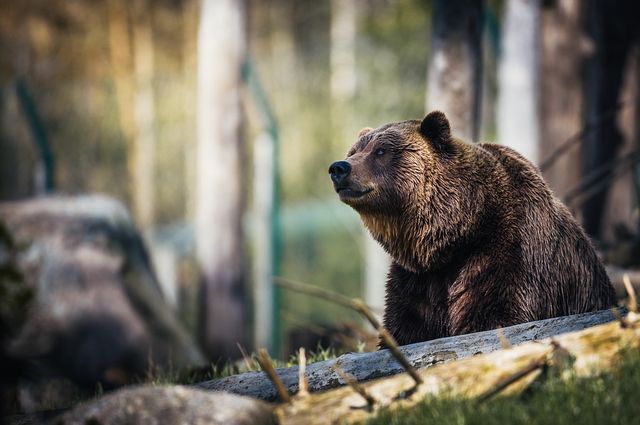
The outdoors is an exciting avenue to relax, sit back, and delight in nature’s wonders and marvellous wildlife.
Our gargantuan planet has every unique flora and fauna for all adventure seekers and animal lovers. And Asia, being the Earth’s largest and most populous continent, is definitely home to a one-of-a-kind wildlife.
People, along with government efforts, have protected Asia’s most well-known National Parks and Reserves to ensure a natural, uninterrupted habitat for these animals.
If you’re thinking of jumping on the next plane to Asia to experience the best wildlife safari of your life – pick from these top 10 best destinations for wildlife safari in Asia and prepare to be awestricken!
1. Cardamom Mountains, Cambodia
You will be dumbfounded by Indochinese tigers, clouded leopards, black bears, wild Asian elephants, and the roster goes on. The Cardamom Mountains wears one of the thickest rainforests in entire Southeast Asia. There are over 450 species of birds and the most unique one is the yellow-bellied warbler.
With so many flora and fauna species dissipating over time, the government and a number of local organisations have worked hand in hand to conserve the area. Efforts against logging, mining, and industrial development have taken place in recent years.
2. Komodo National Park, Indonesia
A country both rich in different cultures and delectable cuisine also boasts the giant lizards or “Komodo Dragons,” as what they’re otherwise known. These stunning giant lizards are only seen on this part of the island.
Although Indonesia is known to have months of downpour in a year; the Komodo National Park is one of the driest regions in the country. The best time to enjoy the beauty of Komodo Dragons is in the months of July and August.
3. Kanha National Park, India
The famous masterpiece, The Jungle Book, authored by Rudyard Kipling was created after this magnificent park. The author was inspired by its evergreen thick forests, meadows, ravines, and Kanha gorges. It is touted as the most picture-perfect wildlife park in Asia.
It is home to more than 200 species of plants and over 70 species of trees. Some of them are Lendia, Saja, Tendu, Palas, Aonla, and bamboo. Some birds are the pintails, pond herons, teals, peafowls, and egrets. While some of the unique animals are the barasingha and swamp deer.
4. Taman Negara National Park, Malaysia
Dive into a world of untouched rainforests and a roster of different wildlife like the rhinoceros, clouded leopards, tigers, Asian elephants, macaques, Chestnut-breasted malkohas, and thorny porcupines.
This destination is absolutely the place for wildlife watching and among some other outdoor activities are hiking and rock climbing. With a vast jungle of 4,343 square kilometres, it’s undoubtedly the largest park in Malaysia. The park encourages self-guided tours and the best season is from July to September.
5. Ba Be National Park, Vietnam
Nature lovers will be allured in the evergreen, lush forests of Ba Be National Park. This place is the country’s eighth national park with one of the lowest human impact. That means the wildlife here is in their natural habitat. The park is also sitting on a bed of limestone-rich soil.
Feast your eyes on animals you rarely see in your lifetime like the Vietnamese Salamander, Tonkin snub-nosed langur monkeys, Chinese pangolins, and red giant flying squirrels. Bats may also make it worth your while as there are as many as 18 varied species in massive caves!
6. Yala National Park, Sri Lanka
If leopards are your thing, prepare to be mesmerised by a myriad of Sri Lankan leopards as this park is a stomping ground for a large number of these animals. Dubbed as one of the largest and most popular parks in the country, there’s no way you should miss this on your next wildlife adventure.
This area is home to 32 species of mammals, 125 species of birds, and a couple of reptiles. Ride a jeep safari tour and you might get lucky and witness a juvenile bull elephant charge at you. But don’t worry, they’re extremely cute and harmless.
7. Umphang Wildlife Sanctuary, Thailand
Inhibited by the Karen people who also act as the tour guides, you can be sure your wildlife experience in this UNESCO-protected sanctuary is as raw and one-of-a-kind as it gets. Because it is located in the remote jungle of Thailand, this area is still not very popular to tourists.
But wait till you get to its most prized treasure – the ThiLor Su Waterfall. A breathtaking scenic view of towering limestone cliffs with powerful flows of water is best when visited from August to October.
8. Shuklaphanta Wildlife Reserve, Nepal
Nestled in the southwestern lowlands and blanketed by the Sal Forest; the Shuklaphanta is a vast and open grassland with a lot of waterholes. This setting is perfect if you want to see animals in their natural habitat drinking from the waterholes through safari tours. At the time of writing, there are only a few facilities for visitors as this area is still off the radar for tourists.
However, the extensive wildlife here is something a great adventure-seeker should never miss. Have a close encounter with the great one-horn rhinoceros, hog deer, barking deer, wild boars, royal Bengal tiger, golden jackals, striped hyenas, and more fascinating animals!
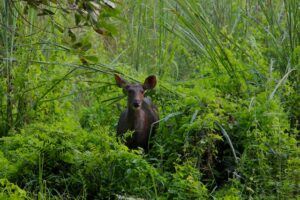
Deer spotted in Nepal’s national park
9. Gir National Park, India
Jeep safaris can definitely make your trip here well worth it in the end. Imagine yourself in an open-roof jeep, with the lions meandering in the background doing their business. This is one of the untouched wildlife areas in India. That’s why registering for a jeep safari still needs permission from the Sinh Sadan Forest Lodge Office. But the whole experience is heart-pumping and overwhelming at the same time.
10. Jigme Dorji National Park, Bhutan
Jigme Dorji National Park with an area of 4,349 square kilometers is the biggest protected area in Bhutan. You can feast your eyes on luscious forests, glaciers, and ice fields! Talk about getting the best of both worlds! The most prominent peaks are Jomolhari, Tsherimgang, and Jichu Drakey.
Different species like the Takin tiger, blue sheep, snow leopard, and red panda will catch you off guard during your wildlife exploration.
If you’re looking to add some fun and adventure in your usual travels, why not try out wildlife safaris instead? The intriguing and beguiling flora and fauna will surely make for an awesome and unforgettable trip!
Author Bio : Sarah Brooks is a passionate travel & outdoor blogger who loves to travel and write about her experience. She spends her free time hiking, swimming, camping and spending time with her family. She also blogs at GearJunior which is a site filled with outdoor tips and guides.
No Comments
Your email address will not be published.

Sustainable Wildlife Tourism in Asia and the Pacific: UNWTO report
May 1, 2020 | News | 0 comments
UN’s World Tourism Organisation last year commissioned Professor Noel Scott (who subcontracted WTA chair Dr Ronda Green as co-editor, with UNWTO’s approval) to put together a report on good practice examples of sustainable wildlife tourism in Asia and the Pacific. After many months that report is now available as a free downloadable pdf. Dr Scott is a WTA member, as are several others who assisted with authoring chapters, reviewing or providing information.
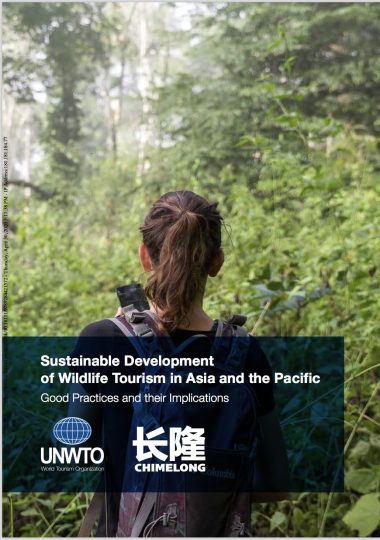
World Tourism Organization and Guangdong Chimelong Group (2020), Sustainable Development of Wildlife Tourism in Asia and the Pacific : Good Practices and the Implications. UNWTO, Madrid, DOI:
https://doi.org/10.18111/9789284421572
Published: April 2020 Pages: 136 eISBN: 978-92-844-2157-2 | ISBN: 978-92-844-2156-5
From their website:
“ Set within the framework of the UNWTO/Chimelong Initiative, this report illustrates 13 good practice cases in wildlife tourism. A further 5 snapshots are examined briefly to illustrate the breadth and importance of wildlife tourism across Asia and the Pacific.
In order to reflect the diversity in both geographical scope and market segment of the sector, a variety of operations were selected including examples from the private sector, the accommodation and transport sectors, as well as from visitor attractions. At the same time, the report offers a range of examples of tourism being used to safeguard habitats and species, both terrestrial and marine.
While the rapid growth of the sector is noted and important components of wildlife tourism are discussed, this report aims to highlight the positive impacts resulting from the implementation of sustainable policies and practices within the wildlife tourism sector in Asia and the Pacific. It examines only non-consumptive forms of wildlife tourism (no hunting, fishing or collecting) and concentrates on the viewing of wild “
Submit a Comment Cancel reply
Recent posts.
- “Wild Tails” Venue -conference 2024, Accommodation and Getting There
- WTTC declaration on Wildlife Trafficking
- Japanese Wildlife Tourism forum
- Wildlife Tourism Workshop Sydney, 20 July
- Australia-Indonesia Tourism Resilience Program
- Encouraging Children to experience Nature
- Photos from WTA Conference 2022
Asia Wildlife Viewing Trips & Safaris
- Start Date Select Month August 2024 September 2024 October 2024 November 2024 December 2024 January 2025 February 2025 March 2025 April 2025 May 2025 June 2025 July 2025 August 2025 September 2025 October 2025 November 2025 December 2025 January 2026 February 2026 March 2026 April 2026 May 2026 June 2026 July 2026 OR, More specific start
- Easy Active
- Challenging
- Food & Wine
- Most Popular
- River Cruises
- Scheduled Group Tour
- Small Ship Cruises
- Solo Travel
- Wildlife & Safari Exploration
- Scuba Diving
- Whale Watching
- Whitewater Rafting
- Wildlife Viewing
- Archaeological Site Visits
- Cooking Classes
- Festival Visits
- Helicopter Tours
- Land & Sea Exploration
- Local Market Visits
- Rainforest Exploration
- Small Ship Sailing
- Spa Relaxation
- Stand Up Paddle Boarding
- Urban Exploration
- Village Visits
- Volunteering
- Wilderness Lodge Exploration
- Aqua Mekong
- Coral Geographer
- Emerald Harmony
- Heritage Adventurer
- Le Jacques Cartier
- Le Laperouse
- National Geographic Orion
- National Geographic Resolution
- Ombak Putih
- Paul Gauguin
- RV Angkor Pandaw
- RV Bassac Pandaw
- RV Champa Pandaw
- RV Indochine
- RV Indochine II
- RV Kalaw Pandaw
- RV Katha Pandaw
- RV Kindat Pandaw
- RV Laos Pandaw
- Scenic Eclipse II
- Scenic Spirit
- Sylvia Earle
Best of Vietnam & Laos
- Cruise Halong Bay
- Explore the streets of Hanoi
- Trek villages near Luang Prabang
- Interact with elephants
Cycling the Red River Delta
- Explore Hanoi's culture and history
- See Vietnam's landscape and valleys
- Visit two largest park in Vietnam
- See the culture in Northern Vietnam
- Visit the Van Long Nature Reserve
- Enjoy cruising in Ha Long Bay
Undiscovered Paradise
- Taste produce of local markets
- Experience healing waters in Tirta
- Travel to Jatiluwih
- Visit Lake Tamblingan
- Bathe in hot springs of Air Panas
- Snorkel around Pemuteran
Laos: North to South
- Visit Luang Prabang with an expert
- Hike the Kuang Sy Waterfalls
- See Nam Ou River and Pak Ou Caves
- Explore Paksong and Bolaven Plateau
- Explore Si Phan Don islands
- Engage with a local family
- See the Vat Phou Temple
- Explore Champassak hidden gem
Hiking Laos and Cambodia
- See the Angkor Wat,
- Discover Phnom Kulen National Park
- Visit Tonle Sap floating village
Mekong Expedition - Siem Reap to Ho Chi Minh
- Visit Prek Toal Core Bird Reserve
- Sail to floating village Chhnok Tru
- See Cambodia's capital & sights
- Meet & interact with locals
Discover Bhutan
- Hike Khamsum Yulley Namgyal Chorten
- Visit a traditional incense maker
- Explore Thimphu
- Hike Tiger's Nest Monastery
Culture & Wildlife Journey of India
- Explore the ruins of Old Delhi
- Ride in 4x4 open safari jeep
- Visit Khajuraho temples
- Witness religious rituals
- Visit Amber Fort in Jaipur
- See Picturesque Taj Mahal
Khao Sok Treasures
- Kayak through the jungle
- Hike Khao Sok National Park
- Stay at a floating ranger station
South Cambodia Escape
- Explore local villages by bicycle
- Relax on secluded beaches
- Visit the famous crab market
- Tour Koh Rong Samloem Island
Mekong Explorer - Siem Reap to Phnom Penh
- Meet and interact with locals
- Attend a Buddhist blessing ceremony
Experience Nepal
- Visit UNESCO sites in Kathmandu
- See monks local way of life
- Visit ancient temples and bazaars
- Explore Pokhara's hidden gems
- Taste authentic local cuisine
- Visit a local NGO project
- See wildlife in Chitwan
- See exotic wildlife while on tour
- Join jungle activities
- Best of Thailand
- Visit Wat Pho, a Buddhist temple
- Wander Damnoen Saduak Market
- Feed and bathe elephants
- Sail around Phang Nga Bay
Borneo Wildlife Safari
- Observe Orangutans
- Embark on a river cruise
- Explore Gomantong Caves
- See endemic birds at Cuckoo Hide
Thai Cultural Discovery
- Tour the Grand Palace
- Peruse the Railway Track Market
- Visit a traditional Lanna family
- Interact with rescued elepants
Best of Nepal
- Discover ancient temples and bazaar
- Visit Phewa lake
- See wildlife and their habitat
Laos in Motion
- Walk among ancient temples
- Meet locals as you bike the Mekong
- Kayak the rapids of the Nam Song
- Hike to see the elusive orchid
SeaTrek The East Indies on a Spice Island Exploration
- Visit Laratuka's unique churches
- Explore the Forgotten Islands
- Snorkel in crystal-clear water
- Discover Indonesia’s Ring of Fire
Asia Travel Guide
- All Asia Trips
- Asia Cruise: When to Go?
- Best Times to Visit Thailand
- Best time to Visit Cambodia
- Asia Luxury Tours
- Mekong River
Favorite Asia All Trips
- Great Wall, Dynasties, & Rivers
- Beautiful Beijing & the Wall
- Vietnam Adventure
- Borneo Hiking & Wildlife Adventure
- Highlights of Cambodia
- Essence of China
Top Asia Travel Destinations
- Myanmar (Burma)
- Russian Far East
- South Korea
Asia Trips by Departure Date
- 2024 Asia trips (210)
- 2025 Asia trips (215)
- 2026 Asia trips (82)
- August 2024 (111)
- September 2024 (149)
- October 2024 (178)
- November 2024 (183)
- December 2024 (163)
- January 2025 (147)
- February 2025 (144)
- March 2025 (145)
- April 2025 (133)
Top Experiences in Asia
- Asia Cruises (121)
- Asia Land Tours (104)
- Asia Cultural (98)
- Asia Small Ship Cruises (92)
- Asia River Cruises (60)
- Asia Luxury (36)
- Asia Beaches (29)
- Asia Active (27)
- Asia Wildlife & Safari Exploration (23)
- Asia Trekking (21)
- Asia Most Popular (9)
- Asia Scheduled Group Tour (8)
- Asia Family (6)
- Asia Food & Wine (5)
Asia Trips by Duration
- 5 day trips (28)
- 6 day trips (8)
- 7 day trips (9)
- 8 day trips (31)
- 9 day trips (13)
- 10 day trips (16)
- 11 day trips (16)
- 12 day trips (19)
- 13 day trips (14)
- 14 day trips (11)
- 15 day trips (11)
- 16 day trips (9)
- 17 day trips (7)
- 19 day trips (3)
- 25 day trips (3)
Asia Trips by Activity
- Asia village visits (157)
- Asia local market visits (117)
- Asia wildlife viewing (87)
- Asia snorkeling (57)
- Asia archaeological site visits (56)
- Asia hiking (47)
- Asia urban exploration (40)
- Asia kayaking (32)
- Asia biking (31)
- Asia cooking classes (29)
- Asia wilderness lodge exploration (23)
- Asia rainforest exploration (20)
- Asia stand up paddle boarding (13)
- Asia homestays (13)
- Asia land & sea exploration (11)
- Asia spa relaxation (10)
- Asia camping (5)
- Asia whale watching (4)
- Asia scuba diving (3)
- Asia volunteering (3)
Why Travel With Adventure Life
Recognized by.

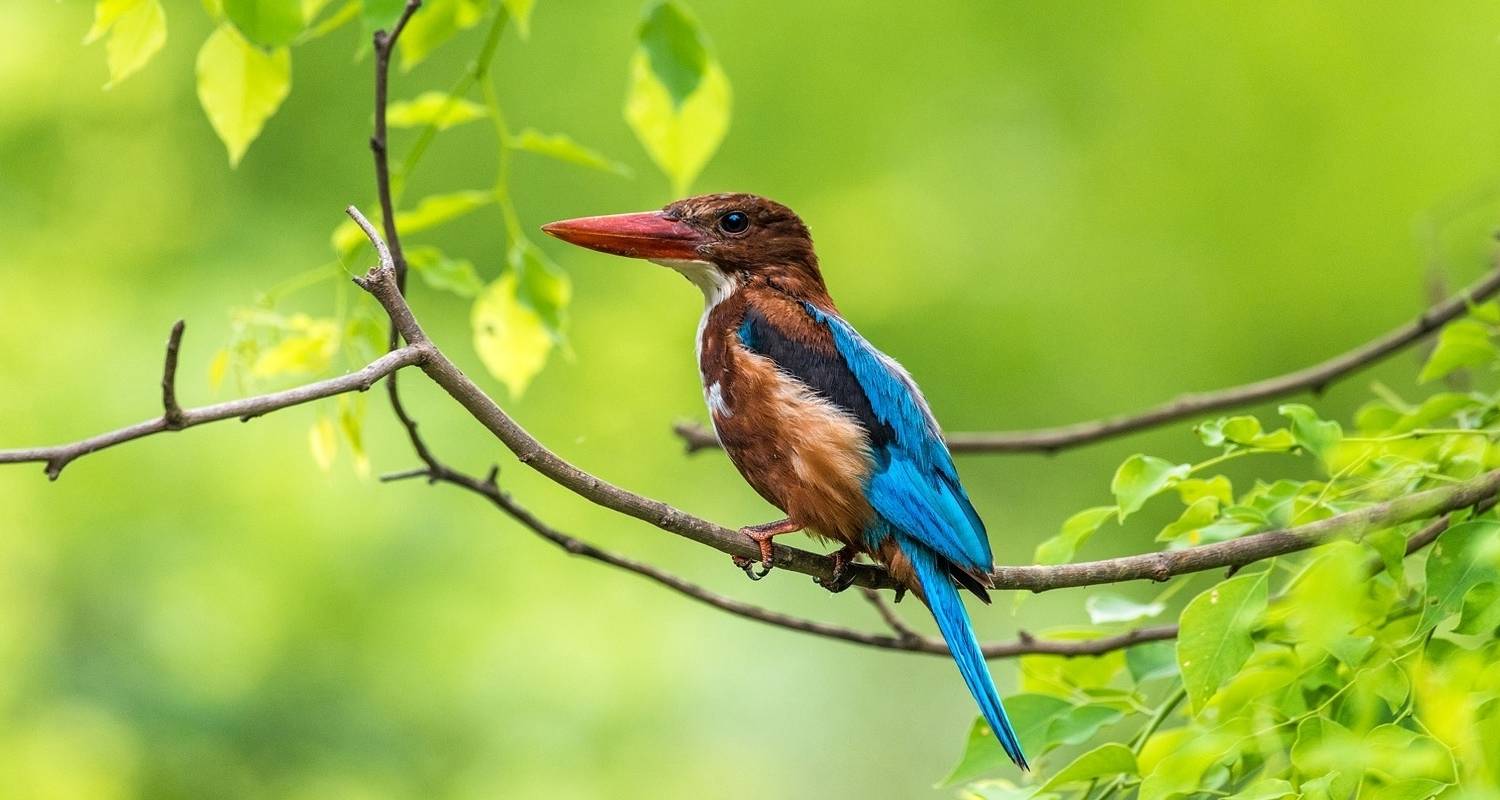
Wildlife Tours in Asia
- Choose from 400+ Asia tours
- 2,900+ verified reviews from TourRadar travelers
- 24/7 customer support
10 best Asia wildlife tour packages
Compiled by

Steff Asia travel expert at TourRadar
India Tiger Safari Tour
Golden triangle tour with ranthambhore national park - all inclusive, india wildlife with taj mahal tour, india's best wildlife tour, wild about sri lanka - 10 days, grand tour of sri lanka, 2 night 3 days chitwan jungle safari tour package, taj mahal and wildlife with royal stay at castles, elephants of sri lanka - 15 days, india wildlife safari - asiatic lions with the bengal tigers.
“The different national parks and modes of transportation were well arranged. The food was excellent and the tigers awesome.” Pushpa SK Nair, traveled in February 2024
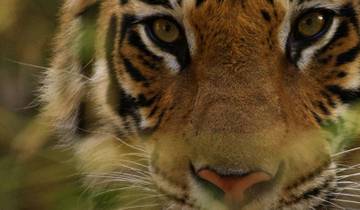
- Christmas & New Year
- Visit the ancient Ranthambore Fort
- Spot elusive tigers on multiple jungle safaris
- Explore Ranthambore's royal hunting grounds
“It was really wonderful experience of India tour. All guides did wonderful job.” Garcia, traveled in May 2023
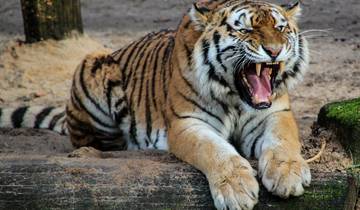
- Visit the majestic Agra Fort and Fatehpur Sikri
- Witness the sunset over the Taj Mahal in Agra
- Spot tigers on a Ranthambore safari adventure
“The two national parks were both excellent. We would definitely recommend this tour.” Matthew Dodd, traveled in February 2024

- Explore the iconic Taj Mahal at sunrise
- Tour the majestic Agra Fort and its palaces
- Experience a thrilling safari in Bandhavgarh
“Excellent tour of India we were quite happy with all services that are provided to us in india.” morin, traveled in February 2019
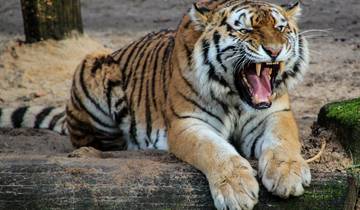
- Witness the spiritual Ganga Aarti on Varanasi's ghats
- Explore the historic Red Fort and bustling Chandni Chowk
- Spot tigers on a safari in Bandhavgarh National Park
“This trip has been absolutely brilliant! I would definitely recommend this tour to anyone!” Sofia Cobo de Guzman Dominguez, traveled in October 2019

- Go wild in Sri Lanka animal spotting in Yala, Udawalawe and Bandula national parks
- Embark on a scenic train ride through waterfalls and tea plantations to Nuwara Eliya
- Visit the nation's largest herd of Asian Elephants at Udawalawe National Park
“the itinerary was amazing and exactly as described, but nothing could have prepared us for both the splendour of the countryside and the overall friendliness of everyone we met on the trip.” Paul Harrison, traveled in July 2024

- Witness elephants at Minneriya Park
- Spot leopards at Yala National Park
- Relax on Negombo's golden beaches
“The hotel (seven star) was also very nice and the lovely lady in the restaurant took really good care of me.” Jamie Hallifax, traveled in March 2019

- Venture from the mountains to tropical jungles.
- Cruise on waters to find endangered crocodiles.
- Explore the wildlife-rich jungle by dugout canoe.
“The accommodations were top-notch, and the driver and guides were incredibly knowledgeable and professional.” Sean Burrows, traveled in July 2024

- Sightseeing
- Visit the Amber Fort in Jaipur and the palace in Udaipur
- See cheetahs, panthers and tigers on an incredible safari
- Fall in love with the sights, sounds and tastes of India
“Their dedication to ensuring your safety, trustworthiness, and overall satisfaction is unparalleled.” Delia Maggio, traveled in October 2023
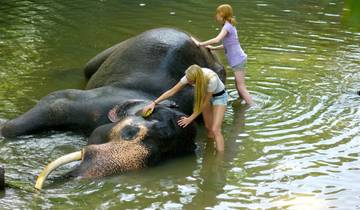
- Marvel in the architectural masterpiece of the Temple of the Tooth
- Keep your eyes peeled on game drives of Minneriya Wildlife Sanctuary
- Bask in the panoramic views from the top of the Sigiriya Lion Rock
“The trip was fabulous and well managed. These guys are amazing, and I can easily recommend the company.” Debra Giles, traveled in February 2020
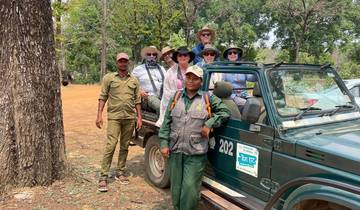
- Discover 'The Jungle Book' inspirations in Kanha
- Watch exotic birds in Bandhavgarh National Park
- Spot Asiatic Lions on a Gir Park safari
Travel Styles
Discover TourRadar

- South Africa
- The Ultimate Safari Planning Guide
- Safari Packing List
- Safari Luggage
- Safari Budget Guide
- Safari Reading List
- First-Timer’s Tips
- A Typical Day on Safari
Wildlife Travel In Asia
Though maybe not the most well known wildlife travel destination, Asia offers plenty of opportunities for animal lovers to spot wildlife in their natural habitats.
In Asia, you can explore jungles and rainforests on foot in search of primates and reptiles, while national parks make it possible to see big cats and Asian elephants in the wild from the comfort of jeeps and canters. The warm waters around Asia also give wonderful opportunities to spot whales and marine life on water safaris.
Asia wildlife holidays are as varied as the landscapes and habitats available on the continent, making it one of the most beautiful places in the world to spot animals.
Explore the guides below to find out more about the wildlife tourism available in Asia.
Asian Wildlife Destinations

Home to the world’s largest surviving population of tigers, India should feature on any wildlife lover’s bucket list. But that’s not the only reason why: this majestic animal shares its habitat with countless other species, including bears, elephants, leopards and monkeys. India’s vast national parks are spectacular, ranging from dense forests and jungles to mountains.

What Sri Lanka lacks in size, it certainly makes up for in beauty, warmth and, of course, places to see wildlife. The jungles and national parks of the teardrop island are a beautiful setting in which to spot elephants, monkeys and exotic bird life. If you’re really lucky, you may even come across a Sri Lankan leopard that, while being common, remains very elusive.
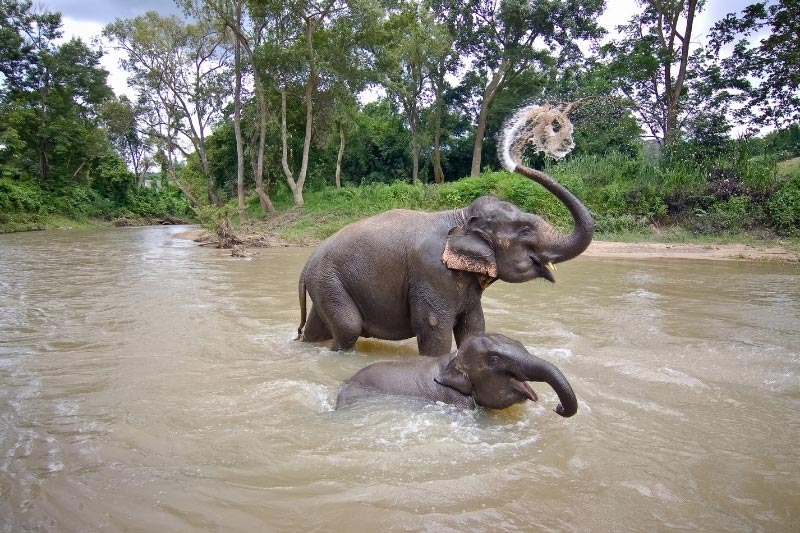
Thailand is a wildlife lover’s paradise. The jungles and rainforests of the north are home to dwindling numbers of wild elephants, while gibbons, geckos and various species of snake also call Thailand home. The waters around Thailand are studded with manta rays and whale sharks, meaning you’re never far from the wild when relaxing on a Thai island.

China’s vast size makes it large enough to cover a wide range of habitats, suitable for pandas to feast on bamboo in the forests of the southern and eastern provinces, as well as the dry, rocky mountain ranges that are cold enough to house snow leopards. China is also home to a large variety of other big cats, primates, ungulates and deer. You just need to know where to look!

As a tiny city state, you would be forgiven for believing there wouldn’t be much to see in terms of wildlife in Singapore. But, outside of the main urban sprawl, in the island’s nature reserves you’ll find a surprisingly diverse array of wildlife. Mammals including macaques and langurs roam the tree tops while snakes and lizards hunt for food along forest floors.

The National Parks and wildlife reserves of Nepal are just as spectacular as its mountains. In this part of Asia, you’ll find a huge variety of animal species including tigers, snow leopards, clouded leopards, foxes, elephants, rhinos, red pandas and pangolins. And that’s just the start! The diversity of flora, fauna and habitat in Nepal makes it one of the best places to see wildlife in Asia.
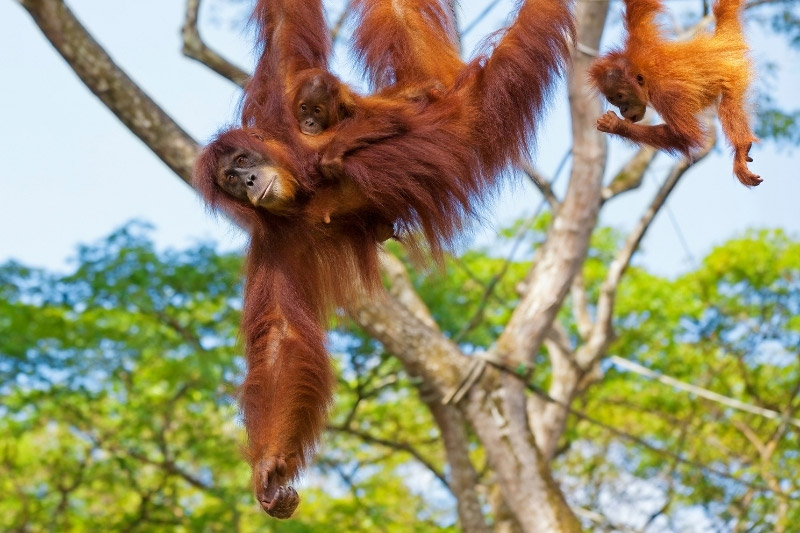
The southeast Asian island of Borneo is famous for its population of orangutans that swing through the tree canopies like something straight out of The Jungle Book. The tropical climate and habitat make an ideal home for a wide variety of wildlife, such as amphibians, reptiles, birds and primates as well as larger mammals including rhinos and elephants.

With most of the country covered in some of the world’s best rainforests, mainland Malaysia is a great place to see animals in the wild. The incredible list of predators calling Malaysia home include two species of tiger, two species of leopard as well as the sunbear. River safaris of the wetlands and mangroves of Taman Negara National Park are a unique way to spot impressive birdlife.

Japan’s bustling cities may make it an unlikely wildlife destination in Asia, but it is a deserving one. The best animal encounters here happen in winter, with opportunities to spot Japanese macaques warming themselves in hot springs, and Japanese cranes dancing in the snow. The rest of the year, the wetlands of Yatsu-Higata are a fantastic place to see migratory birds.
Asian Wildlife & Animals
Asian animals are as diverse as the habitats they live in.
The big cats that call Asia home are plentiful enough to rival Africa , with the addition of tigers, snow leopards and clouded leopards thrown in for good measure. But that’s not all – a huge variety of unique mammals, birds, reptiles and marine life live in Asia, making wildlife holidays more worthwhile than you may have previously thought.

The villain of the Jungle Book but the hero of a safari in Asia is the majestic tiger. Nothing can quite prepare you for your first sighting of their bright orange and black stripes peeking out through the undergrowth. Though their numbers are growing, you still need to be lucky to spot a tiger in the wild .
Giant Panda

The poster child for wildlife conservation, giant pandas are growing increasingly rare to see in the wild. But that’s what makes sightings of these adorable black and white creatures even more special. They live in the mountain ranges of China, and their diet mostly consists of bamboo shoots – up to 14kg of bamboo per day!
Snow Leopard

Though snow leopards are shy and reclusive, Asia is the only place you might spot them in their natural habitat. These big cats are covered in thick grey fur with black spots provide camouflage and also protect them from the harsh climates they live in across Asia’s highest mountain ranges.
Latest Asia Blog Posts

Where to See Tigers in the Wild
Tigers are some of the most beautiful creatures in the world, and seeing one in | Read more...
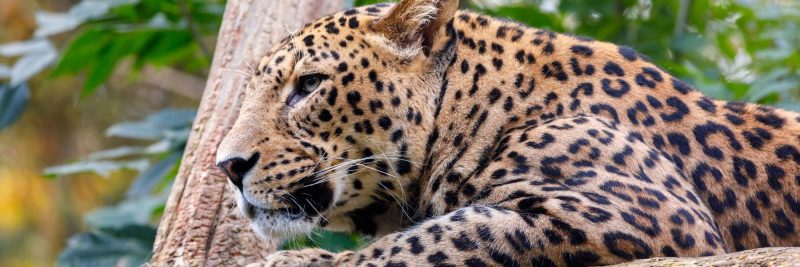
Where to See Leopards in Sri Lanka
If you’re a wildlife enthusiast, nature lover, or simply an adventure seeker, then Sri Lanka | Read more...
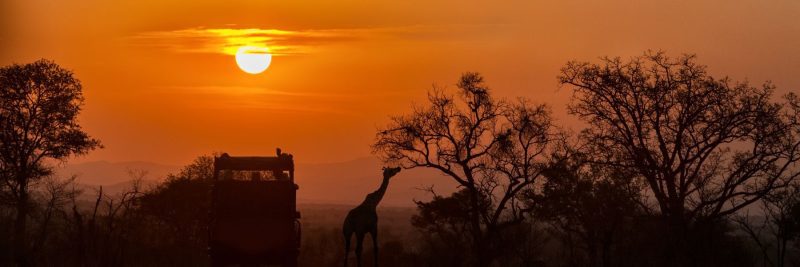
What is a Safari?
When we think of safaris, we often picture vast open savannahs, majestic wild animals, and | Read more...
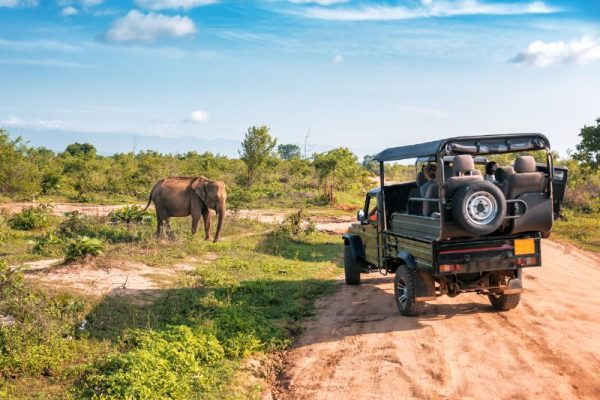
Sri Lanka Safari Planning Guide
Welcome to Sri Lanka, a tropical paradise known for its rich culture, stunning landscapes, and | Read more...

Ranthambore Travel Guide
Discover everything you need to know about seeing Indian animals in the wild in this | Read more...

Animals in India
When you imagine animals in India, you’ll likely remember the Bengal tiger and even the | Read more...
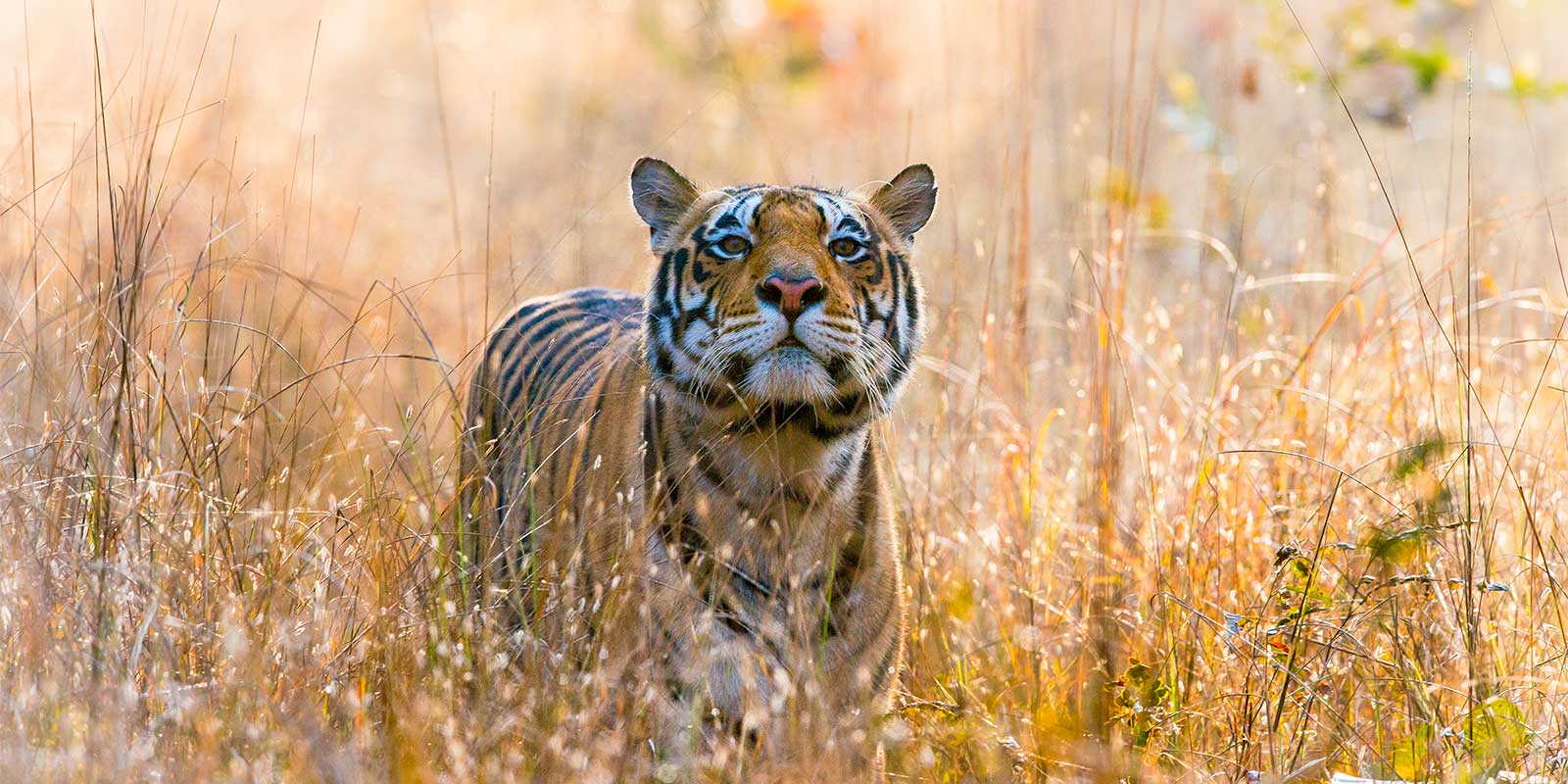
Destinations
Asia, the world's largest continent, is known for its diverse culture, coupled with exciting wildlife, from big cats to iconic great apes, as well as a plethora of fascinating birdlife in a wide range of habitats.

Lying at the crossroads of Europe and Asia, Armenia has fallen under rulering powers including Byzantine, Ottoman and Russian, resulting in a complex and rich history and culture. Christianity reached the country in 40AD, and its superb medieval monasteries are one of its key cultural attractions. Find Out More about Armenia
- Dilijan National Park

Borneo is one of the worlds great biodiversity hotspots. Malaysian Sabah and Sarawak diverse habitats support an array of intriguing flora and fauna. Ten hectares of rainforest here contain more tree species than all of North America; there are more bird species than in Europe, and as many mammals as in Australia. Find Out More about Borneo
- Bako National Park
- Danum Valley
- Deramakot Forest Reserve
- Gomantong Caves & Forest Reserve
- View 11 wildlife locations in Borneo

China is the third most biodiverse country on Earth, and is home to one of the world’s most endangered species - the giant panda. Despite also being the most populous country, China’s nature reserves teem with wildlife, with more than 550 species of mammals and an impressive 1,400 species of birds. Find Out More about China
- Labahe Nature Reserve
- Tangjiahe Nature Reserve

India is an eclectic mix of old and new, and there are few places which stir people’s emotions to the same degree. Its wildlife is in a class of its own, and many superb lodges and camps are located close to key wildlife reserves whose naturalist guides will enhance any visit and ensure a rewarding experience. Find Out More about India
- Anamalai Tiger Reserve (previously Indira Ghandi NP)
- Bandhavgarh National Park
- Bandipur National Park
- Bharatpur (Keoladeo Ghana National Park)
- View 33 wildlife locations in India

The country of Indonesia is an archipelago comprised of 17,000 islands and it is one of the world’s most undiscovered wildlife destinations. From the smallest primate on the planet - the spectral tarsier - to orangutans and Komodo dragons, the islands of Indonesia have an intriguing mix of wildlife. Find Out More about Indonesia
- Gunung Leuser National Park
- Komodo National Park
- Tangkoko National Park

An archipelago of over 7,000 islands, Japan’s wildlife and landscape are incredibly diverse. In the winter months, the northerly island of Hokkaido plays host to dancing Japanese cranes and huge Steller’s sea eagles, whilst the snow covered hills of the Japanese Alps are the abode of hot spring bathing Japanese macaques. Find Out More about Japan
- Jigokudani Monkey Park (Hell’s Valley)

Mongolia is the epitome of wildness. In the south lies the Gobi Desert, last haunt of the wild Bactrian camel. In the east, great steppes hold huge herds of Mongolian gazelles. The far west is stony semi-desert, stretching up into the Altai Mountains. In the north, towards Russia, there is taiga. Find Out More about Mongolia
- Eastern Mongolian Steppes
- Hustai National Park
- Khovd Region

At the heart of the Himalayas, overlooked by the world’s highest mountains, Nepal is a truly spectacular country with a rich blend of Buddhist and Hindu culture and a remarkably diverse range of habitat stretching from snow-capped mountains to low-lying forest, which give rise to an exceptional variety of birds and mammals Find Out More about Nepal
- Bardia National Park
- Chitwan National Park
- Koshi Tappu Wildlife Reserve
- Singalila National Park

Russia, the largest country in the world, stretches for 8000 kilometres from the Baltic Sea right across Northern Asia to the shores of the Pacific. Covering a staggering nine time zones, this immense area boasts a wide range of natural environments, ethnic peoples, and flora and fauna. Find Out More about Russia
- Commander Islands
- Wrangel Island

Sri Lanka’s national parks and diverse habitats are enhanced by the ruined cities of ancient dynasties. It has a sizeable leopard population, large herds of elephant and numerous endemic birds – creating a birdwatchers paradise, and its coastal waters have earned it a reputation as being one of the worlds best for whale watching. Find Out More about Sri Lanka
- Bundala, Lewaya & Kalametiya Reserves
- Kandy & Udawattakele Forest Reserve
- Kumana National Park
- View 12 wildlife locations in Sri Lanka

Taiwan has beautiful landscapes, friendly people, fascinating culture and delicious food. Its excellent infrastructure and variety of habitats, all within easy travelling distance, and superb birdlife combined with comfortable accommodation, make it a wonderful place to visit. Find Out More about Taiwan
- Alishan National Scenic Area
- Dasyueshan Forest Recreation Area

Famed for its white sand beaches and temples, there's far more to discover in the biodiverse country of Thailand. The home of an extraordinary range of rainforest mammals, birds and reptiles as well as a surprisingly rich marine life including Eden's whale and irrawaddy dolphin. Find Out More about Thailand
- Gulf of Thailand
Sign Up For E-News
Sign up to get the latest on our holidays, offers and events. We generally send two to three e-newsletters per month.

Latest brochure
- Order a printed copy if you live in the UK.
- View or download it if you live outside the UK.

- Wildlife travel experts
- Tailor-made specialists
- Small group holidays
- 100% financial protection
- 100% independent
- 24 hour on-call support
- Finest wildlife destinations
- Personalised travel services
- Expert wildlife guides
- Finest wildlife accommodation
- Supporter of wildlife charities
- Leading our industry
- Investor in local communities
- The most responsible overseas partners
Discover our other holiday experiences
Wildlife Worldwide is a brand of The Natural Travel Collection Ltd , Long Barn South , Sutton Manor Farm , Bishop’s Sutton , Alresford , Hampshire , SO24 0AA , UK .
Your financial protection is guaranteed by ABTOT and ATOL (number 10544) when you book with us .
- ©2024 The Natural Travel Collection Ltd, all rights reserved
- Terms of use

9 Must-Visit Wildlife Destinations in South East Asia
From the islands of the Sunda Shelf to the tropical rainforests of Thailand, Southeast Asia is a region of extraordinary biodiversity. The boom in nature tourism over the past decade bears ample testimony to the fact that humans are flocking to national parks and reserves in growing numbers in their quest for adventure and seeking other natural treasures, mainly in this part of the world.
We have therefore handpicked some of the best wildlife destinations in South East Asia for you to visit, which you might not be lucky enough to see should you pass them off for another day.
Top Wildlife Destinations in South East Asia
Even though South East Asia is not as popular for big cat sightings and tours , it is a mecca for small wild cats, spectacular birdlife, primates, and unadulterated beauty.
Bako National Park – Sarawak, Malaysia

Covering an area of around 2742 hectares, Bako is the oldest national park of Sarawak . A well-maintained network of trekking trails offers visitors the perfect introduction to a rainforest environment, complete with thick vegetation, abundant wildlife, pristine beaches, and exotic birdlife.
Located just 37 km away from Kuching, getting access to the park by boat over the South China Sea is an attraction in itself. The major draw at Bako is the unique faced Proboscis monkey, which is endemic to Borneo.
Kui Buri National Park – Thailand

The vast Kuri Buri National Park is located in Southern Thailand and is known for its dense forests, limestone cliffs, hidden lakes, and deep valleys. This pristine habitat holds an array of diverse wildlife ranging from, Asian elephant, leopard, golden jackal, and the Langur primates. The park also holds a healthy population of wild cattle which includes the largest bovine species the gaur bison and the banteng.
Ba Be National Park – Vietnam

Located in the province of Bac Kan, roughly 240 km north of Hanoi, the Ba Be National Park got its name from the Ba Be freshwater lake which lies within its boundaries. The scenic lake is the largest of its kind in the country and is surrounded by lowland forests. More than 65 species of mammals have made this park their home, among them being the Asian black bear, Chinese pangolin, slow loris and as many as 28 different kinds of bats. A staggering 350 species of butterflies and more than 200 bird types like, the Oriental Honey Buzzard and the majestic Crested Serpent Eagle can be found here.
Kinabalu National Park – Borneo

A UNESCO World Heritage Site and the first and premier National Park of Malaysia, Kinabalu has got its origin from the 4095 m high Mt. Kinabalu, the highest peak in Borneo. The park holds an astounding 4500 species of flora and fauna ( with a majority of them being endemic), thereby making it a virtual mecca for nature lovers. The park area forms the prime habitat of the most sought after Proboscis monkey and the Bornean orangutan. Other primates which can be spotted here are tarsiers and gibbons. This important biological site, has four distinct climate zones, covering an area of 754 square kilometers.
Nakai Nam Theun National Biodiversity Area – Laos

Out of all the twenty-one protected areas in Laos, Nakai Nam has attracted the most attention. This massive zone of pristine wilderness covers a major part of the Annamite mountain range as well as the Nakai plateau. There are a wide variety of mammals which can be found here but the stars of the park are the rainbow headed snake and the blue spotted cave gecko which were only discovered as late as 2015. Other wildlife which dwells in the park are the highly endangered Indochinese tigers, Javan rhinoceros, saola, and the giant muntjac.
Komodo National Park – Indonesia

Home to the world’s largest lizard, the UNESCO World Heritage Site of Komodo National Park needs no introduction to wildlife enthusiasts the world over. Also referred to as the Komodo dragons, these gigantic reptiles can only be found on the island of Flores, Rinca, and Padar apart from Komodo itself. These scaly creatures can measure up to three meters and weigh as much as 70 kg and are the major showpiece of the park. Marine life which can also be seen here are manta rays, sea horses, sharks, dolphins, and turtles. The park is spread over an area of 1733 square kilometers, covering the islands of Komodo, Padar, and Rinca. If you happen to visit Komodo, also check out other fun things to do in Labuan Bajo .
Cardamom Mountains – Cambodia

Thanks to the efforts of the Cambodian Government, more than four and a half million hectares of prime rainforest region was protected to create an ultimate wildlife corridor in 2016. The formation of the Southern Cardamom National Park, today serves as an excellent habitat for the Asian elephant, apart from many other endangered species. Other animals to be found here include the Indochinese tiger, Malayan sun bears, clouded leopards, and Asiatic black bear. The region still holds thousands of yet undiscovered flora and fauna which may disappear from the face of the planet if conservation efforts are not made in real earnest.
Taman Negara National Park – Malaysia

This spectacular National Park was formed due to the constant efforts of the Government to preserve the prized wildlife of the country. Taman Negara, is the biggest National Park of Malaysia and is home to one of the oldest rainforests in the world. While wildlife spotting in this untouched primary region is not easy, visitors visit here in large numbers in an attempt to spot the Asian elephant, clouded leopard, rhinoceros or the elusive tiger. The park is also the setting for the longest canopy walkway in the world . Getting a glimpse of primates is rather easier, with frequent sightings of the funny looking dusky leaf monkey and the spectacled langur. The 4345 square kilometers park has a wide range of bird life, with the great hornbill occupying the pride of place not only in tribal rituals but for birding enthusiasts as well.
Tarsier Sanctuary – Corella, Philippines

The palm-sized tarsiers are considered to be the tiniest of all primates to be found anywhere else in the world. Often targeted as pets because of their cuteness, the tarsiers are now deemed vulnerable and get protection from the local government. Tarsiers can be easily located with the assistance of guides and rangers in this sanctuary as they favor certain positions and spots on the trees. The sight of them clinging to the branches with their huge fingers and their stares with the bulging eyes is a sight to behold. So if you want a great photo with these adorable creatures, the Tarsier sanctuary on the island of Bohol is the place to find them.
Southeast Asia is home to some of the densest rainforests, teeming with a variety of wildlife. Most of this rich habitat consists of the last remaining abodes for a number of vulnerable animals which include the Indochinese tiger, clouded leopard, and the Asian elephant. Scientific studies have revealed that the forests of Southeast Asia are home to, a yet to be discovered, thousands of species of flora and fauna. Despite valiant conservation efforts, there is every chance that these important discoveries may never see the light of the day. Most of the wildlife destinations in South East Asia cover a diverse type of landscape which harbors wildlife in abundance. The ones selected here, stand apart from the others, due to their environment and uniqueness.
- Recent Posts
- A Pair of Pelicans at Jawai Bandh , Rajasthan - August 26, 2024
- From eSIM to IoT: The Technologies Transforming Travel in 2024 - August 22, 2024
- Monitor Lizard in Ranthambore National Park - August 17, 2024
Related Posts
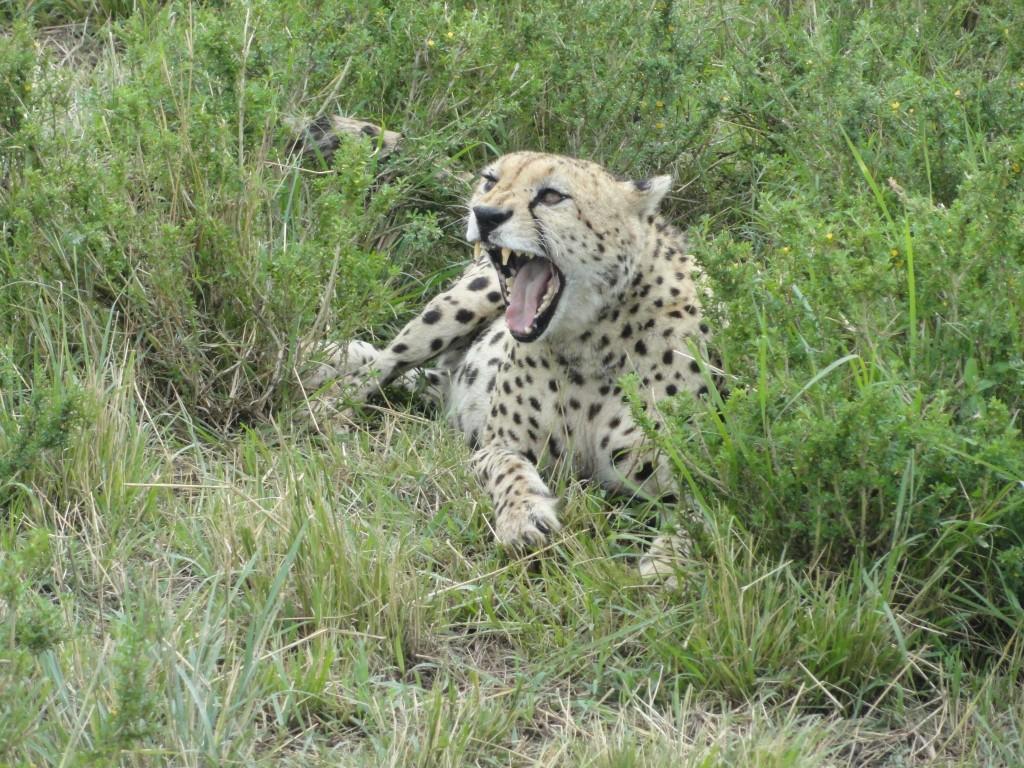
To Kenya, With Love

River Tubing in Vang Vieng, Laos
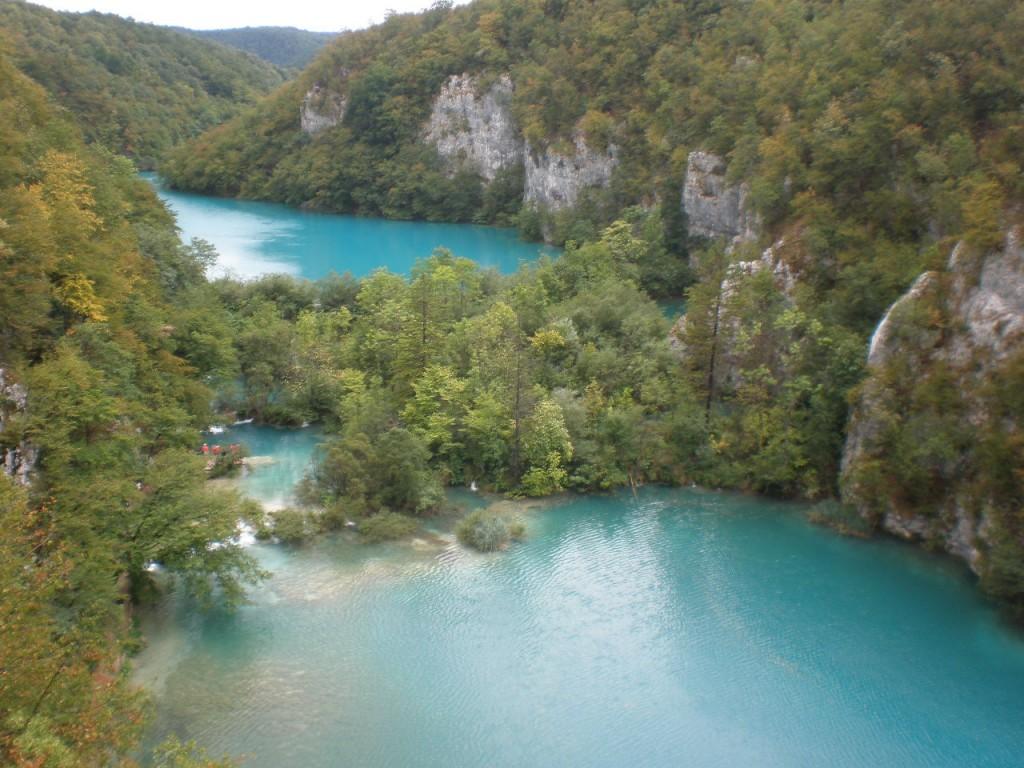
Two Days In Plitvicka Jezera National Park, Croatia
2 thoughts on “9 must-visit wildlife destinations in south east asia”.
In Kinabalu NP there are no Orang Utans or Probosic Monkeys….
Hi Chris, this is interesting. I am reading online that organutas are spotted at high elevations in the park and now there was a recent record of Proboscis too – https://www.researchgate.net/publication/281524602_A_record_of_Proboscis_Monkey_Nasalis_larvatus_Mammalia_Primates_Cercopithecidae_from_Kinabalu_National_Park_East_Malaysia_Sabah – but you are right they arent common in Kinabalu.
Leave a Comment Cancel Reply
Your email address will not be published. Required fields are marked *
Start typing and press enter to search

The Best Wildlife Adventures in Asia
Long a source of fascination and camaraderie for humans, animals — both domesticated and in the wild — humble us, teach us,and transform us. Just ask any pet owner what they feel when they look into the eyes of a beloved cat or adored dog, and they’ll likely describe it as a soulful bond, a connection that goes beneath the layers. Beneficial to our health, pets have been lauded in untold medical studies for positively lowering our blood pressure, fending off depression, giving us purpose, promoting selflessness, and teaching us to love unconditionally. But the benefits don’t just happen at home. Animals in the wild also positively affect us. They awaken compassion, spark curiosity, and open our hearts — a triad that stands as the centerpiece for transformational traveling, a vacation trend focused on making life (and trips) more meaningful and helping to shift us to a new place.
I’ve bathed and fed elephants in Thailand , gazed upon tigers in India , had my mood lightened by pandas in China, been enthralled by naughty monkeys in Bali, and gazed at leopards in Sri Lanka — among other amazing encounters in Asia. Below find life-changing adventures, each sure to open your heart, make you smile, and connect you to the universe.
Black Necked Cranes in Bhutan
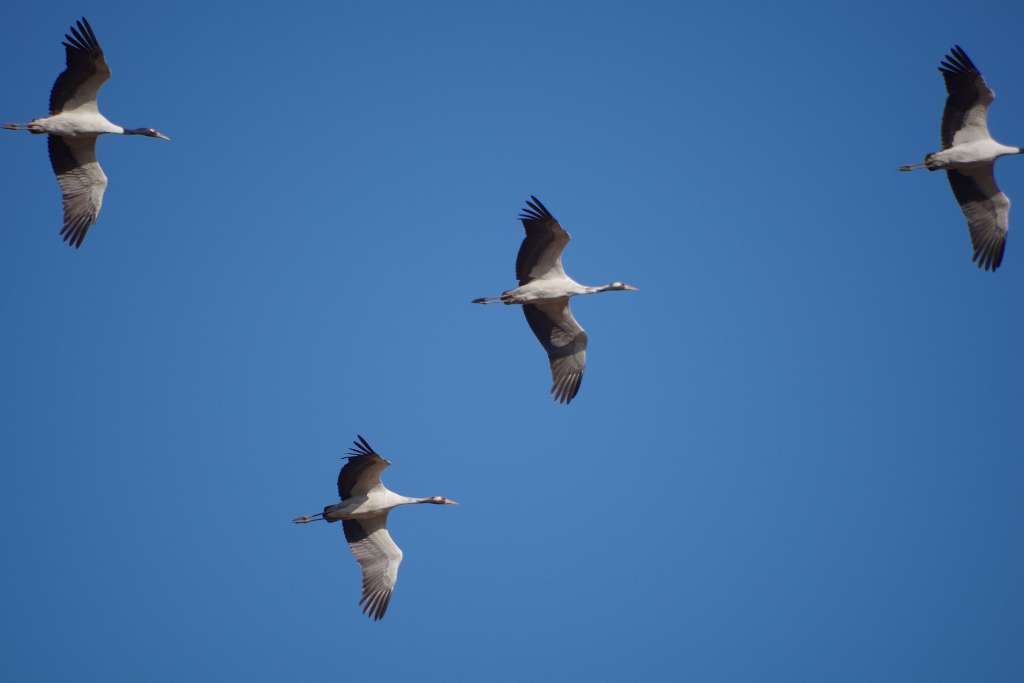
Vibrant, exotic Bhutan was the last country on earth to introduce television. Maybe that’s because they had the seasonal opportunity to be entertained instead by the endangered Black Necked Cranes who occupy the remote, tiny kingdom from October to mid-March each year. Check into Gangtey Lodge , a Small Luxury Hotels of the World member inspired by the vibe of a Bhutanese farmhouse. The hotel, hovering above the Phobjikha (Gangtey) Valley, offers a variety of programs to immerse guests into the uniqueness of Bhutan , including the opportunity to gaze upon these special birds, revered as a local symbol of longevity. Take note of their large size, bright red crown, and coal black neck, then yield to Gangtey’s traditional Bhutanese hot stone bath to seal your successful bird-watching day.
Proboscis Monkeys in Borneo
Further flung, Borneo with its swampy coastline and mangrove forests reigns as one of the most biodiverse spots on earth. It brandishes some 15,000 plant species, not to mention orangutans and proboscis monkeys in an expanse that ranks as the world’s third largest island. Stay within the protected Abdul Rahman Marine Park at Gaya Island Resort , where guests can hike the Proboscis Monkey Jungle Trail deep into the rainforest. Winding through an area that remains the domain of approximately 100 captivating, distinctively long-nosed proboscis monkeys, the trail passes through tangles of vines and beside colossal trees to an observation platform ideal for monkey spotting. Save time for the Mangrove Kayak Tour as well, where you’ll paddle through a 100-year-old forest to spot crabs, lizards, birds, and more.
Tigers in India
Approximately 100 endangered tigers roam the brushy woodland of India’s Ranthambhore National Park , a reserve in colorful Rajasthan. By far the best way to catch a life-changing glimpse of one in the wild is to join a Micato Safaris trip through India, While you may see pepper growing in Kerala or ride a boat on Udaipur’s fairytale lake on this once-in-a-lifetime Indian tour, your highlight will be a stay at Oberoi Vanyavilas Wildlife Resort with your knowledgeable Micato guide for an astonishing tiger expedition. For several days, you’ll not only study tigers at the resort, but take twice-daily game drives through the park.
Elephants in Thailand
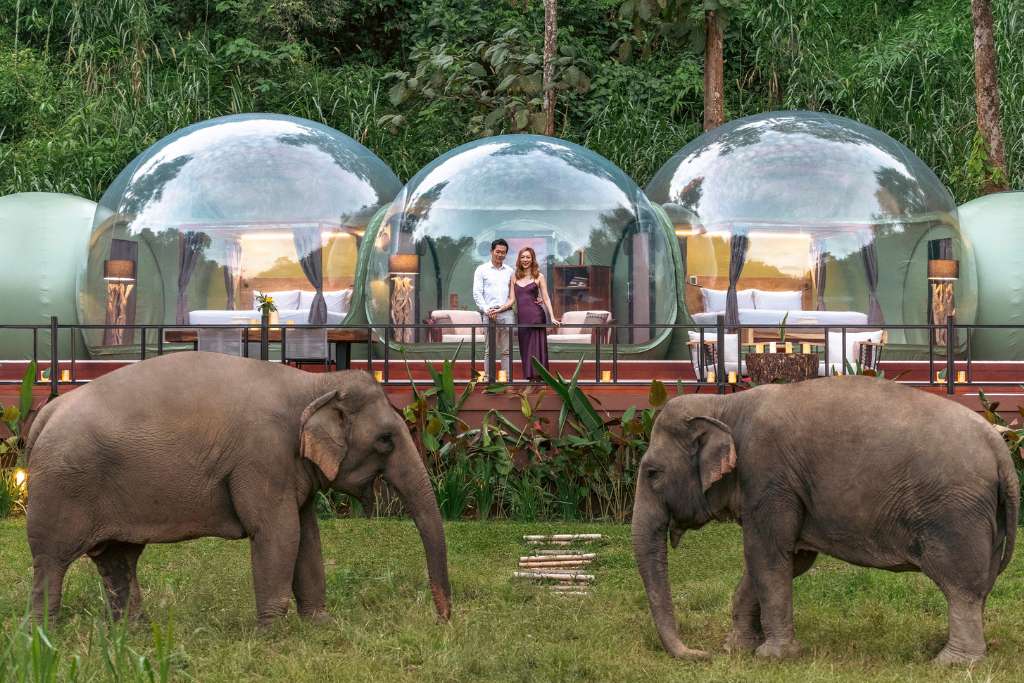
Highly social, elephants communicate by vibrations which they can decipher from miles away. Immensely intelligent, they can recognize themselves in a mirror. As plant eaters, they munch constantly to maintain their girth — and their everlastingly long eyelashes will make you green with envy. Get to know these magnificent creatures at Anantara Golden Triangle Elephant Camp & Resort , a sanctuary for rescued pachyderms in the bamboo forests of far northern Thailand near Chiang Rai. An award-winning eco-resort, the retreat offers manifold ways to gadabout with “ellies,” including bathing them, feeding them, walking with them, and watching them from the transparent walls of your Jungle Bubble, a suite with see-through walls.
Monkeys in Bali
Evocative Bali conjures images of sun-drenched beaches, yoga shalas, emerald-green rice paddies, be-flowered trees, mysticism, and hedonism. An Indonesian haven once the retreat for Arab and Indian spice traders, Bali has earned its arresting romantic reputation. Get to know the long-tailed macaque monkeys, the isle’s friskiest and most mischievous inhabitants at the Ubud Monkey Forest. The concierge team at Viceroy Bali , a 40-room villa retreat in the Valley of the Kings, can reserve tours to explore Wenara Wana, (the Ubud Monkey Forest) also home to Padangtegal’s Pura Dalem or temple of the dead. Let its troop of some 600 monkeys amuse and delight you with their antics and festive play. One word of caution: hold onto your glasses. The monkeys have a penchant for collecting spectacles and other shiny objects.
Leopards in Sri Lanka
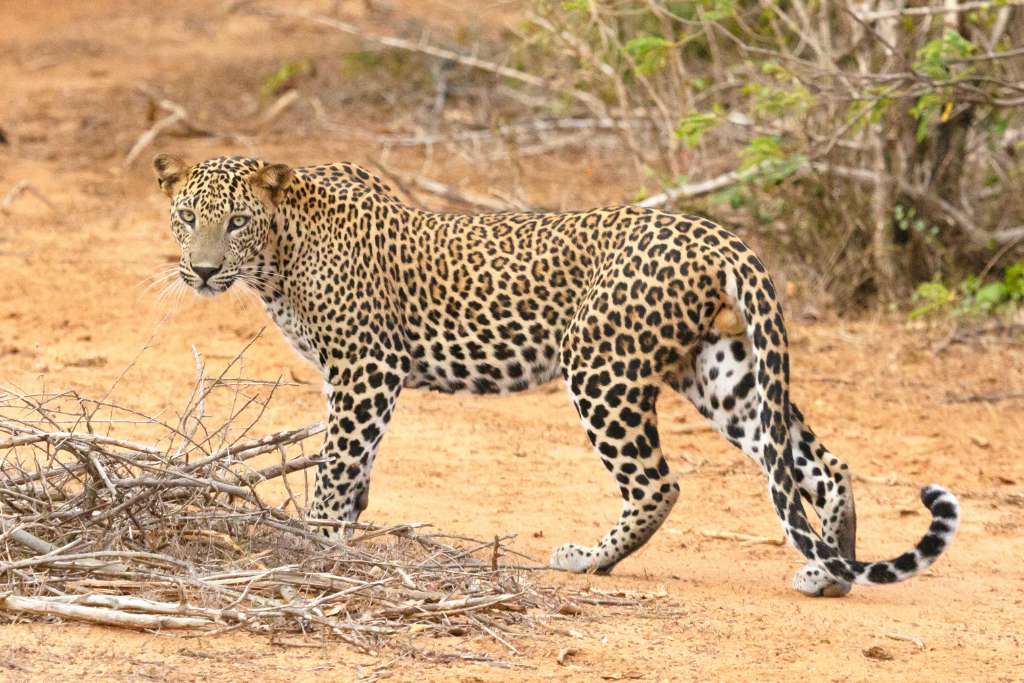
Surrounded by the Indian Ocean, further-flung Sri Lanka has leafy interiors that hold pristine beaches, coconut and tea plantations, Buddhist temples, fortresses poised on cliffs, and inviting beaches. With 8 UNESCO sites and 26 national parks, the island nation’s rich fabric boasts countless majestic creatures including elusive leopards and wild elephants. Tuck into stylish Amanwella on Sri Lanka’s sunny south coast near the fishing village of Tangalle. While the sumptuous hideaway offers its own diversions, its able team arranges wildlife safaris at Udawalawe National Park, just a 90-minute drive from the resort. With nearly 200 species of birds and 135 different species of butterflies, the park famously features not only leopards and elephants, but crocodiles, wild boar, and water buffaloes, among some 43 other mammals and countless reptiles.
Featured image courtesy of Anantara
The Travel Curator Newsletter
Add a touch of insider travel tips to your inbox!
You might also Like

Why Bodrum Is the Newest Mediterranean Hotspot to Visit

All the Best Viral Travel Products You Can Buy on Amazon

Immersive Japan: Cultural Stays with WorldHotels

WorldHotels: Redefining Luxury and Authenticity for the Modern Traveler

These are the Best Luxury Train Journeys in Europe

The World is a Catwalk When Fashion Designers Meet Travel

Asia Nature & Wildlife Tours
Asia is our homeland. We'll show you Asia, better than anyone else!
- Philippines
- Culture & Highlights
- Food & Local Life
- Active & Nature
- Beach & Relaxation
- Couple & Honeymoon
- Family Holiday
- Luxury Hotels & Resorts
- Boutique Hotels
- Standard Hotels

Blessed with plenty of wildlife attractions (e.g., Kalimantan Island, Sumatra Island, Sabah, Sarawak, Danjugan and Bohol), a wide variety of terrain and the stunning landscape, Asia is a truly home to the most wonderful wildlife which you won’t find in many places on Earth. In our Asia Nature and Wildlife tours collection, you will have an amazing chance to meet some special animals such as Komodo dragons, tigers, orangutans, rhinos and much more. Besides, observing various tropical plants (e.g., palms, wonderful flowers and ferns) will offer you an insightful view of their natural habitats.
An Adventure To Remember In Indonesia
Since Indonesia has more than 17,000 pristine islands, you might feel a bit overwhelmed to pick your desired tour. Get ready to our best Indonesia Nature and Wildlife Tours collection which includes the most incredible wildlife places (e.g., Tanjung Putting, Komodo and Tangkoko National Parks) to get you closer to green nature by a wide range of unforgettable experiences.
Indonesia - Land Of Nature & Wildlife
We know the land of thousands of islands – Indonesia is a true paradise for adventure enthusiasts, especially who want to spend time to discover the most incredible and unusual animals from the long-tailed macaques of the Tanjung Puting National Park to the biggest lizard on Earth in the Komodo National Park. This is also home to hundreds of active and inactive volcanoes.
Plenty Of Unforgettable Experiences
For natural lovers, Malaysia is a true paradise for them to get man unforgettable experiences with nature and wildlife – Going deep into the lush tropical rainforest in Taman Negara National Park; making friends with many special animals like monkeys, orangutans, elephants and rhinoceros; watching turtles in Selingan Turtle Island and witnessing the colourful coral reefs and fish.
Broaden Your Knowledge About Natural Habitat
From plenty of exciting activities in our best Malaysia Nature and Wildlife Tours itineraries, you will get many chances to learn more about the natural habitat by visiting the most special national parks (e.g., Taman Negara, Gunung Mulu, Kinabalu and Bako national parks) and spotting some incredible plants and animals (e.g., gibbons, rhinoceros, leopards and monkeys).
Incredible Nature & Wildlife Spots In Philippines
The Philippines is popular amongst travellers for its some of the most beautiful beaches on Earth, incredible surfing spots, diverse marine, but this archipelagic country, which has over 7,200 islands, also possesses an abundance of nature & wildlife spots to take in - Puerto Princesa Subterranean River National Park, Banaue Rice Terraces, Chocolate Hills & Philippine Tarsier and Wildlife Sanctuary.
Our Customers' Recent Experience with Asia Nature & Wildlife Tours

All Best Asia Nature & Wildlife Tours Recommended For You
Stress-free adventure Singapore, Thailand & Philippines
Asiatours expert.
We are here to help you
Travel from Thailand to Philippines on a excellently-built discovery, soaking up culture and revelling in the flavours of the regions. Take your time to discover a different side of Thailand, uncover flavours of energetic modern life in Singapore and idyllic islands in Philippines with soft white...
Dreamy Escape to Thailand, Vietnam & Malaysia Tour
The fascinating and varied itinerary will take you past from bustling cities of Bangkok, Hanoi and Ho Chi Minh city to the hauntingly picturesque Halong Bay, idyllic countryside of Mekong Delta, Chiang Mai and Karen villages, where you can enjoy friendly local hospitality at a homestay, and take in...
Unseen Nature and Rural Life of Laos
This eight-day tour will excite any visitors to Laos with its ethical elephant encounter, rustic river cruise, cave explorations, and more. The journey starts in Luang Prabang with an introduction to the historical, aesthetic, and spiritual significance of the laid-back town. Consider joining a...
Lesser Sunda Island Discovery Combine with Birding Tour
Find the beautiful birds in Indonesia! Our 16-day Lesser Sunda tour represents an enjoyable and fascinating adventure for those keen on exciting endemics and little-known creatures of this scenic region. Covering the hardcore birding destinations Flores, Komodo, Timor and Sumba, we offer a fresh...
Vietnam and Cambodia Bird Watching and Wildlife Tours
As its name, the tailor-made 16-day tour package is particularly designed for nature enthusiasts, especially those who are interested in in-depth birding and wildlife expedition. Unlike classic routes that mainly afford visits in major cities, you'll spend most of your time stay in Vietnam and...
Northern Thailand and Laos Highlights
Uncovering the enchanting landscapes, history richness, and unique local highlights of Northern Thailand and Laos, this 17-day adventure promises an immersive exploration of two distinct yet harmoniously intertwined Southeast Asian destinations, providing a perfect blend of urban vibrancy, natural...
Bali and Komodo Adventure
Venturing into 8-day expedition that encapsulates within itself the most highlighted cultural and natural gems of Bali, Komodo, Kuta and other neighboring island groups, you're amazed by Indonesia's endless tropical delights, diverse ecosystem and insightful immersion in indigenous culture....
Best of Borneo
Covering some of the oldest rainforests in the world, Kalimantan is home to an incredible array of wildlife, making it a perfect destination for any nature lovers and adventure explorers. On this amazing Best of Kalimantan tour pakacge, you will have 11 days packed with interesting attractions and...
Perfect Honeymoon in Sabah for Active Couple
Get your heart pumping with an array of adrenaline activities we offer during your honeymoon in Sabah. Known as one of the most unique ecosystems on earth with the incredibly ecological richness, Sabah attracts adventure enthusiasts by numerous wildlife expeditions ranging from mountain to sea....
Exuberant and Authentic Philippines
An ultimate adventure to all the best hotspots, this 12-day jaw-dropping tour is a perfect box-ticking trip that takes you through the best of Philippines’ nature, beaches, and island life. Soak in the tropical sun, swim in crystal clear waters or witness incredible sunsets, that’s just some of...
- 1 Day Tours
- 2 - 5 Day Tours
- 6 - 10 Day Tours
- 11 - 16 Day Tours
- >16 Day Tours
Borneo Photography Journey
Deeply immerse in the lush vibe of Borneo's forests through exciting walks
Spend all day at the Sepilok Forest Reserve (including visits to the Orangutan Sanctuary and the Sun Bear Centre) where is one of the best places for orangutans and other species photography
Cruise along the Kinabatangan River, explore the region's diverse ecosystems as well as take some great riverscapes photos
Venture into the night jungle for spotting fantastic moments of the nocturnal wildlife
Explore the hidden world inside the Gomantong Caves and take some shoots for a sublime spectacle of the bat exodus exit from the cave in the afternoon
Try your luck with the elusive species in Borneo nature reserves through day-to-day jungle expeditions highly requiring patience
Head out for a wildlife drives in Tabin Wildlife Reserve to look for more chances of animals photography
Take an in-depth exploration of the Danum Valley Conservation Area through numerous forest treks, birding, and other extra adventures for epic photos

Discover Nature & Wildlife in Sabah
Visit Mari Mari Village where is the home to several Bornean ethnic groups and embrace their culture, traditions and daily life
Freely stroll around the leafy streetscapes of Kota Kinabalu City
Hop on a boat ride then explore the cluster of Islands in Tunku Abdul Rahman Marine Park by snorkelling or other beach activities
Get your heart pumping with thrilling white water rafting on Kiulu River and contemplate the lush sceneries along the river while paddling
Discover Kinabalu National Park's unique ecosystems, observe different faunas and floras through stops at attractive sites here
Enjoy North Borneo Cruise with a breathtaking view of the sunset, hearty buffet spread for dinner, and music delights onboard
Have a spelunking into ancient Gomantong Caves, Sabah's largest bird’s nest cave, which is located in the Gomantong Forest Reserve
Go for safari excursions on the cruises along the Kinabatangan River and witness numerous endemic species in the region
Immerse in peaceful moments on the early morning cruise on the Ox-bow Lake for bird-watching
Explore the famous Sepilok Orang Utan Rehabilitation Centre and have a close and personal look at these lovely apes
Take a tour exploring Sadakan and visit the city's highlights
Relish your relaxing time in hot springs, on beautiful sandy beaches, or with free days at your leisure

Philippines Adventurous Holiday
Immerse in the extraordinary landscapes of Bohol’s Chocolate Hills and the fantastic Pangas waterfalls
Enjoy a delicious lunch at Loboc River Resort with the view overlooking the green Loboc River
Visit a sanctuary to see the tarsiers, one of the Bohol nature symbols as well as the world’s smallest primate in their natural habitat
Partake in Balicasag - Virgin island hopping tour with a high chance of dolphin watching and plenty of beach time
Get free time in Moalboal, a small fishing village in Cebu famous for diving sites and beautiful beaches
Take an adventurous day trip to Kawasan Waterfalls with thrilling water activities like cliff jumping, rappelling, abseiling…
Embark on an island hopping tour around El Nido with many beach activities like swimming, kayaking, snorkeling…
Go for an inland adventure to the northern Palawan by motorcycle
Hop on a fun island-beach excursion around Coron Island’s highlights such as Lake Kayangan, Twin Lagoon, Seven Sins…
Explore Coron’s incredible outlying islands including Malcapuya, Banana and Dolarog
Free to discover the capital city Manila, a center of historical and cultural landmarks

Nature Escape & Birdwatching in Philippines
Enjoy a day of birding with experienced local guides in the island sanctuary of Danjugan and the mountains of Valencia
Taste authentic Filipino cuisine in a buffet dinner while watching a cultural presentation of Tinikling, the nation’s traditional dance
Hop on a private bangka excursion to the unspoiled island sanctuary of Danjugan with many wildlife and birdwatching opportunities
Go kayaking and snorkeling in one of the best lagoons in Danjugan island to see a rich marine life of corals and fish
Take a refreshing dip at the Pulang Bato Hot Springs & waterfalls
Visit a local Valencia community for some cooking & social immersion activities
Have a fun time swimming with sea turtles around Apo Island
Free to explore the colonial and modern charm of Manila capital city when strolling through vibrant streets
Optional visit to a local indigenous artist’s workshop to see handcrafted musical instruments

Malaysia Eastern Wildlife Tour
Visit Orangutan Rehabilitation Centre, Sun Bear Centre, and the Rainforest Discovery Centre in Sepilok for exciting nature discoveries
Depart on wildlife river cruises in the Kinabatangan River and witness the biological richness along the wide stream
Take several night walks or night drive discovering the east Sabah's nocturnal wildlife
Enjoy an early bird-watching and have a whole day to explore further natural sites around the Eco camp
Have a fabulous wildlife expedition in Tabin Nature Reserve with a variety of adventures to numerous attractive nature-based sites
Explore the pristine Danum Valley, home to numerous captivating trails, unique species as well as one of the oldest rainforests on the planet
Relish with peaceful eco stays in well-furnished accommodations amidst the greens

Unveil The Great North of Sumatra
Discover interesting cultural places in Medan, including Maimoon Palace, Medan Great Mosque, and Tjong A Fie Mansion
Revel in the natural beauty of Lake Toba on a boat trip and explore Batak traditional villages on Samosir Island
Take pictures of the majestic Sipiso Piso Waterfall from a vantage point on Tongging hill
Visit Lingga village, a unique Batak Karo village with ancient traditional houses
Go on a jungle hike through the magnificent Gunung Leuser National Park in Ketambe for some orangutan encounters
Stop by rubber and oil palm plantations on the way to Tangkahan
Trek into the Gunung Leuser National Park with the elephants in Tangkahan

Philippines Dreamy Honeymoon
Get to know the Philippine gastronomy with a welcome dinner in Manila
Go for a Manila city tour through Intramuros’ historical landmarks as well as other highlights such as China Town, Binondo and Quiapo area
Have a chance to swim with whale sharks and dolphins in Honda Bay of Puerto Princesa (April to November)
Visit one of the world UNESCO heritage sites, the Puerto Princesa Subterranean River by boat
Hop on a boat adventure touring the best beaches of El Nido with a wide range of beach activities: swimming, snorkeling, kayaking,…
Free to explore El Nido town’s attractions like Nacpan Beach or Bulalacao waterfall
Discover the cuisine and attractions in Coron town on your own
Take a fun island-hopping adventure around Coron Island’s highlights such as Lake Kayangan, Twin Lagoons, Siete Pecados…

Great Java Railway Journey
Spend a day exploring the world-class botanical garden of Bogor and the cultural site of Taman Mini Indonesia Indah
Join a Jakarta city tour through Sunda Kelapa Harbour, Fatahillah Museum, Jembatan Kota Intan,…
Take in the splendid panoramic scenery of Mount Tangkuban Perahu and Ciater Tea Plantation
Learn more about Sundanese culture at Saung Angklung Udjo
Go for train excursions from Jakarta – Bandung, Bandung – Jogjakarta and Probolinggo – Banyuwangi
Explore UNESCO world heritage sites of Prambanan and Borobudur
Visit the house of Sampoerna and Kayoon Flower Market in Surabaya
Admire the charming beauty of Bromo Mount and experience a 4WD Jeep drive
Enjoy the magnificent view of sunrise over Ijen Crater

Customize Asia Nature & Wildlife Tours with us!
We are here to take the stress out of the holiday planning process. Let us help you plan an unforgettable journey of lifetime with High Quality & Affordable Price. Surely, you will feel satisfactory!
- $1000 - $2000
- $2000 - $3000
- $3000 - $5000
Other Asia Tours by Styles
Best asia tours.
Welcome to Asia, the vibrant and inspiring land of diverse culture, nature, history and tradition waiting to be discovered. Connect to the fascinating countries of Asia - Vietnam, Laos, Cambodia, Thailand, Myanmar, Indonesia, Malaysia, Singapore, the Philippines, China, Japan, Nepal, Bhutan,...
Asia Classic Highlights
Discover your own classic Asia with our unforgettable tours throughout the highlights of fascinating countries (e.g., Thailand, Cambodia, Vietnam, Laos, Myanmar, Malaysia, Indonesia, Singapore, the Philippines, China, Japan, Nepal, Bhutan, India and Sri Lanka). Regardless of your preferred group...
Asia Family Tours
If you are looking for a destination to travel with your family members, Asia could be a perfect choice. Join our Asia Family Tours with a variety of memorable and first-hand experiences in Vietnam, Cambodia, Thailand, Laos, Myanmar, Malaysia, Indonesia, Singapore, the Philippines, China, Japan,...
Asia Beach Holidays
Leave your stressful days behind and travel to Asia for an amazing beach holiday. Having a worldwide reputation for its breath-taking views, peaceful islands and stunning beaches, Asia provides a list of terrific beach destinations (e.g., Vietnam, Cambodia, Thailand, Myanmar, Malaysia, Indonesia,...
Asia Luxury Tours
Asia is a wonderland for any explorer who is looking for the most intriguing experiences unlike anywhere in the world. This land offers experiences of the contrast between old and new, traditional and modern which could cater to every whim. At Asia Tours, we offer a great collection of Asia Luxury...
Asia Honeymoon Tours
A honeymoon trip to the lands of love, romance and peace is something each couple could not miss to get a perfect beginning to the new marriage life. Whether you are looking for a honeymoon vacation on tropical islands with pristine beaches and luxury resorts or desiring to visit cities of exotic...
Asia Active Tours
Being the largest continent on Earth and famous for its cultural diversity along with the hottest travel destinations, Asia is a great place for the active traveller. There are an array of options for the more adventurous minded such as kayaking along tranquil bays or around pristine islands,...
Asia Cruise Packages
Asia is a harmony of countless cultures, tranquil landscapes and incredibly hospital people. A cruise package to Asia is an exciting journey to discover some of the world's hottest travel destinations on one unforgettable vacation. From port to port, you will have a chance to discover picturesque...
Asia Day Trips & Short Breaks
Day trips and short breaks in Asia are the best choices for those who do not have much time in a destination while wishing to have some short but fulfill experiences. At Asia Tours, we offer a wide range of day trips and short excursions in which tourists will enjoy private guided experiences and...
Asia Special Interests Tours
Asia is best known for its ancient cultures, timeless beauty of legendary landmarks and alluring natural places that also offers travelers with special interests plent of impressive tour packages. Take an extremely relaxing spa and wellness treatment. Visit ancient and modern masterpieces of art...
Asia Culinary Tours
Asia is a paradise of open-air bazaars, exotic indigenous spices, tropical fruits, and vegetables which tempt the taste buds of cuisine lovers from all over the world. From the vibrant night markets of Thailand, the special blue rice – Nasi Kerabu in Malaysia, the delicious nuances of Khmer...
Asia Local Life Tours
Asia is a continent which has different countries blessed with rich culture, exotic destinations, and beautiful attractions which offers very diverse travel options. If you are planning a trip and wishing for real-life, honest and authentic experiences in Asia, Local Life Tours is a great choice....

Being the locals, we know the true value of our land. We always listen and arrange everything as your desire.
(+84) 916 952 668
Create Own Tour
We always listen to your wishes and desires to offer the best private tours to be your exact needs& tastes
- September 2024
- October 2024
- November 2024
- December 2024
- January 2025
- February 2025
- August 2025
- September 2025
- October 2025
- November 2025
UN Tourism | Bringing the world closer
Wildlife conservation, unwto/chimelong.
- UNWTO/Chimelong Initiative
- WHY WILDLIFE?
- UNWTO/CHIMELONG ACTIVITIES
- INITIATIVE RESOURCES - CONTACTS
share this content
- Share this article on facebook
- Share this article on twitter
- Share this article on linkedin
UNWTO/Chimelong Initiative on Wildlife Conservation and Sustainable Tourism in Africa & Asia and the Pacific
- Asia and the Pacific
UNWTO/Chimelong Initiative are to contribute to the Sustainable Development Goals and the 2030 Agenda
Advocating the Sustainable Development Goals, enhancing the quality of human capital, encouraging the tourism private sector to adhere to corporate social responsibility and exploiting the potential for cooperation on conducting research to deliver solutions and advance ideas in the field of wildlife conservation and sustainable tourism. These constitute the areas of work of the initiative on Wildlife Tourism resulting from the partnership signed between the Wolrd Tourism Organisation (UNWTO) and the Guangdong Chimelong Group.

The traditional concerns of the World Tourism Organization on protection and conservation of wildlife are well-known. Research work such as ‘Towards Measuring the Economic Value of Wildlife Watching Tourism in Africa’ (UNWTO, 2015) have portrayed the potential of tourism as catalyst to increase awareness, to promote conservation and protection policies and to engage multiple stakeholders in this global cause.
Illegal trafficking, poaching and lack of knowledge about the potential of wildlife have been some of the factors that have put this unique animal and vegetal richness at risk.
The commitment of the World Tourism Organization upon this theme has been reinforced by the adoption in 2015 by the United Nations General Assembly of the International Year of Sustainable Tourism for Development 2017. The initiative, to be led by the World Tourism Organization, has been articulated by a global campaign joined by governments, private sector recipients and civil society, aimed at raising awareness, at bringing partners of different nature and at building common action around the need to apply more sustainable and responsible practices into the tourism sector.

The initiative started its implementation in 2017 and will run through 2021 (period extended due to COVID-19 pandemic). It has as major focus on wildlife conservation in Africa and Asia and the Pacific as wildlife acquires a global dimension in these parts of the world. The initiative includes approaches such as capacity building, media engagement, research and talent development and addresses multiple stakeholders like governments, tourism administrations, media, civil society and private sector.
Objectives of the UNWTO/Chimelong Initiative:

- Enhance the quality of human capital in sustainable tourism and wildlife conservation
- Exploit the potential for cooperation with special emphasis on conducting research to deliver solutions and advance ideas that will lead to sustainable tourism and wildlife conservation
- Encourage the tourism private sector to adhere to corporate social responsibility, especially in wildlife conservation
UNWTO/Chimelong Initiative areas of contribution:
- Activities related to the improvement of the quality of human capital
- Theme based research
- Activities related to advocating wildlife conservation
- Activities for establishing tourist information facilities on wildlife conservation
UNWTO/Chimelong Initiative areas of work:
- Asia & the Pacific
- Media Activities

17 BEST PLACES TO SEE WILDLIFE IN ASIA AND AUSTRALIA
Updated January 2024
The best places to see wildlife is in the wild. If that’s not possible, wildlife reserves are an alternative. If you’re an animal lover or interested in animal conservation, then planning a trip to see wildlife should be on your travel bucket list. We asked some fellow travel bloggers for the best places to see wildlife in Asia and Australia, particularly Australia’s wildlife sanctuaries , and they did not disappoint.
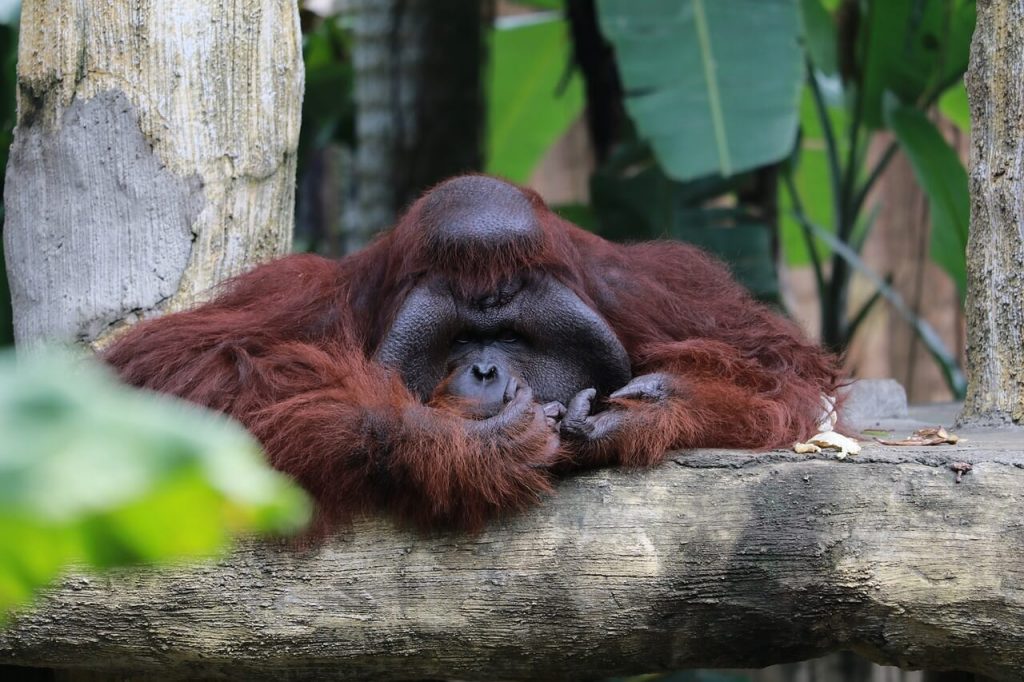
Table of Contents
Best Places to See Wildlife in Asia
Blue whale watching in mirissa, sri lanka.
Mirissa, a small town in the south of Sri Lanka, is an essential stop for wildlife lovers and one of the best places to see wildlife in Asia. While the country’s national parks offer the chance to see some incredible animals, from leopards to elephants, Mirissa offers something different. This small town is one of the best places in the world to see blue whales! Mirissa’s main whale watching season runs from November to April. Trips during this time have around a 95% chance of seeing whales. Although tours do still run between May and October, whales are seen less frequently due to rougher seas. It’s also more likely that tours are cancelled due to the weather during these months. We visited Mirissa in December 2017 and decided to take a whale watching tour on Christmas day. A tuk tuk was sent to pick us up at 5:45 am to take us to the port. As we set off we were treated to a lovely sunrise, hoping we’d be lucky enough to see some whales and make it a Christmas to remember!
Just a few hours later we were in awe as we caught our first glimpse of a blue whale, but it didn’t stop there. Over the course of the next few hours, our crew pointed out well over 10 blue whales. We had some incredible views as the whales surfaced to breathe before diving back down into the depths of the ocean. On the boat ride back to the town we also saw a couple of turtles. Although we only saw blue whales and turtles, the tours do often encounter plenty of other species – from orcas to dolphins to whale sharks. Some whale watching tours in Mirissa don’t seem to care about the wellbeing of the whales, so make sure to check reviews before booking with an operator!
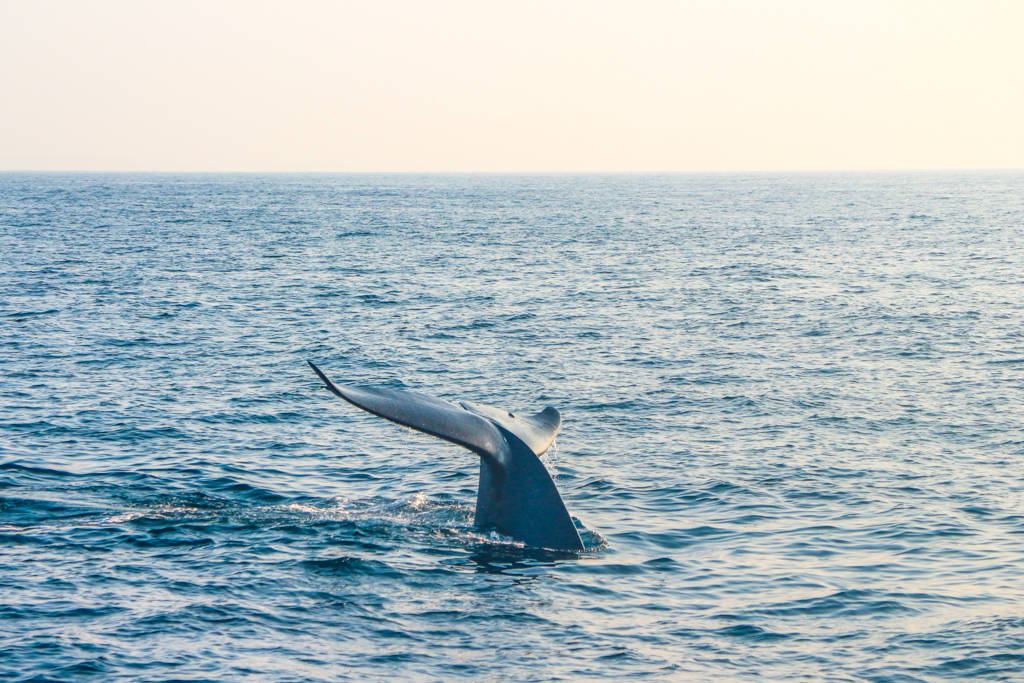
Sam Ward blogs at Something of Freedom
A Jungle Safari in Karnataka, India
We booked our first real expedition into the wilderness on a sweltering summer day, at Bandipur National Park with the Jungle Lodges, the first eco-tourism venture in India. Bandipur is a beautiful, unapologetically wild terrain nestled in the lush green Western Ghats of India, which is blessed with a great diversity of flora and fauna, ideal for Asia wildlife viewing. It is one of the four borderless national parks spread across three states of India and is home to the largest population of tigers in India. This makes India one of the best places to see wildlife in Asia.
Once the favorite hunting ground of the Royals of Mysore, Bandipur was turned into a protected area, a safe haven for the wild including leopards, bears, Indian Sambar, spotted deer, elephants, peafowls, and many other exotic species including the tigers. Our 6-hour jungle safari was split into two sessions of 3-hours each, one in the afternoon and one in the early morning. We went in an open jeep to discover the beauty of wildlife in their natural habitat. We got to see several animals, the beautiful sunset and the sunrise the following day, but the tiger remained elusive, until the last moment when we were about to leave the jungle with a heavy heart. So yes, our tryst with the tiger did happen after all, and it will be one of the memories to cherish forever. What I like the most about Bandipur is the ethical tourism practices. Even today no vehicle can cross the forest between 9pm to 6am, a law that has been contested by many political forces but still stands to protect wildlife.
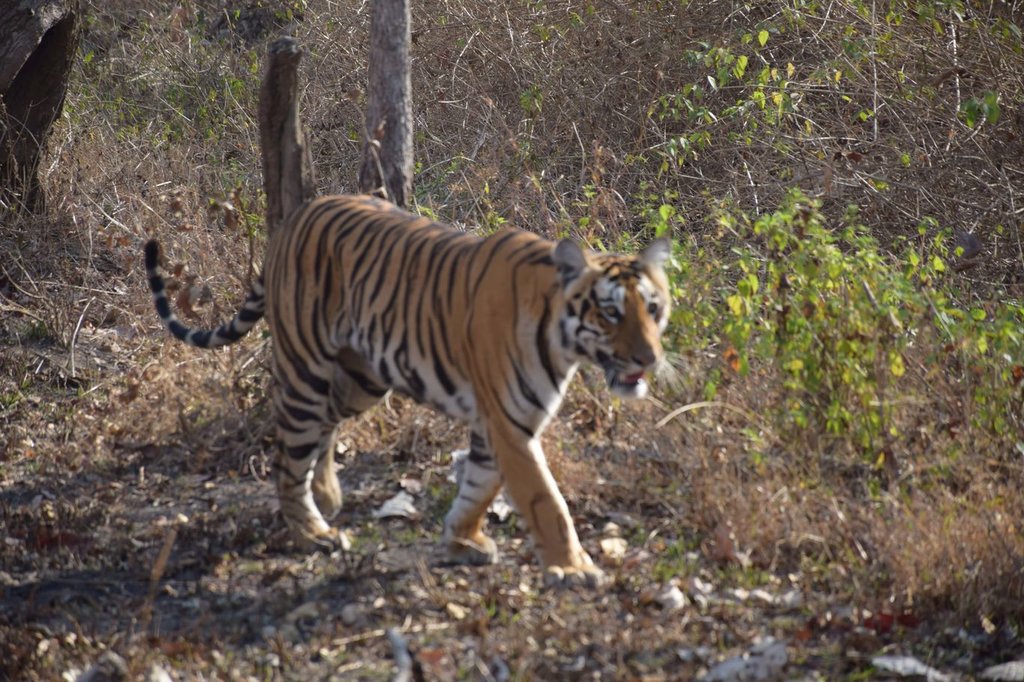
Sinjana blogs at Backpack & Explore .
The Great Monkey Attack of Angkor Wat, Cambodia
The best places to see wildlife may be where you least expect it. Wildlife in southeast Asia can be especially unpredictable. You don’t need to take a wildlife tour of southeast Asia to find yourself in the middle of a wildlife, shall we say, “situation” especially as it relates to monkeys.
During our trip to Angkor Wat in Cambodia, we arrived at our guest house late at night. Next morning, we left to see the temples but saw two huge monkeys blocking our entrance to the road. We walked towards them making noise and waving our arms expecting them to scatter but instead, they approached us. As we considered what to do, a monkey came from behind, jumped on my back and tore at my backpack that had a couple of packets of dried fruit. I was shocked and began screaming “get it off!…get it off!” We ran to the road while a couple of monkeys chased us. Once out of monkey-range, we looked back and saw them staring at us. I could swear they were laughing. I couldn’t believe what had just happened. We had actually endured a strategically executed attack by a troop of monkeys!
The monkey attack was all we talked about that day. When we returned to our guest house that evening, there were no monkeys in sight. Next morning, we were getting ready to leave when we heard a screeching animal sound. We looked out our window and saw monkeys gathering in front of our guest house. They were looking straight at our room! There were 12 to 16 large monkeys right outside our door. And those were just the ones that we could see! There was no way we were getting out of there and onto the road with our stuff. Suddenly I saw the woman that checked us in the first day. She walked towards out room with a large dog. The monkeys scattered which gave us enough time to get to the main road with our bags. As we left, the woman smiled apologetically and told us the monkeys could sometimes get “frisky.” We were happy we survived the great monkey attack of Angkor Wat.
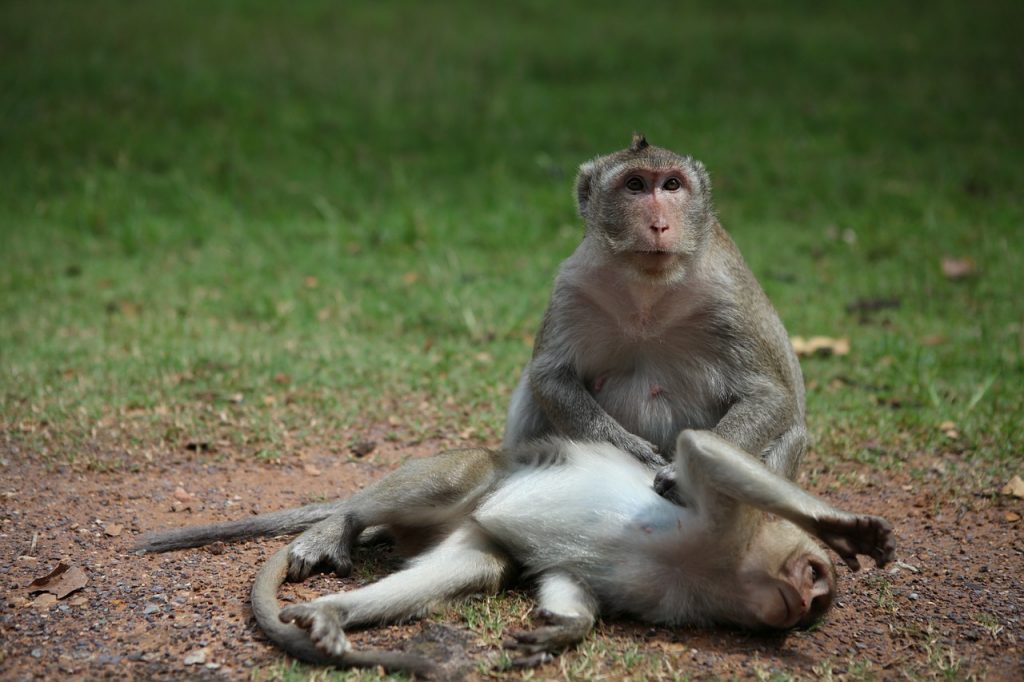
Talek blogs at Travels with Talek .
Pygmy Elephants in Borneo
Seeing pygmy elephants in Borneo takes time and effort. In Sabah in the north of Borneo, you can take a 4-hour speed boat from Sandakan up the slow-moving brown Kinabatangan River, which is laden with silt and surrounded by palm trees at first and then thick jungle, to a rain forest lodge. From there, you can take another boat a couple of more hours upriver, past proboscis monkeys and macaques jumping around in trees, golden crocodiles lazing on muddy banks, and black and white hornbills flying overhead to get to where pygmy elephants are on their migratory march across part of the island. Pygmy elephants are the smallest elephants on the planet, with large ears and long tails, and are endemic to Borneo and nearby islands.
After more than an hour of peering intently into the jungle but seeing nothing but trees, we saw a small boat pulled alongside, half hidden under overhanging vines. Inside were two fellow guests from our lodge, who had been temporarily abandoned by their guide, as he headed into the jungle to look for tracks. They were pulled alongside a tiny inlet completely hidden from the river. A grey elephant slowly emerged from the trees and made its ways slowly down the sloping banks and into the shallow inlet. Another elephant joined it, as they crossed the inlet, then walked slowly up the other side and lumbered back into the jungle. It was a completely magical moment. What a wonderful opportunity to see wildlife in Asia!
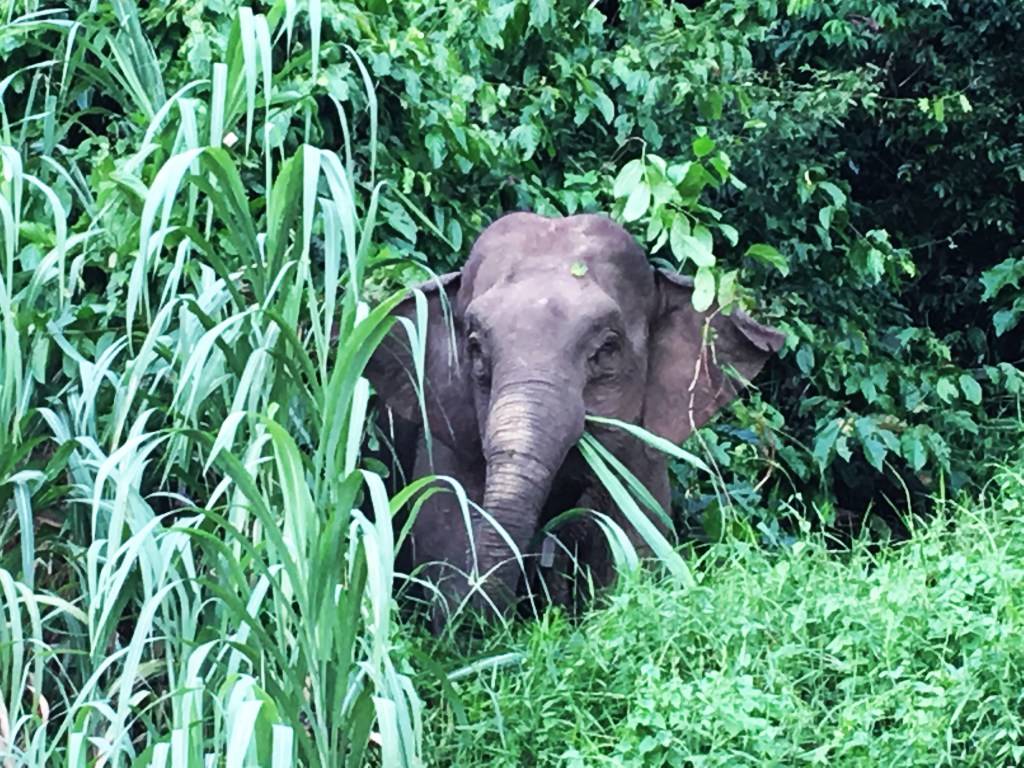
James Ian blogs at Travel Collecting .
Tarsiers and Black Macaques in Sulawesi, Indonesia
When we were in Sulawesi, Indonesia, we had an opportunity to visit Tangkoko Nature Reserve. A few years ago, this reserve caught the media’s attention when a black crested macaque became the centre of a “monkey selfie” lawsuit brought by PETA.
We visited Tangkoko to view the Tarsiers, the smallest primates in the world which has eyes as big as saucers. They do not fare well in sanctuaries as they are sensitive to daylight, noise and physical contact, so the most ethical way of seeing this yoda-like creature is in its natural habitat.
Walking through the Reserve to see Tarsiers we passed a family of black macaques. Observing protocol of keeping our distance, we stopped and watched them running and tumbling as monkeys do. A few were being groomed, and as my husband crouched down to take a photo of the chief, a monkey groomer jumped onto his shoulders. He began rubbing Sy’s shaved head and feeling his stubbly chin, so Sy gently lifted up his mobile phone and snapped a photo of them both. Thankfully the monkey jumped down not long after, leaving Sy with a great photo and a smelly t-shirt!
We continued towards the Tarsiers; it was a bit of an anti-climax after the macaques but nevertheless, a wonderful encounter all the same. Tarsiers only come out at dusk, so we waited until there was movement in a large tree. As they started to wake up, they began hunting and jumped huge distances from tree to tree. These tiny little primates looked adorably cute with their soft fur and freakishly long fingers. We will always remember our unusual and interesting wildlife encounter at Tangkoko Nature Reserve, one of the best places to see wildlife in Asia.
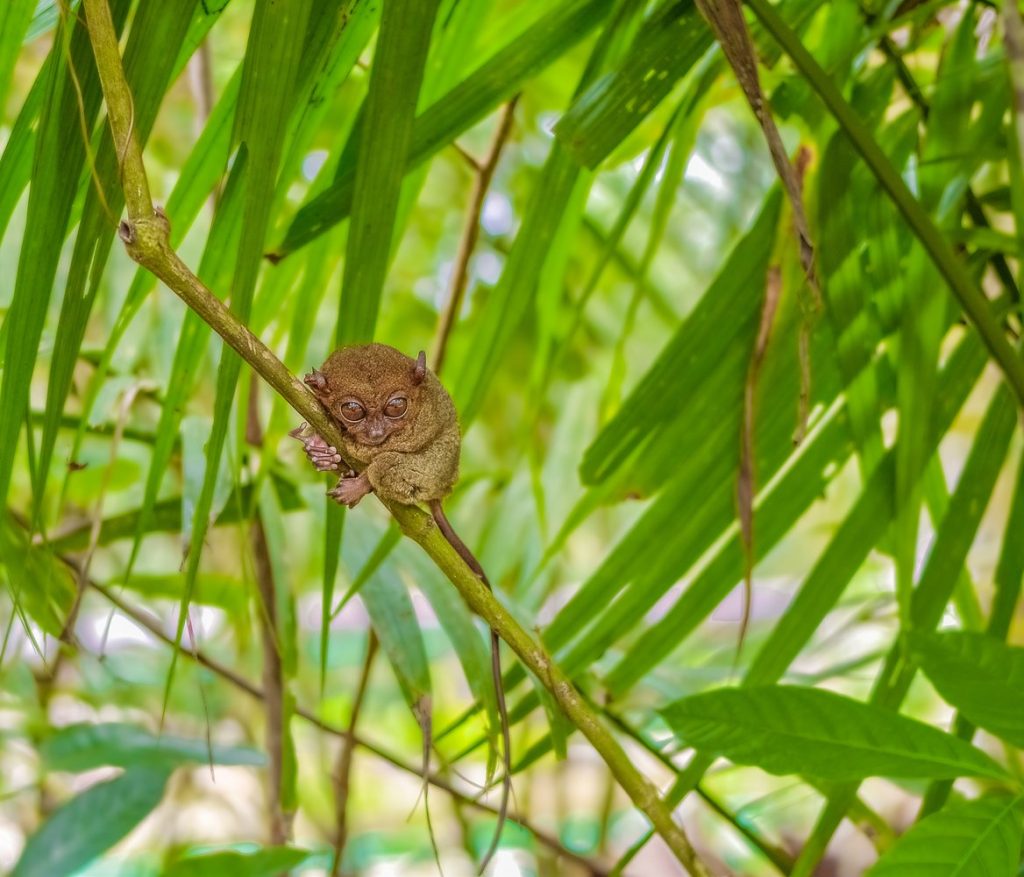
Angie blogs at Feet Do Travel .
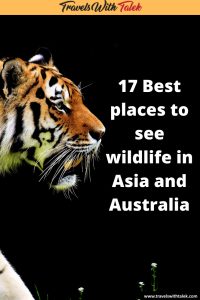
Swimming with Turtles in Apo Island, Philippines
One of my best wildlife adventures was seeing and swimming with sea turtles in Apo Island, Philippines.
Apo Island is actually a declared marine preserve, and it’s located in the Coral Triangle – a huge area spanning different countries known for its high marine diversity. To get here, I took a flight to Dumaguete and then signed up for a day tour in Apo Island. The first activity in the tour is to see sea turtles in the wild.
A tour guide led the group in the water, and we swam for several minutes before spotting a sea turtle. We then circled the perimeters of the island and saw a few others. What’s remarkable to me here is that the sea turtles didn’t mind the presence of people (unlike in other places where they try to get away when you approach them), although of course we kept our distance. Our tour guide explained that the turtles are used to humans and know that the latter do not harm or disturb them, which is great. Some of the sea turtles were really big and a few decades old. Keeping at least a meter or so away from the turtles, we took great underwater shots with them at the backdrop. Swimming with the turtles in Apo Island is certainly a wildlife experience I’d never forget, and Apo Island is one of the best places to see wildlife in Asia.
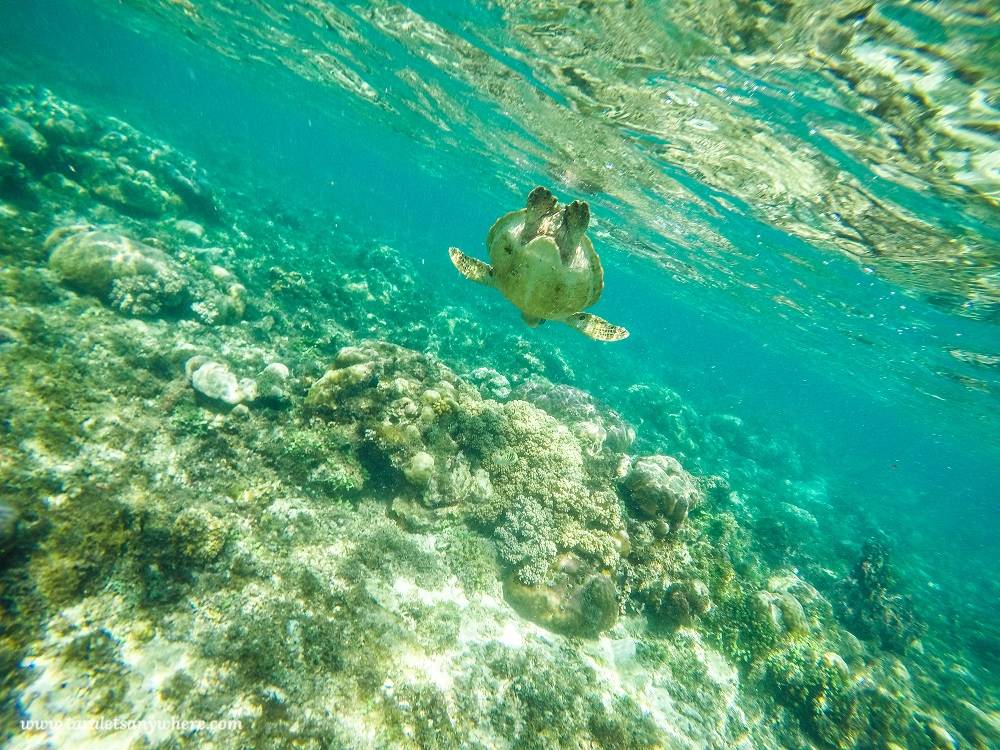
Katharine blogs at Tara Let’s Anywhere .
Kaudulla National Park, Sri Lanka
Asian elephants are an endangered species, so any opportunity to see them in the wild is special. The population has declined by 50% in the last three generations and there are only 40,000 left across the whole of Asia (6,000 of them being in Sri Lanka). This is why a visit in July or August to Kaudulla or Minneriya in Sri Lanka is truly special. At this time of year, it won’t be whether you see an elephant it will be how many! They are often seen around the dwindling waterholes in herds of up to 200.
We were lucky enough to see 110 on our visit (yes, we counted!). Many elephants came right up to the jeep, and it was incredible to see so many in one spot, including loads of gorgeous calves. It’s quite hard to describe in words how magical it is to get up close to these beautiful animals, it would make a trip to Sri Lanka worth it for this experience alone. The best way to see the elephant gathering is by hiring a jeep from the nearby town of Sigiriya. They are pretty flexible with the times you go, though they recommend going in the afternoon, and you can book a private jeep that will take you to the park for 4 hours for 4,500 rupees ($28 USD). The jeeps have an open-air top, so you can stand up and watch the elephants from high up, giving great views across the plains.
Whilst Minneriya is closer to Sigiriya, you will be there with a lot more people, so we chose to visit Kaudulla. It’s best to check with the locals in town as to where the elephants currently are – although they are usually be seen in both. The access roads are pretty rough, but once you get to where the elephants are you won’t move too much. You’ll simply drive up, stop and start counting how many you can see.
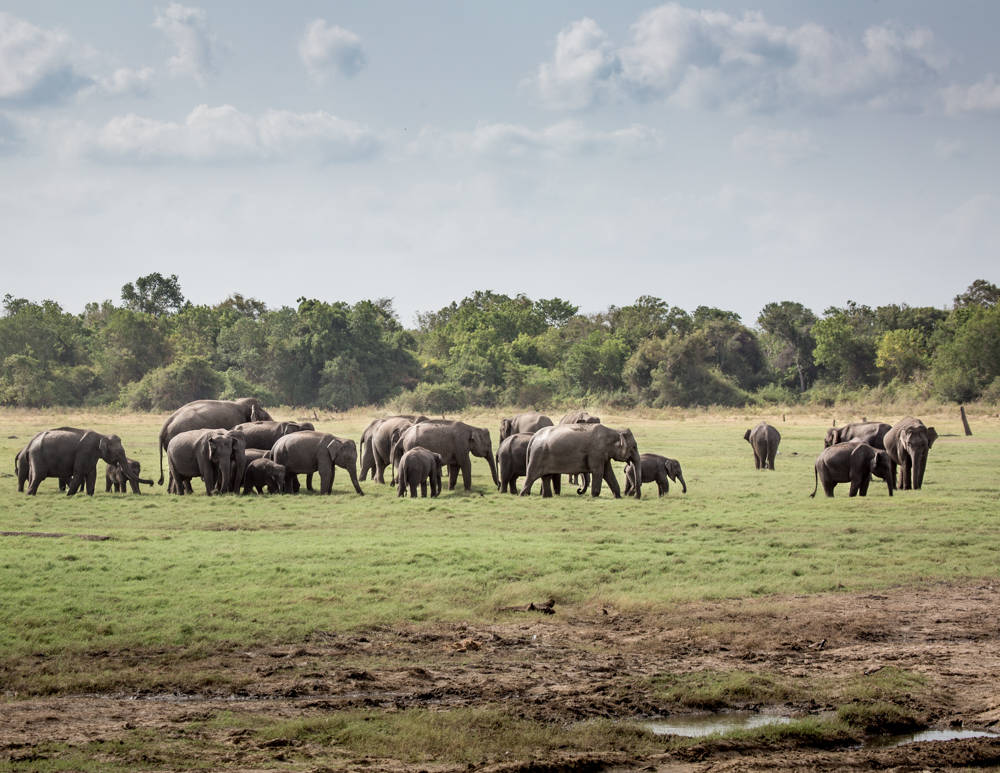
Cat Smith blogs at Walk My World .
Seeing Monkeys in Lopburi, Thailand
Earlier this summer I was travelling through some parts of Southeast Asia, and after hearing many stories about Lopburi in Thailand I knew I had to visit it. I live in Europe; I’m not really used to seeing monkeys. And Lopburi is often described as a city where monkeys have taken over. I knew I had to visit!
From Bangkok, it is an easy 2-hour train ride to Lopburi. Once I arrived it was obvious that I was in the right city, as right in front of me after getting off the train was a huge 2-meter tall, brightly coloured statue of a big monkey. They are proud of their monkeys in Lopburi!
The monkeys tend to mostly congregate in the area of the old temple ruins called Phra Prang Sam Yot. As you approach the area, the more monkeys you see hanging out on the roads and walls. But once you actually enter the Phra Prang Sam Yot area you are surrounded by at least a couple hundred macaque monkeys. They seem to either chill out in the hot sun with the other monkeys (sometimes picking at each other’s fur) or are on the lookout for food to snatch from the tourists who visit the area.
There are a few workers who will sell snacks that you can feed the monkeys for 50 baht. We bought some corn, which the monkeys quickly noticed and circled us. Feeding the monkeys out of our hands was definitely the most enjoyable part, however even just watching this huge number of monkeys relaxing with each other was fascinating as well. The monkeys seem quite harmless, but they did jump on us a few times. There is a hosepipe near the entrance where you can wash your hands, arms, back, hair and wherever else the monkeys climbed on you! If you are in Bangkok and love monkeys, then I really recommend that make the train trip to Lopburi.
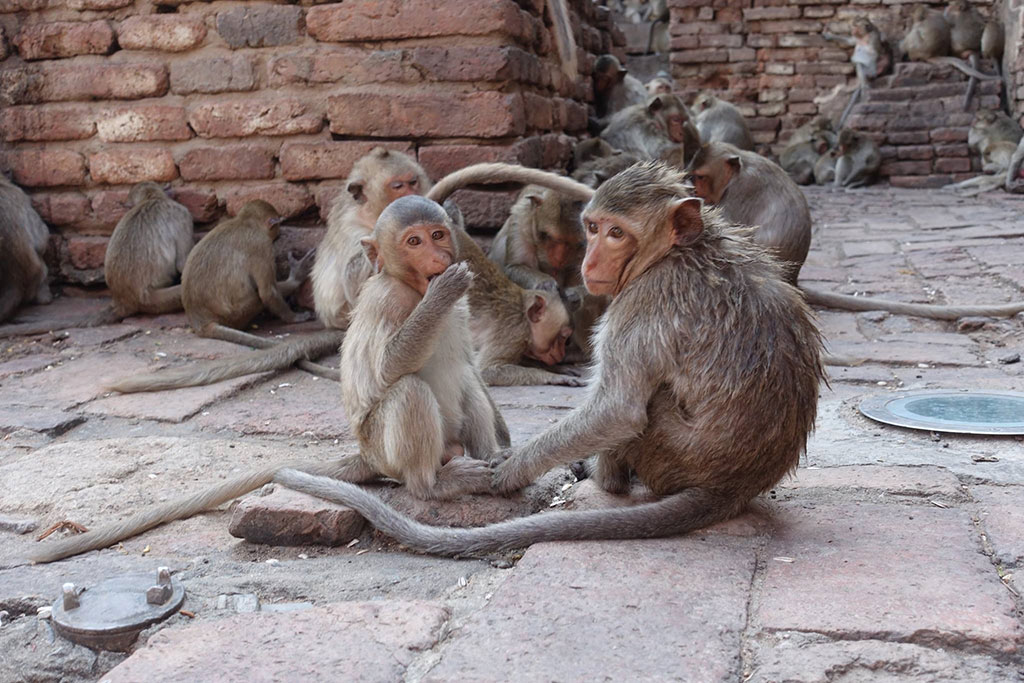
Patrick blogs at Complete City Guides .
Sea Turtles in Tioman Island, Malaysia
My family and I wanted to have an ethical experience with sea turtles in Southeast Asia in 2017. We volunteered for a week with the excellent Juara Turtle Project on Tioman Island, as they accept families and need unskilled volunteers to help with many of their tasks. It was a busy and fun week in which we patrolled the beach looking for evidence of nesting mothers, participated in trash clean-ups and daily chores, and spoke to visitors to the centre about the Project’s work.
We didn’t see a mother turtle in that week, but we did see hatchlings! The night we arrived a few latecomers emerged from a nest and we were woken to see them scurry to the water. A few days later the team and volunteers excavated that nest, as they count how many eggs didn’t hatch and record the reasons they didn’t. In the excavation a couple of turtles were found alive! They were too weak to get out by themselves, so they didn’t have much chance of making it, but they were still released into the ocean with all of our hopes behind them. And to complete the circle, some eggs were discovered on the boat patrol that day and brought to the hatchery, so we got to help transfer them into their new nest too. It was fascinating and amazing work.
We monitored the hatchery daily and could see that another nest was going to hatch soon, because the sand on top of it was moving and shifting all the time. But when our week finished the baby turtles still hadn’t emerged, much to our disappointment. Luckily, we were only staying nearby, because our friends at the project called the night, we left to tell us the nest had hatched! We finally got to see a full nest of over 100 hatchlings be released, and the spectacular sight was worth the wait.
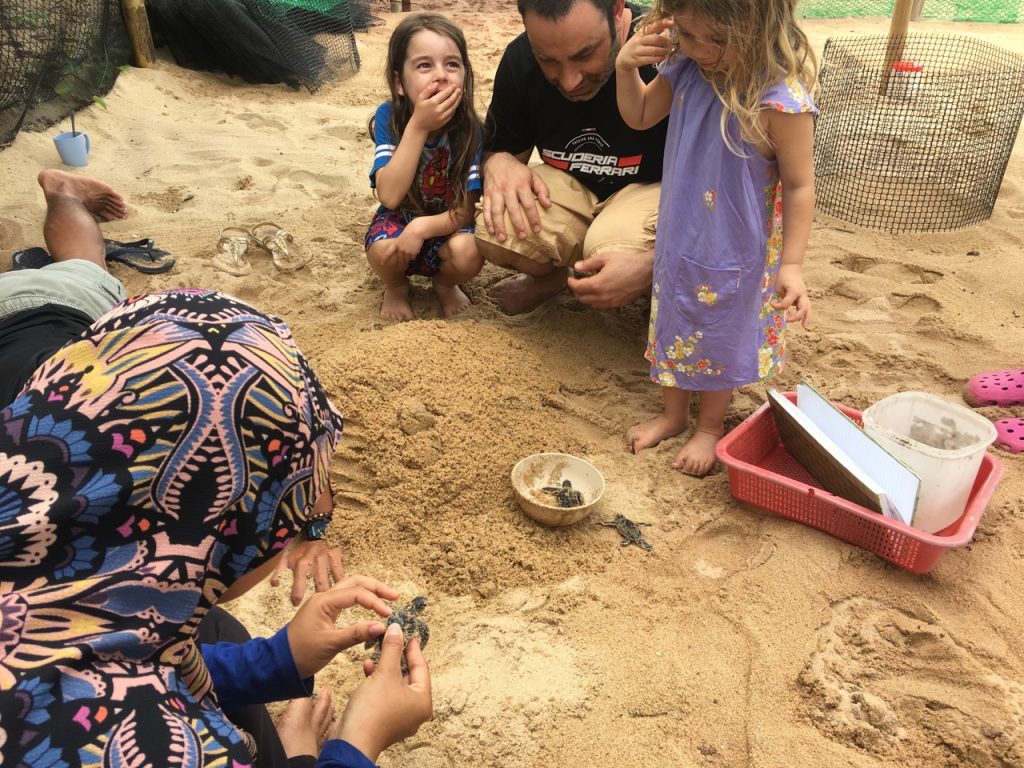
Read the complete adventure at Small Footprints, Big Adventures .
Bardia National Park – Nepal
Each time I thought about getting to Nepal, I thought about trekking and enjoying the Himalayas. Not once did I think that I would actually end up going to Nepal on an animal adventure. My husband really wanted to see tigers in their natural habitat, so this is how we ended up in Bardia National Park.
Bardia is, in my opinion, Nepal’s hidden gem. It’s a great natural park filled with wild animals and with a friendly community surrounding it. Unfortunately, it is not easy to reach it, either via a flight from Kathmandu to Nepalgunj and from there getting a jeep or riding a bus or via a 17 to 19-hour bus ride from Kathmandu. We spent two days roaming around the park together with a ranger and his aid. It was amazing as there were no other tourists. I kept on thinking about the photos from Chitwan where you see tons of people, and there are even traffic jams with the safari jeeps taking tourists to observe the animals. So, definitely, Bardia is a much better option.
The experience itself was excellent as it is not easy to spot a tiger and a lot of times people spend days and return unsuccessful. After quite a while, we got to see the tiger passing a small pond in front of our eyes. We were fortunate to see other animals as well; rhinos, a herd of elephants playing in the water, tons of deer and monkeys, a snake, a jackal, a peacock, and of course, the majestic tiger. If you want to experience nature as it is, then Bardia is the place to go. And you might be lucky and see the tiger as well.
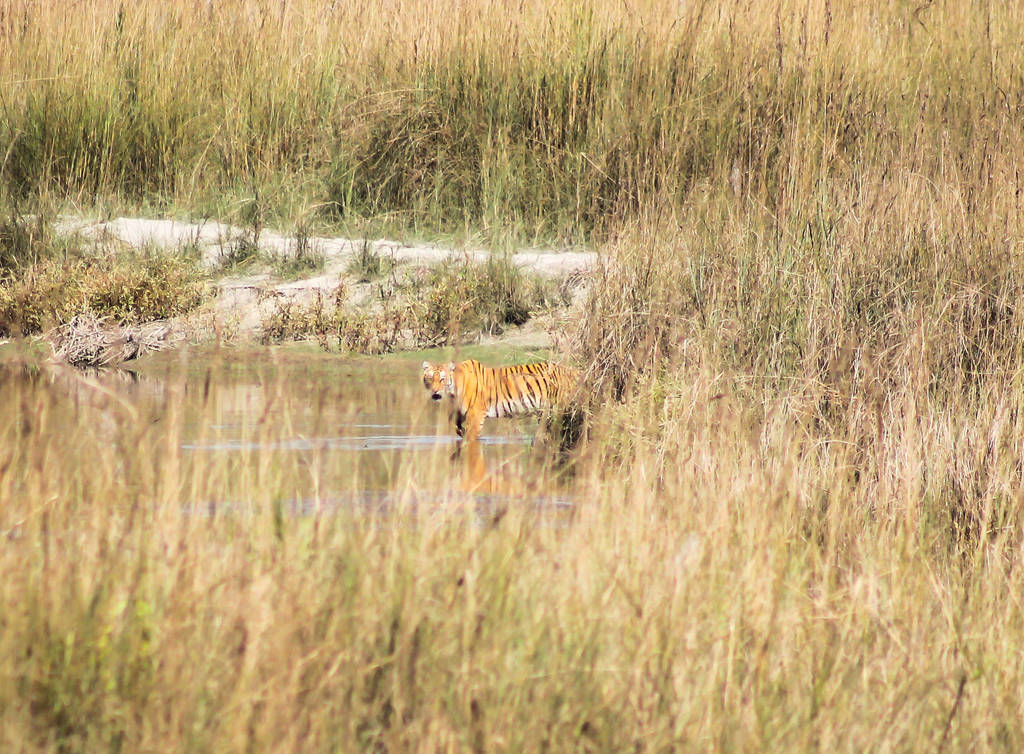
Andra blogs at Our World to Wander .
Diving with Giant Mantas in Komodo National Park – Indonesia
Komodo Island in Indonesia is very well known because of the dragons of Komodo that can only be found here. But what most people don’t know is that the underwater region near this island is also spectacular.
We have gone diving in more than 100 spots on 20 different countries, but Komodo is on top of all our lists as the best one we have ever been to. Here you can find a great variety of underwater life with many fish of all kinds and corals of vibrant and beautiful colors. The most interesting diving point here is the giant mantas. At first sight you will only see an undersea desert with almost no life. But suddenly, a giant and wonderful manta will appear in front of your eyes. These animals can only be seen in their natural environment in few places around the world. Even though you only get to spot one in the far distance, you still feel rewarded.
For us it was an awesome experience. We got to see two or three from far and one very close that just flew in front of us. Because of the depth and sometimes strong current, you need to be an advanced diver. But the good part is that you can take the diving course at the island and the locals will not have any problem taking you here for your first diving experience.
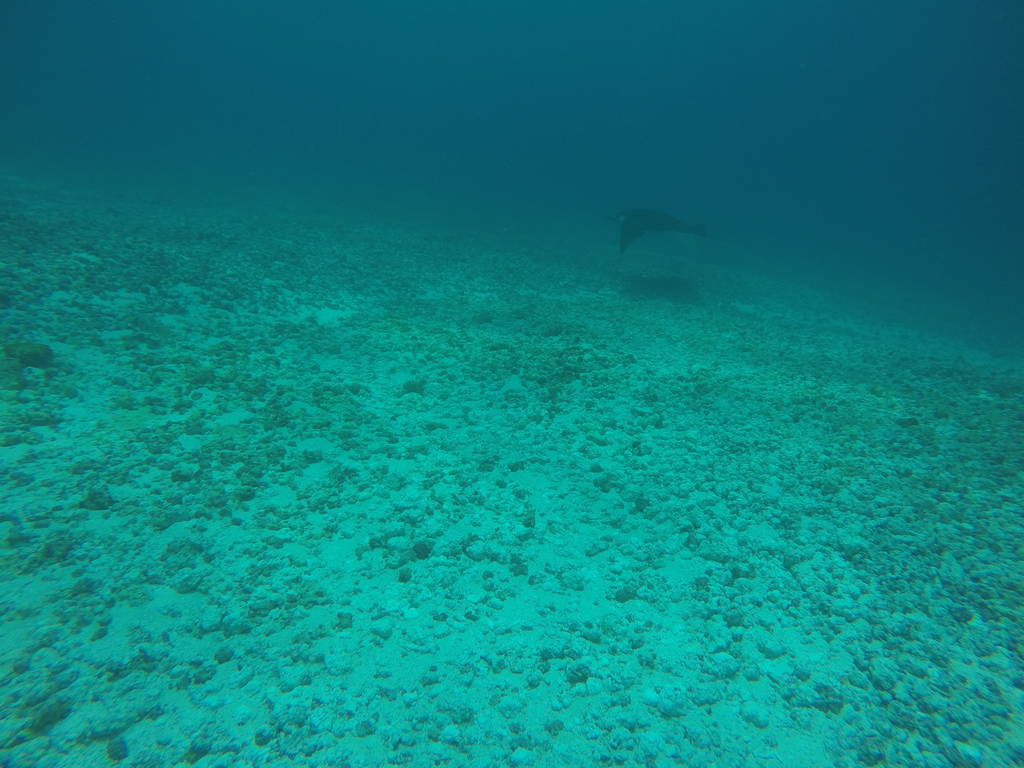
Walking with Lions in Mauritius
Mauritius, a island where you can explore the exquisiteness of nature, also encompasses a “fear factor,” called Walk with Lions at Casella Nature Park. It wasn’t an easy decision to take part in this, but we decided to do it as a memory to last a lifetime. Shivers ran down our spines when we had to fill out a disclaimer form taking responsibility for any untoward episodes. We also learned we had to defend ourselves with lean sticks as the only weapons for 45 minutes in the deep jungle!
With numerous directives from our guides, we heard the the huge lions known as Ginger and Mauli approach us from their protected area. Their gracious presence terrified us. But slowly they became a part of our troop, walking, rushing into the fields, and climbing the rocks. I was given the memory of a lifetime by being allowed to touch their manes and feed them. Ginger turned his head and eyes towards me, and with fear I closed mine. But in the next moment, he was nibbling the feed, and I was still safe. Soon we ended our walk and pledged to save these gracious cats. They are truly a wonder of the world, and it is an adventure you shouldn’t miss!
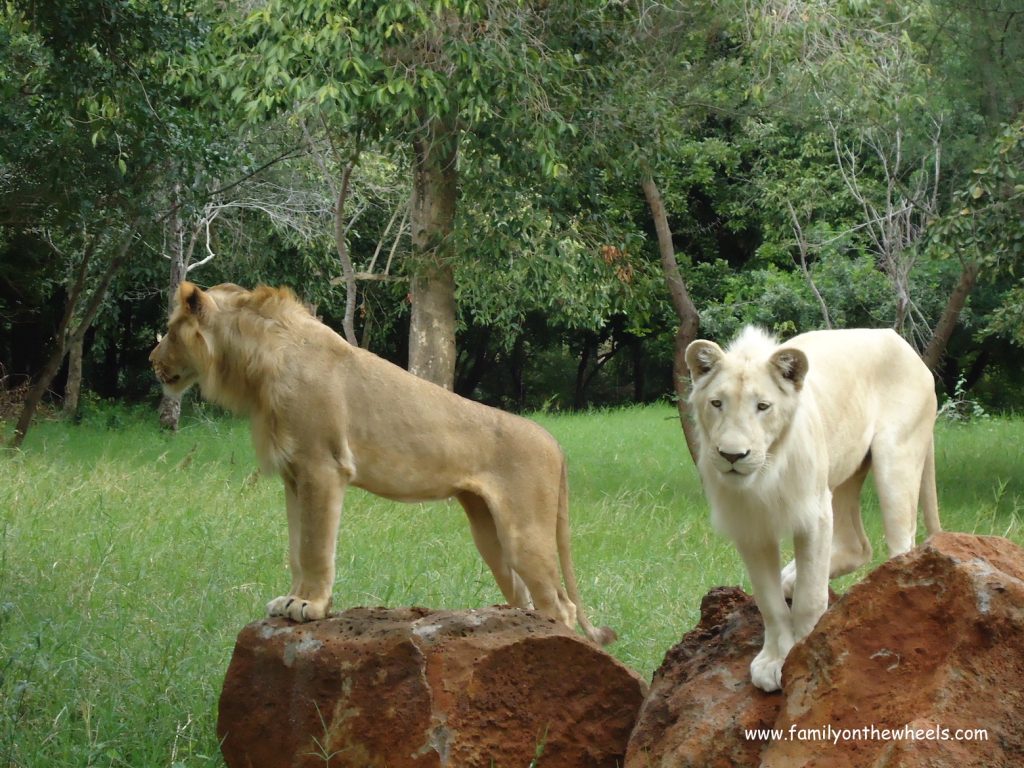
Chandresh Jain blogs at Family on the Wheels .
Swimming with Turtles in the Maldives
Maldives is famed for its crystal blue water and snorkeling, so it shouldn’t be surprising that it’s almost a guarantee to spot turtles in the ocean.
I was staying on the local island of Gaafaru 3 hours boat ride from the capital, where they offer a sea turtle snorkeling excursion. The locals know exactly where the beautiful creatures like to hang out. So it was as easy as hopping on a speedboat for thirty minutes to the area where they are commonly spotted.
The locals are no strangers to sea turtles, and the sea turtles didn’t seem to mind humans, either. We saw no less than five turtles during our snorkel, swimming alongside them as they come up for air. One even started to eat the food fed by the staff who accompanied us!
The turtles we saw were Hawksbill and Green turtle, though there are three more species of turtles out of the seven in Maldives. Generally, Green Turtles are larger and the patterns on the body are less prominent. While it’s exciting to spot the turtles, there are also plenty of fishes and other marine life in the area. We even saw an octopus hiding in the corals!
Nam blogs at Laugh, Travel, Eat .
The Elephant Jungle Sanctuary in Chiang Mai, Thailand
The Elephant Jungle Sanctuary is a sustainable eco-tourism project located in Chiang Mai, Thailand. It is a joint mission between people of the Karen-hill tribes and Chiang Mai Locals.
There are many places to see elephants around Thailand, but what appealed most to me about this one was their dedication to make a positive change in the way people see elephants. To reach a future where elephants are not poached, being rode on, used for entertainment or manual labor, and are instead treated with love.When you arrive at the sanctuary you are given a brief lesson about how Asian elephants are endangered and mistreated. What’s cool is that you get to wear traditional Karen-hill tribe clothing. When I asked the people from the tribe why they had similar shirts, they answered that the designs and colors make the elephants feel comfortable around anyone wearing it.
After the elephants come out. You’ll be amazed at how enormous they are if this is your first time seeing one up close. You begin by feeding them bananas and sugar cane. Afterwards you get into a mud bath with the elephants and massage their bodies. From there you lead them into a freshwater river where you clean off the mud from their massive bodies.
The reason all of this is done is because if elephants are left in the wild, it becomes almost impossible to interact with them. The bathing and mud spa show the elephants that we really care for them. A sign of trust and affection that the elephants can no doubt feel from us.
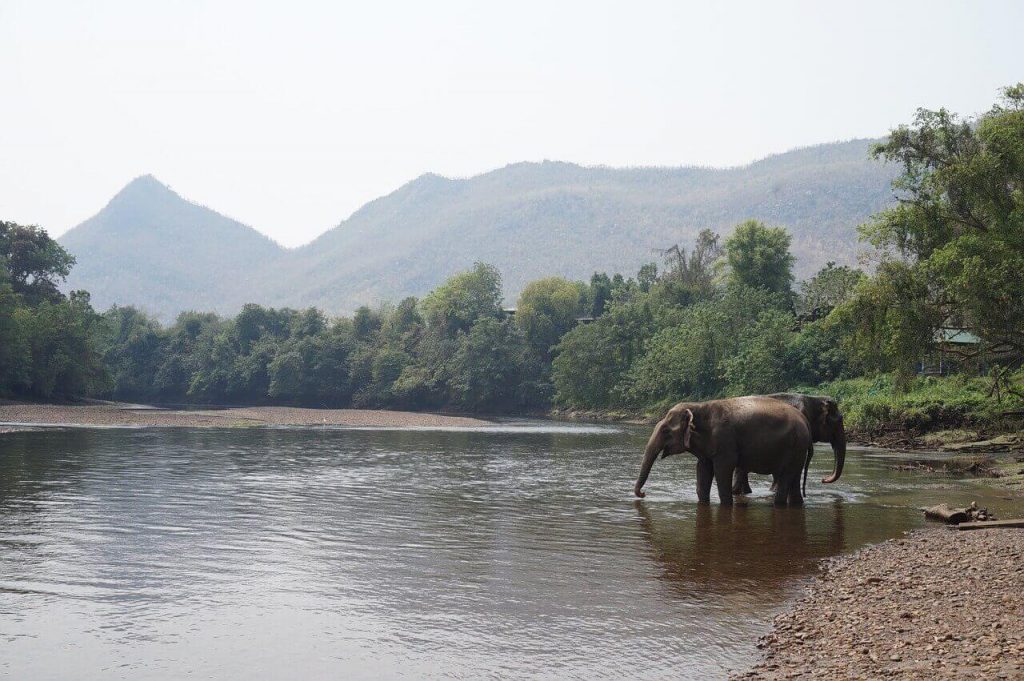
Best Places to See Wildlife in Australia
Spotting kangaroos and wallabies in cape hillsborough – queensland australia.
Have you seen those wonderful images of kangaroos and wallabies on a beach at sunrise that often appear in brochures for Australia, one of the best places to see wildlife? Invariably those images are taken on one beach in Queensland at Cape Hillsborough National Park. The park is located a short 30-minute drive north of Mackay in Northern Queensland.
The kangaroos and wallabies come down to the beach at dawn to feed on seed pods that are washed up onto the shore. To be sure to see the kangaroos you need to be on the beach before the sun rises. If you are able to do this in summer whilst it will be warmer you will need to be up a lot earlier. In winter it is cold, but you can have a slightly later start.
The kangaroos and wallabies spend about an hour on the beach feasting on the seed pods before returning to the shelter of the trees. Although they are used to people it is important to remember that they are wild animals – do not try to touch or feed them.
I have been to see the kangaroos on three different occasions – once in winter and twice in summer. Driving to the beach and parking up is so exciting as you don’t know how many kangaroos you will see. We have seen lots of joeys and kangaroos bounding down the beach.
Taking beautiful images of the kangaroos and wallabies at dawn remains a wonderful memory of those early mornings. And just appreciating the privilege of being so close to some of Australia’s most iconic animals is a dream come true.
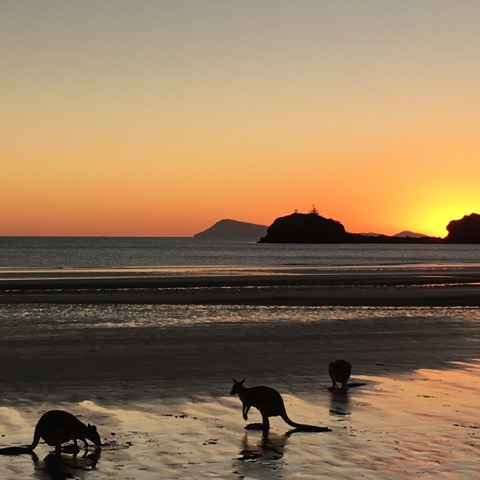
Tracy blogs at Tracy’s Travels in Time .

Crocodiles in Kakadu, Northern Territory, Australia
Apparently, there are over 100,000 wild crocodiles in Australia’s Northern Territory and around 10,000 of them live in Kakadu National Park.
One of the best places to see crocodiles is from the 2-hour Yellow Water River cruise along the Yellow Water Billabong.
During our cruise we saw 17 crocodiles! From 1 metre female crocodiles to giant monsters at over 5 metres. During the cruise the experienced guides educated the passengers about crocodile safety in Kakadu as well as told us stories of crocodile behaviour. The most impressive crocodile we saw was well over 5 metres and was slowing zig zagging up the billabong alongside the boat. In his mouth he had something large, submersed under the water which appeared to be a log. Our guide was quite intrigued as he said crocodiles don’t usually carry logs. Weren’t we all completely shocked when the crocodile brought his prized possession slightly above the water’s surface to reveal he was carrying a feral pig in his mouth! During our cruise we also saw wild brumbies, ducks, various bird species and snakes. The Yellow Water River Cruise was one of the highlights of our entire trip in the Northern Territory.
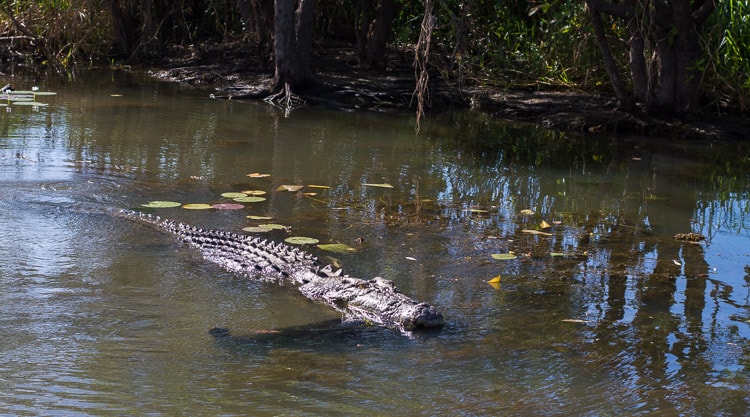
Melissa blogs at Thrifty Family Travels .
Koalas in Victoria, Australia
One of the best wildlife adventures in Australia has to be the marvelous koalas of Raymond Island, Victoria, Australia. This is certainly one of the best places to see wildlife in Australia.
Located on the eastern coast of Victoria in the Gippsland Lakes, and close to the popular town of Lakes Entrance, Raymond Island is easy for visitors to access. Passengers on foot can catch the regular car ferry from Paynesville across the waterway for free. Upon arriving, visitors quickly find themselves face-to-face with koalas mere metres away from the ferry landing point.
Follow the signs, located near resident homes in suburban streets, for a beautiful walk through a parkland of highly populated gumtrees. Here you can view hundreds of gorgeous koala bears eating, sleeping, arguing – even tending their very cute little baby passengers at the right time of year! Many koalas are sat in the very lowest branches of their trees, which allows visitors a wonderful opportunity to observe them at close range. The koalas themselves show little concern at being the centre of attention and continue on with the business of their everyday lives, seemingly unaffected. Few places in Australia offer such free and close-up access to these little grey bundles of fluff in the wild – Raymond Island is indeed a genuine wildlife adventure and certainly one of the best places to see wildlife !
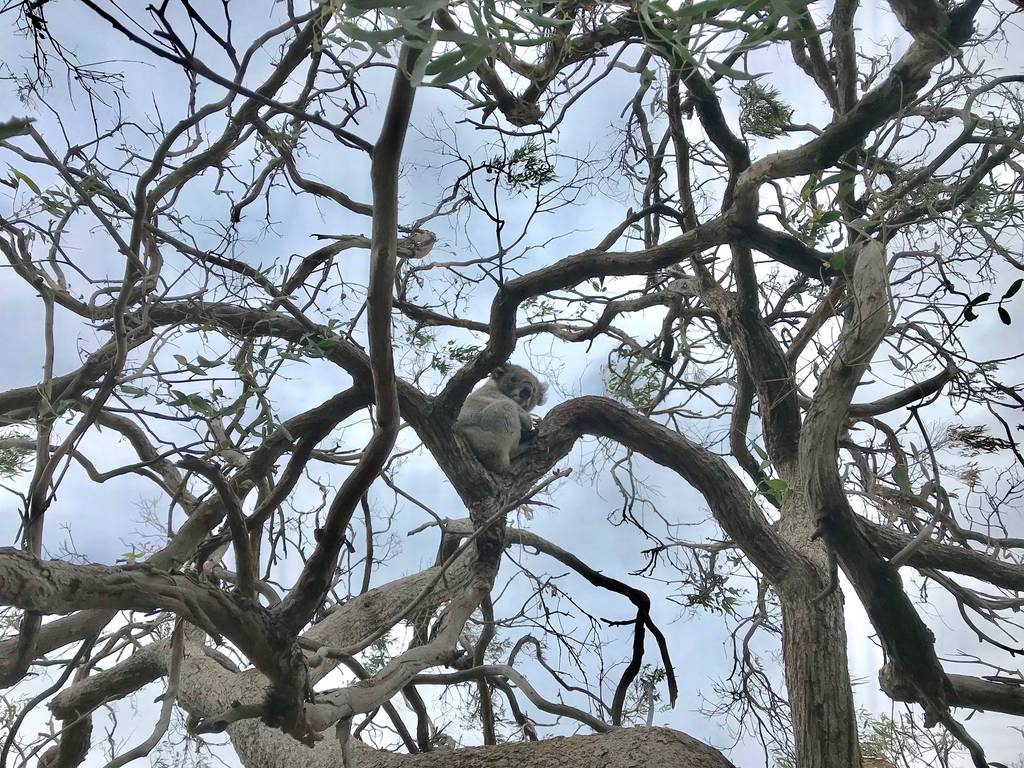
Barbara blogs at Let’s Go Mum .
Learn more about Asia’s wildlife . Check out Wildlife of Southeast Asia and Beyond the Last Village: A Journey of Discovery in Asia’s Forbidden Wilderness.
And don’t forget Australia’s unique wildlife: Wildlife of Australia and Watching Wildlife Australia : by Lonely Planet
This isn’t an exhaustive list of the best places to see wildlife in Asia and Australia . These books, Wildlife adventures in Africa and Wildlife Encounters in the Americas and Antarctica are also packed with amazing animals!

BTW, if you are getting ready for your trip, make sure to take advantage of these useful, money-saving links to book your trip:
- Research and book your flight with Skyscanner . I have found them to be the best because they list all airlines including the budget ones. You are always sure of having researched all options.
- For car rental around the world, Discover Cars has flexible pickup and drop-off options, I recommend Discover Cars .
- Book your accommodation with Booking.com . I find they have a wide selection and a nice, user-friendly, transparent website.
- Protect your trip and, more importantly, protect yourself with travel insurance. I use Travelinsurance.com and have been very happy with them.
- Looking for a small group tour to unforgettable destinations with top professionals? Intrepid Trave l is your choice.
- For more general tours to any destination or attraction, book with Viator . Check them out.
- Need a visa? Get your visa for all countries with Passport Visa Exp ress.
- Looking for a cool walking tour to explore a city? My favorite walking tours are offered by Take Walks.
- Food and drink tours are the best way to enjoy a city. And Devour Tours are my favorite.
- Looking for a good VPN to protect your security, privacy and freedom online while traveling? Nordvpn is your best option.
- The best and most economical way to stay connected while traveling is with an Airalo eSIM.
I personally use, and can recommend, all the companies listed here and elsewhere on my blog. By booking through these sites, the small commission we earn – at no cost to you – helps us maintain this site so we can continue to offer our readers valuable travel tips and advice.
Talek Nantes
7 responses.
I’ve been lucky enough to see quite a few of these but have added the missing ones to my list : )
Nice checklist of wildlife places in Asia and Australia. India alone is home to 50 tiger reserves and Bandipur National Park is one of the best forests to spot tigers.
Sounds like a fascinating place. Glad you liked the post.
Being a wildlife enthusiast I found your pick of list quite helpful and exciting. I’m gonna add some places you mentioned to my visit list. Really liked your article and glad to know your experience of Karnataka,India. I have been to Bandipur and Madumulai, my experience of Bandipur was better. Please do an article for African wildlife too. Thank you for sharing and keep up the great work.
Thanks for the nice comments. I’m glad you liked it. There is also a post on African wildlife on the site.
Great list of Asia wildlife preserves. Indonesia is my home country and I always wanted to visit Komodo National Park!
I’m also an aspiring writer and noticed you just published a book.. congratulations! It’s a great accomplishment.
Oh, how kind of you to say those nice comments. Thank you so much for taking the time to read and comment. So glad you enjoyed the post.
Leave a Reply Cancel reply
Your email address will not be published. Required fields are marked *
This site uses Akismet to reduce spam. Learn how your comment data is processed .

Disclosure: As an Amazon Associate I may earn from qualifying purchases. Posts may contain affiliate links. If you click on one of them, we may receive a commission at no cost to you.

Lets Connect
Privacy policy.
Change location (UK)
7 unforgettable wildlife experiences in southeast asia.

Vietnam, Cambodia and Laos are home to some magnificent scenery, including lofty mountains, lush jungles, wide plains, vast lakes and verdant river deltas. This amazingly varied topography has allowed a diverse array of wildlife to flourish – from great elephants to delicate orchids . There are a great variety of ways to get out into the countryside and interact with all this wildlife, but here are a few of our favourites to get you started .
1. Spot dolphins on the Mekong
The Mekong River is one of only a few places in the world to spot the endangered Irrawaddy dolphin in its natural habitat. Heading out from Kratie in Cambodia, you’ll float out on a small boat skippered by a local fisherman to an area 15 kilometres north of the town – one of the best places on the river to catch a glimpse of these elusive mammals.
The Irrawaddy dolphin population once numbered around 1,000 in this area, but after being hunted for their oils during the civil war there are now thought to be only 70 left.
On the way to spot Irrawaddy dolphins in Kratie.
2. See baby turtles hatch in Con Dao
The Con Dao Islands are a tiny pocket of paradise just an hour’s flight from Ho Chi Minh City . Most of the islands in the archipelago have national park status, and on the main island there is a protected breeding site where visitors can watch as hawksbill and green turtles inch their way up the beach to lay their eggs.
N.B. The nesting season is from April to September.
![wildlife tourism in asia Turtle_[85-ORIGINAL]](https://www.insideasiatours.com/sites/default/files/blog/2015/07/turtle_85-original.jpg)
A turtle on the beach on Con Dao Island.
3. Go bird-watching on Tonlé Sap Lake
Tonlé Sap is Southeast Asia’s largest freshwater lake, located at the heart of Cambodia. During peak season, the lake swells to an incredible six times its average dry-season size, engulfing the surrounding fields and forests and concealing the teetering supports of the area’s stilt houses.
For those with an ornithological bent, Tonlé Sap is a great place to spot all kinds of bird life, including black-headed ibis, painted storks, milky storks, greater and lesser adjutants, spot-billed pelicans, grey-headed fish eagles, cormorants and snakebirds. Visit the Prek Toal Bird Sanctuary for a chance of spotting these fascinating creatures.

Snakebird spotted at Tonle Sap Lake, Cambodia.
4. Meet the elephants in Cambodia & Laos
One of the most exciting wildlife experiences to enjoy in Southeast Asia is a meeting with the largest land animal in the world: the elephant. We have three favourite elephant sanctuaries where you can rest assured that the elephants are happy, healthy and well looked-after.
In Cambodia, the Mondulkiri Project exists to provide a home for retired working elephants – as well as to protect the natural habitat of the country’s few remaining wild elephants.
In Laos, meanwhile, animal-lovers can head to Mandalao , a conservation project 30 minutes from Luang Prabang , or the Sayaboury Elephant Conservation Centre , which is supported by the non-profit charity ElefantAsia . Feed, wash, and learn about these amazing animals while helping to support conservation efforts.

A resident of the sanctuary in Sayaboury.
5. Visit a bear sanctuary in Phnom Tmao
Run by the charity Free the Bears , this sanctuary 40 kilometres from Phnom Penh in Cambodia rescues bears from restaurants, poachers, hotels, bile farms and the pet trade.
The sanctuary has 21 enclosures built over seven hectares of land, housing a mixture of over 100 sun bears and Asiatic black bears. All of the enclosures are spacious, with climbing frames, toys and vegetation to keep the bears occupied and happy.
6. Diving at Ninh Van Bay or Con Dao
Last but not least, Southeast Asia has an incredible array of underwater life – and you can get up close and personal with it on a scuba diving trip to the magnificent reefs surrounding Vietnam. Our favourite spots for snorkelling and scuba are found at Ninh Van Bay and the Con Dao Islands.
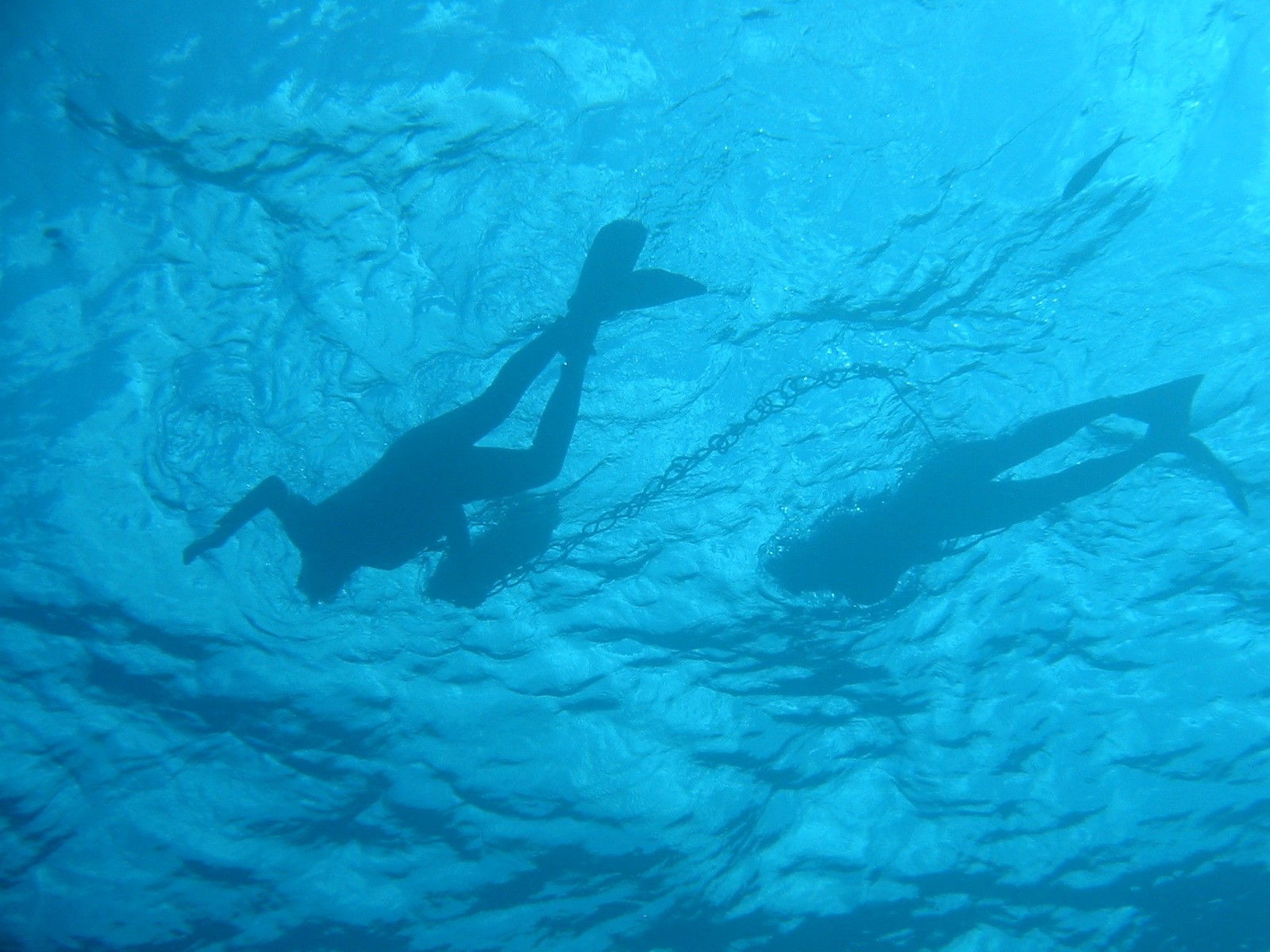
If you’ve been inspired by these wild experiences, you'll love our Wild Cambodia itinerary. Get in touch with our Southeast Asia travel experts to find out more.
You may also like

Everything you need to know about South Korean Convenience Stores

From how to work your way through the best Korean snacks and drinks on offer to clever hacks for anyone travelling with dietary requirements,...

Why we loved Busan: Two to Korea competition winners' trip round up
We recently ran a competition – called Two to Korea – offering up the chance for two lucky participants to win a 12-night adventure across...

The best breweries in South Korea
Luke Chritchlow Digital Marketing Executive
South Korea isn’t just fried chicken and K-pop. Nor is it just Soju and Squid Game. This nation has far more to offer the world, especially when...

- WILDLIFE WATCH
Suffering unseen: The dark truth behind wildlife tourism
Captive wild animal encounters are hugely popular, thanks partly to social media. But our investigation shows many creatures lead dismal lives.
I’ve come back to check on a baby. Just after dusk I’m in a car lumbering down a muddy road in the rain, past rows of shackled elephants, their trunks swaying. I was here five hours before, when the sun was high and hot and tourists were on elephants’ backs.
Walking now, I can barely see the path in the glow of my phone’s flashlight. When the wooden fence post of the stall stops me short, I point my light down and follow a current of rainwater across the concrete floor until it washes up against three large, gray feet. A fourth foot hovers above the surface, tethered tightly by a short chain and choked by a ring of metal spikes. When the elephant tires and puts her foot down, the spikes press deeper into her ankle.
Meena is four years and two months old, still a toddler as elephants go. Khammon Kongkhaw, her mahout, or caretaker, told me earlier that Meena wears the spiked chain because she tends to kick. Kongkhaw has been responsible for Meena here at Maetaman Elephant Adventure, near Chiang Mai, in northern Thailand, since she was 11 months old. He said he keeps her on the spiked shackle only during the day and takes it off at night. But it’s night now.
I ask Jin Laoshen, the Maetaman staffer accompanying me on this nighttime visit, why her chain is still on. He says he doesn’t know.

Maetaman is one of many animal attractions in and around tourist-swarmed Chiang Mai. People spill out of tour buses and clamber onto the trunks of elephants that, at the prodding of their mahouts’ bullhooks (long poles with a sharp metal hook), hoist them in the air while cameras snap. Visitors thrust bananas toward elephants’ trunks. They watch as mahouts goad their elephants—some of the most intelligent animals on the planet—to throw darts or kick oversize soccer balls while music blares.
Meena is one of Maetaman’s 10 show elephants. To be precise, she’s a painter. Twice a day, in front of throngs of chattering tourists, Kongkhaw puts a paintbrush in the tip of her trunk and presses a steel nail to her face to direct her brushstrokes as she drags primary colors across paper. Often he guides her to paint a wild elephant in the savanna. Her paintings are then sold to tourists.
Meena’s life is set to follow the same trajectory as many of the roughly 3,800 captive elephants in Thailand and thousands more throughout Southeast Asia. She’ll perform in shows until she’s about 10. After that, she’ll become a riding elephant. Tourists will sit on a bench strapped to her back, and she’ll give several rides a day. When Meena is too old or sick to give rides—maybe at 55, maybe at 75—she’ll die. If she’s lucky, she’ll get a few years of retirement. She’ll spend most of her life on a chain in a stall.

Wildlife attractions such as Maetaman lure people from around the world to be with animals like Meena, and they make up a lucrative segment of the booming global travel industry. Twice as many trips are being taken abroad as 15 years ago, a jump driven partly by Chinese tourists, who spend far more on international travel than any other nationality.
Wildlife tourism isn’t new, but social media is setting the industry ablaze, turning encounters with exotic animals into photo-driven bucket-list toppers. Activities once publicized mostly in guidebooks now are shared instantly with multitudes of people by selfie-taking backpackers, tour-bus travelers, and social media “influencers” through a tap on their phone screens. Nearly all millennials (23- to 38-year-olds) use social media while traveling. Their selfies—of swims with dolphins, encounters with tigers, rides on elephants, and more—are viral advertising for attractions that tout up-close experiences with animals.
For all the visibility social media provides, it doesn’t show what happens beyond the view of the camera lens. People who feel joy and exhilaration from getting close to wild animals usually are unaware that many of the animals at such attractions live a lot like Meena, or worse.
Photographer Kirsten Luce and I set out to look behind the curtain of the thriving wildlife tourism industry, to see how animals at various attractions—including some that emphasize their humane care of animals—are treated once the selfie-taking crowds have gone.
After leaving Maetaman, we take a five-minute car ride up a winding hill to a property announced by a wooden plaque as “Elephant EcoValley: where elephants are in good hands.” There are no elephant rides here. No paint shows or other performances. Visitors can stroll through an open-air museum and learn about Thailand’s national animal. They can make herbal treats for the elephants and paper from elephant dung. They can watch elephants in a grassy, tree-ringed field.
EcoValley’s guest book is filled with praise from Australians, Danes, Americans—tourists who often shun elephant camps such as Maetaman because the rides and shows make them uneasy. Here, they can see unchained elephants and leave feeling good about supporting what they believe is an ethical establishment. What many don’t know is that EcoValley’s seemingly carefree elephants are brought here for the day from nearby Maetaman—and that the two attractions are actually a single business.
Meena was brought here once, but she tried to run into the forest. Another young elephant, Mei, comes sometimes, but today she’s at Maetaman, playing the harmonica in the shows. When she’s not doing that, or spending the day at EcoValley, she’s chained near Meena in one of Maetaman’s elephant stalls.

Meena Kalamapijit owns Maetaman as well as EcoValley, which she opened in November 2017 to cater to Westerners. She says her 56 elephants are well cared for and that giving rides and performing allow them to have necessary exercise. And, she says, Meena the elephant’s behavior has gotten better since her mahout started using the spiked chain.
We sit with Kalamapijit on a balcony outside her office, and she explains that when Westerners, especially Americans, stopped coming to Maetaman, she eliminated one of the daily shows to allot time for visitors to watch elephants bathe in the river that runs through the camp.
“Westerners enjoy bathing because it looks happy and natural,” she says. “But a Chinese tour agency called me and said, ‘Why are you cutting the show? Our customers love to see it, and they don’t care about bathing at all.’ ” Providing separate options is good for business, Kalamapijit says.
Around the world Kirsten and I watched tourists watching captive animals. In Thailand we also saw American men bear-hug tigers in Chiang Mai and Chinese brides in wedding gowns ride young elephants in the aqua surf on the island of Phuket. We watched polar bears in wire muzzles ballroom dancing across the ice under a big top in Russia and teenage boys on the Amazon River snapping selfies with baby sloths.
Most tourists who enjoy these encounters don’t know that the adult tigers may be declawed, drugged, or both. Or that there are always cubs for tourists to snuggle with because the cats are speed bred and the cubs are taken from their mothers just days after birth. Or that the elephants give rides and perform tricks without harming people only because they’ve been “broken” as babies and taught to fear the bullhook. Or that the Amazonian sloths taken illegally from the jungle often die within weeks of being put in captivity.

A young elephant performs for an audience at Sriracha Tiger Zoo, in Chon Buri, Thailand. Elephants, highly intelligent mammals, are trained through fear with metal bullhooks to catch hoops, hold balloons, and balance on stools.
As we traveled to performance pits and holding pens on three continents and in the Hawaiian Islands, asking questions about how animals are treated and getting answers that didn’t always add up, it became clear how methodically and systematically animal suffering is concealed.
The wildlife tourism industry caters to people’s love of animals but often seeks to maximize profits by exploiting animals from birth to death. The industry’s economy depends largely on people believing that the animals they’re paying to watch or ride or feed are having fun too.
It succeeds partly because tourists—in unfamiliar settings and eager to have a positive experience—typically don’t consider the possibility that they’re helping to hurt animals. Social media adds to the confusion: Oblivious endorsements from friends and trendsetters legitimize attractions before a traveler ever gets near an animal.
There has been some recognition of social media’s role in the problem. In December 2017, after a National Geographic investigative report on harmful wildlife tourism in Amazonian Brazil and Peru, Instagram introduced a feature : Users who click or search one of dozens of hashtags, such as #slothselfie and #tigercubselfie, now get a pop-up warning that the content they’re viewing may be harmful to animals.

Everyone finds Olga Barantseva on Instagram. “Photographer from Russia. Photographing dreams,” her bio reads. She meets clients for woodland photo shoots with captive wild animals just outside Moscow.
For her 18th birthday, Sasha Belova treated herself to a session with Barantseva—and a pack of wolves. “It was my dream,” she says as she fidgets with her hair, which had been styled that morning. “Wolves are wild and dangerous.” The wolves are kept in small cages at a petting zoo when not participating in photo shoots.
The Kravtsov family hired Barantseva to take their first professional family photos—all five family members, shivering and smiling in the birch forest, joined by a bear named Stepan.
Barantseva has been photographing people and wild animals together for six years. She “woke up as a star,” she says, in 2015, when a couple of international media outlets found her online. Her audience has exploded to more than 80,000 followers worldwide. “I want to show harmony between people and animals,” she says.
On a raw fall day, under a crown of golden birch leaves on a hill that overlooks a frigid lake, two-and-a-half-year-old Alexander Levin, dressed in a hooded bumblebee sweater, timidly holds Stepan’s paw.
The bear’s owners, Yury and Svetlana Panteleenko, ply their star with food—tuna fish mixed with oatmeal—to get him to approach the boy. Snap: It looks like a tender friendship. The owners toss grapes to Stepan to get him to open his mouth wide. Snap: The bear looks as if he’s smiling.
The Panteleenkos constantly move Stepan, adjusting his paws, feeding him, and positioning Alexander as Barantseva, pink-haired, bundled in jeans and a parka, captures each moment. Snap: A photo goes to her Instagram feed. A boy and a bear in golden Russian woods—a picture straight out of a fairy tale. It’s a contemporary twist on a long-standing Russian tradition of exploiting bears for entertainment.
Another day in the same forest, Kirsten and I join 12 young women who have nearly identical Instagram accounts replete with dreamy photos of models caressing owls and wolves and foxes. Armed with fancy cameras but as yet modest numbers of followers, they all want the audience Barantseva has. Each has paid the Panteleenkos $760 to take identical shots of models with the ultimate prize: a bear in the woods.
Stepan is 26 years old, elderly for a brown bear, and can hardly walk. The Panteleenkos say they bought him from a small zoo when he was three months old. They say the bear’s work—a constant stream of photo shoots and movies—provides money to keep him fed.
A video on Svetlana Panteleenko’s Instagram account proclaims: “Love along with some great food can make anyone a teddy :-)”
And just like that, social media takes a single instance of local animal tourism and broadcasts it to the world.

When the documentary film Blackfish was released in 2013, it drew a swift and decisive reaction from the American public. Through the story of Tilikum, a distressed killer whale at SeaWorld in Orlando, Florida, the film detailed the miserable life orcas can face in captivity. Hundreds of thousands of outraged viewers signed petitions. Companies with partnership deals, such as Southwest Airlines, severed ties with SeaWorld. Attendance at SeaWorld’s water parks slipped; its stock nose-dived.
James Regan says what he saw in Blackfish upset him. Regan, honeymooning in Hawaii with his wife, Katie, is from England, where the country’s last marine mammal park closed permanently in 1993. I meet him at Dolphin Quest Oahu, an upscale swim-with-dolphins business on the grounds of the beachfront Kahala Hotel & Resort, just east of Honolulu. The Regans paid $225 each to swim for 30 minutes in a small group with a bottlenose dolphin. One of two Dolphin Quest locations in Hawaii, the facility houses six dolphins.
Bottlenose dolphins are the backbone of an industry that spans the globe. Swim-with-dolphins operations rely on captive-bred and wild-caught dolphins that live—and interact with tourists—in pools. The popularity of these photo-friendly attractions reflects the disconnect around dolphin experiences: People in the West increasingly shun shows that feature animals performing tricks, but many see swimming with captive dolphins as a vacation rite of passage.
Katie Regan has wanted to swim with dolphins since she was a child. Her husband laughs and says of Dolphin Quest, “They paint a lovely picture. When you’re in America, everyone is smiling.” But he appreciates that the facility is at their hotel, so they can watch the dolphins being fed and cared for. He brings up Blackfish again.
Katie protests: “Stop making my dream a horrible thing!”
Rae Stone, president of Dolphin Quest and a marine mammal veterinarian, says the company donates money to conservation projects and educates visitors about perils that marine mammals face in the wild. By paying for this entertainment, she says, visitors are helping captive dolphins’ wild cousins.
Stone notes that Dolphin Quest is certified “humane” by American Humane, an animal welfare nonprofit. (The Walt Disney Company, National Geographic’ s majority owner, offers dolphin encounters on some vacation excursions and at an attraction in Epcot, one of its Orlando parks. Disney says it follows the animal welfare standards of the Association of Zoos & Aquariums, a nonprofit that accredits more than 230 facilities worldwide.)
It’s a vigorous debate: whether even places with high standards, veterinarians on staff, and features such as pools filled with filtered ocean water can be truly humane for marine mammals.
Dolphin Quest’s Stone says yes.
Critics, including the Humane Society of the United States, which does not endorse keeping dolphins in captivity, say no. They argue that these animals have evolved to swim great distances and live in complex social groups—conditions that can’t be replicated in the confines of a pool. This helps explain why the National Aquarium, in Baltimore, announced in 2016 that its dolphins will be retired to a seaside sanctuary by 2020.
Some U.S. attractions breed their own dolphins because the nation has restricted dolphin catching in the wild since 1972. But elsewhere, dolphins are still being taken from the wild and turned into performers.
In China, which has no national laws on captive-animal welfare, dolphinariums with wild-caught animals are a booming business: There are now 78 marine mammal parks, and 26 more are under construction.

To have the once-in-a-lifetime chance to see rare Black Sea dolphins, people in the landlocked town of Kaluga, a hundred miles from Moscow, don’t have to leave their city. In the parking lot of the Torgoviy Kvartal shopping mall, next to a hardware store, is a white inflatable pop-up aquarium: the Moscow Traveling Dolphinarium. It looks like a children’s bouncy castle that’s been drained of its color.
Inside the puffy dome, parents buy their kids dolphin-shaped trinkets: fuzzy dolls and Mylar balloons, paper dolphin hats, and drinks in plastic dolphin tumblers. Families take their seats around a small pool. The venue is so intimate that even the cheapest seats, at nine dollars apiece, are within splashing distance.
“My kids are jumping for joy,” says a woman named Anya, motioning toward her two giddy boys, bouncing in their seats.
In the middle of the jubilant atmosphere, in water that seems much too shallow and much too murky, two dolphins swim listlessly in circles.
Russia is one of only a few countries (Indonesia is another) where traveling oceanariums exist. Dolphins and beluga whales, which need to be immersed in water to stay alive, are put in tubs on trucks and carted from city to city in a loop that usually ends when they die. These traveling shows are aboveboard: Russia has no laws that regulate how marine mammals should be treated in captivity.
The shows are the domestic arm of a brisk Russian global trade in dolphins and small whales. Black Sea bottlenose dolphins can’t be caught legally without a permit, but Russian fishermen can catch belugas and orcas under legal quotas in the name of science and education. Some belugas are sold legally to aquariums around the country. Russia now allows only a dozen or so orcas to be caught each year for scientific and educational purposes, and since April 2018, the government has cracked down on exporting them. But government investigators believe that Russian orcas—which can sell for millions—are being caught illegally for export to China.
Captive orcas, which can grow to 20 feet long and more than 10,000 pounds, are too big for the traveling shows that typically feature dolphins and belugas. When I contacted the owners of the Moscow Traveling Dolphinarium and another operation, the White Whale Show, in separate telephone calls to ask where their dolphins and belugas come from, both men, Sergey Kuznetsov and Oleg Belesikov, hung up on me.

Russia’s dozen or so traveling oceanariums are touted as a way to bring native wild animals to people who might never see the ocean.
You May Also Like

Why we’re shining a light on wildlife tourism

As extreme weather ramps up, animal rescuers are struggling to save our pets

‘Selfie’ flamingos in Caribbean resorts are being returned to the wild
“Who else if not us?” says Mikhail Olyoshin, a staffer at one traveling oceanarium. And on this day in Kaluga, as the dolphins perform tricks to American pop songs and lie on platforms for several minutes for photo ops, parents and children express the same sentiment: Imagine, dolphins, up close, in my hometown. The ocean on delivery.
Owners and operators of wildlife tourism attractions, from high-end facilities such as Dolphin Quest in Hawaii to low-end monkey shows in Thailand, say their animals live longer in captivity than wild counterparts because they’re safe from predators and environmental hazards. Show operators proudly emphasize that the animals under their care are with them for life. They’re family.
Alla Azovtseva, a longtime dolphin trainer in Russia, shakes her head.
“I don’t see any sense in this work. My conscience bites me. I look at my animals and want to cry,” says Azovtseva, who drives a red van with dolphins airbrushed on the side. At the moment, she’s training pilot whales to perform tricks at Moscow’s Moskvarium, one of Europe’s largest aquariums (not connected to the traveling dolphin shows). On her day off, we meet at a café near Red Square.
She says she fell in love with dolphins in the late 1980s when she read a book by John Lilly, the American neuroscientist who broke open our understanding of the animals’ intelligence. She has spent 30 years training marine mammals to do tricks. But along the way she’s grown heartsick from forcing highly intelligent, social creatures to live isolated, barren lives in small tanks.
“I would compare the dolphin situation with making a physicist sweep the street,” she says. “When they’re not engaged in performance or training, they just hang in the water facing down. It’s the deepest depression.”
What people don’t know about many aquarium shows in Russia, Azovtseva says, is that the animals often die soon after being put in captivity, especially those in traveling shows. And Azovtseva—making clear she’s referring to the industry at large in Russia and not the Moskvarium—says she knows many aquariums quietly and illegally replace their animals with new ones.
It’s been illegal to catch Black Sea dolphins in the wild for entertainment purposes since 2003, but according to Azovtseva, aquarium owners who want to increase their dolphin numbers quickly and cheaply buy dolphins poached there. Because these dolphins are acquired illegally, they’re missing the microchips that captive cetaceans in Russia are usually tagged with as a form of required identification.
Some aquariums get around that, she says, by cutting out dead dolphins’ microchips and implanting them into replacement dolphins.
“People are people,” Azovtseva says. “Once they see an opportunity, they exploit.” She says she can’t go on doing her work in the industry and that she’s decided to speak out because she wants people to know the truth about the origins and treatment of many of the marine mammals they love watching. We exchange a look—we both know what her words likely mean for her livelihood.
“I don’t care if I’m fired,” she says defiantly. “When a person has nothing to lose, she becomes really brave.”

I'm sitting on the edge of an infinity pool on the hilly Thai side of Thailand’s border with Myanmar, at a resort where rooms average more than a thousand dollars a night.
Out past the pool, elephants roam in a lush valley. Sitting next to me is 20-year-old Stephanie, who asked not to use her last name. She’s Dutch and French, Tokyo born and raised, and a student at the University of Michigan. Her cosmopolitan background and pretty face make for a perfect cocktail of aspiration—she’s exactly the kind of Instagrammer who makes it as an influencer. That is, someone who has a large enough following to attract sponsors to underwrite posts and, in turn, travel, wardrobes, and bank accounts. In 2018, brands—fashion, travel, tech, and more—spent an estimated $1.6 billion on social media advertising by influencers.
Stephanie has been here, at the Anantara Golden Triangle Elephant Camp & Resort, before. This time, in a fairly standard influencer-brand arrangement, she’ll have a picnic with elephants and post about it to her growing legion of more than 25,000 Instagram followers. In exchange, she gets hundreds of dollars off the nightly rate.
At Anantara the fields are green, and during the day at least, many of the resort’s 22 elephants are tethered on ropes more than a hundred feet long so they can move around and socialize. Nevertheless, they’re expected to let guests touch them and do yoga beside them.
After Stephanie's elephant picnic, I watch her edit the day’s hundreds of photos. She selects an image with her favorite elephant, Bo. She likes it, she says, because she felt a connection with Bo and thinks that will come across. She posts it at 9:30 p.m.—the time she estimates the largest number of her followers will be online. She includes a long caption, summing it up as “my love story with this incredible creature,” and the hashtag #stopelephantriding. Immediately, likes from followers stream in—more than a thousand, as well as comments with heart-eyed emoji.
Anantara is out of reach for anyone but the wealthy—or prominent influencers. Anyone else seeking a similar experience might do a Google search for, say, “Thailand elephant sanctuary.”
As tourist demand for ethical experiences with animals has grown, affordable establishments, often calling themselves “sanctuaries,” have cropped up purporting to offer humane, up-close elephant encounters. Bathing with elephants—tourists give them a mud bath, splash them in a river, or both—has become very popular. Many facilities portray baths as a benign alternative to elephant riding and performances. But elephants getting baths, like those that give rides and do tricks, will have been broken to some extent to make them obedient. And as long as bathing remains popular, places that offer it will need obedient elephants to keep their businesses going.

In Ban Ta Klang, a tiny town in eastern Thailand, modest homes dot the crimson earth. In front of each is a wide, bamboo platform for sitting, sleeping, and watching television.
But the first thing I notice is the elephants. Some homes have one, others as many as five. Elephants stand under tarps or sheet metal roofs or trees. Some are together, mothers and babies, but most are alone. Nearly all the elephants wear ankle chains or hobbles—cuffs binding their front legs together. Dogs and chickens weave among the elephants’ legs, sending up puffs of red dust.
Ban Ta Klang—known as Elephant Village—is ground zero in Thailand for training and trading captive elephants.
“House elephants,” Sri Somboon says, gesturing as he turns down his TV. Next to his outdoor platform, a two-month-old baby elephant runs around his mother. Somboon points across the road to the third elephant in his charge, a three-year-old male tethered to a tree. He’s wrenching his head back and forth and thrashing his trunk around. It looks as if he’s going out of his mind.
He’s in the middle of his training, Somboon says, and is getting good at painting. He’s already been sold, and when his training is finished, he’ll start working at a tourist camp down south.
Ban Ta Klang and the surrounding area, part of Surin Province, claim to be the source of more than half of Thailand’s 3,800 captive elephants. Long before the flood of tourists, it was the center of the elephant trade; the animals were caught in the wild and tamed for use transporting logs. Now, every November, hundreds of elephants from here are displayed, bought, and sold in the province’s main town, Surin.
One evening I sit with Jakkrawan Homhual and Wanchai Sala-ngam. Both 33, they’ve been best friends since childhood. About half the people in Ban Ta Klang who care for elephants, including Homhual, don’t own them. They’re paid a modest salary by a rich owner to breed and train baby elephants for entertainment. As night falls, thousands of termites swarm us, attracted to the single bulb hanging above the bamboo platform. Our conversation turns to elephant training.
Phajaan is the traditional—and brutal—days- or weeks-long process of breaking a young elephant’s spirit. It has long been used in Thailand and throughout Southeast Asia to tame wild elephants, which still account for many of the country’s captives. Under phajaan, elephants are bound with ropes, confined in tight wooden structures, starved, and beaten repeatedly with bullhooks, nails, and hammers until their will is crushed. The extent to which phajaan persists in its harshest form is unclear. Since 2012, the government has been cracking down on the illegal import of elephants taken from the forests of neighboring Myanmar, Thailand’s main source of wild-caught animals.
I ask the men how baby elephants born in captivity are broken and trained.
When a baby is about two years old, they say, mahouts tie its mother to a tree and slowly drag the baby away. Once separated, the baby is confined. Using a bullhook on its ear, they teach the baby to move: left, right, turn, stop. To teach an elephant to sit, Sala-ngam says, “we tie up the front legs. One mahout will use a bullhook at the back. The other will pull a rope on the front legs.” He adds: “To train the elephant, you need to use the bullhook so the elephant will know.”
Humans identify suffering in other humans by universal signs: People sob, wince, cry out, put voice to their hurt. Animals have no universal language for pain. Many animals don’t have tear ducts. More creatures still—prey animals, for example—instinctively mask symptoms of pain, lest they appear weak to predators. Recognizing that a nonhuman animal is in pain is difficult, often impossible.
But we know that animals feel pain. All mammals have a similar neuroanatomy. Birds, reptiles, and amphibians all have pain receptors. As recently as a decade ago, scientists had collected more evidence that fish feel pain than they had for neonatal infants. A four-year-old human child with spikes pressing into his flesh would express pain by screaming. A four-year-old elephant just stands there in the rain, her leg jerking in the air.
Of all the silently suffering animals I saw in pools and pens around the world, two in particular haunt me: an elephant and a tiger.
They lived in the same facility, Samut Prakan Crocodile Farm and Zoo, about 15 miles south of Bangkok. The elephant, Gluay Hom, four years old, was kept under a stadium. The aging tiger, Khai Khem, 22, spent his days on a short chain in a photo studio. Both had irrefutable signs of suffering: The emaciated elephant had a bent, swollen leg hanging in the air and a large, bleeding sore at his temple. His eyes were rolled back in his head. The tiger had a dental abscess so severe that the infection was eating through the bottom of his jaw.
When I contacted the owner of the facility, Uthen Youngprapakorn, to ask about these animals, he said the fact that they hadn’t died proved that the facility was caring for them properly. He then threatened a lawsuit.
Six months after Kirsten and I returned from Thailand, we asked Ryn Jirenuwat, our Bangkok-based Thai interpreter, to check on Gluay Hom and Khai Khem. She went to Samut Prakan and watched them for hours, sending photos and video. Gluay Hom was still alive, still standing in the same stall, leg still bent at an unnatural angle. The elephants next to him were skin and bones. Khai Khem was still chained by his neck to a hook in the floor. He just stays in his dark corner, Jirenuwat texted, and when he hears people coming, he twists on his chain and turns his back to them.
“Like he just wants to be swallowed by the wall.”
Related Topics
- WILDLIFE CRIME
- ANIMAL RESCUE

They rely on this lizard to heal their pain. Now it’s endangered.

U.S. charges poaching ring allegedly involved in massive Utah dinosaur bone heist

6 important new laws helping animals in 2024

The shark ray is vanishing from our oceans—and being made into jewelry

Wildlife crime is a national security issue—and Homeland Security is on the case
- Best of the World
- Environment
- Paid Content
History & Culture
- History & Culture
- Out of Eden Walk
- Mind, Body, Wonder
- Terms of Use
- Privacy Policy
- Your US State Privacy Rights
- Children's Online Privacy Policy
- Interest-Based Ads
- About Nielsen Measurement
- Do Not Sell or Share My Personal Information
- Nat Geo Home
- Attend a Live Event
- Book a Trip
- Inspire Your Kids
- Shop Nat Geo
- Visit the D.C. Museum
- Learn About Our Impact
- Support Our Mission
- Advertise With Us
- Customer Service
- Renew Subscription
- Manage Your Subscription
- Work at Nat Geo
- Sign Up for Our Newsletters
- Contribute to Protect the Planet
Copyright © 1996-2015 National Geographic Society Copyright © 2015-2024 National Geographic Partners, LLC. All rights reserved

Explore Exotic Islands With Unique Wildlife At This Lesser-Known National Park In Asia
I ndonesia may be famous for having some of the best beaches in the world , but its islands also hold a variety of incredible wildlife that you won't find anywhere else on Earth. One such extraordinary island is Java, which features Ujung Kulon National Park , home to the endangered one-horned Javan rhinoceros (pictured above), tucked away on the Southwestern end. It has been designated a UNESCO-listed World Heritage site due to its rainforests, geology, and outstanding beauty. The park also encompasses three additional islands - Panaitan, Peucang, and Handeuleum.
Java is truly special, and it inspired filmmakers like renowned naturalist David Attenborough in 1965 when his "Zoo Quest for a Dragon" documentary about the island's lizards came out. "Monty Python" actor Michael Palin visited for his "Full Circle" series, and the BBC made a documentary called "The Jungle Gremlins of Java centered on Java's slow loris. Even though this tropical island may seem far away from better-known Indonesian destinations like Bali, seeing its out-of-this-world wildlife is well worth the trip.
Read more: 50 Of The Most Mesmerizing Places On Earth
Preparing For Your Journey To Ujung Kulon National Park
Most visitors start their journey to Ujung Kulon National Park in the Javan city of Labuan or its nearby Carita Beach resort area. You can book a tour or transport to get to the park from both of these places. You can also get a motorboat to one of the islands or a bus to the entrance village of Tamanjaya. The bus journey from Labuan to the park takes around five hours.
If you don't have a tour booked, you have the option to arrange a boat trip and guide from Tamanjaya or by going directly to the park's office. There are guesthouses to stay in on the islands or in Tamanjaya. While at the park, you won't just see jungle animals, as there are coral reefs at Peucang Island to spot tropical fish, so bring your snorkeling gear. There is so much to explore that you could easily spend three to four days or even longer looking for the awe-inspiring wildlife that thrives in this lesser-known paradise.
Wildlife In Ujung Kulon National Park
Aside from Ujung Kulon's epic geography, plant life, and islands, the wildlife is the main draw for those visiting this park. The critically endangered Javan rhino, which still breeds there, is the most famous animal in the area. You may see other large mammals, too, including banteng (a wild cattle species), dhole (a wild dog), leopards, deer, and wild pigs.
Two primate species that are endemic to the island are the Javan gibbon and the Javan leaf monkey. Other smaller mammals found there are the leopard cat, previously mentioned slow loris, otters, squirrels, civets, and the Javan mongoose. Reptiles that you may see include crocodiles, monitor lizards, and green turtles that nest on the beaches. It is also an incredible place for birdwatching, with opportunities to see kingfishers, babblers, woodpeckers, honeyeaters, and sunbirds, amongst other species. If you love marine life, consider combining your trip with the Wakatobi National Park near Tomia Island, which has some of the best dive spots in the world .
Read the original article on Explore .


Countries In North Asia: Travel Guide
When it comes to countries in North Asia, there are several diverse and culturally rich nations to explore. From the bustling metropolises of Japan and South Korea to the stunning landscapes of Mongolia and the natural beauty of Russia’s Siberian region, North Asia offers a wide range of experiences for travelers.
Whether you’re interested in history, technology, or outdoor adventures, the countries in North Asia have something for everyone.
Understanding the unique characteristics and attractions of each North Asian country can help you plan an unforgettable journey. Japan, for example, is known for its blend of traditional culture and modern innovation, while South Korea offers delicious cuisine, ancient temples, and vibrant cities.
Mongolia’s nomadic heritage and vast, untouched wilderness provide a completely different travel experience, and Russia’s far eastern region is home to stunning natural landscapes and a rich history of exploration and discovery.
By delving into the distinct offerings of each country in North Asia, you can gain a deeper appreciation for this dynamic and fascinating region. From the dynamic cities to the unspoiled natural wonders, the countries in North Asia have much to offer in terms of culture, history, and adventure.
Whether you’re a seasoned traveler or planning your first trip to the region, North Asia is sure to leave a lasting impression.
Understanding North Asia
Definition of north asia.
North Asia refers to the northern part of the Asian continent, encompassing countries such as Russia, Mongolia, Kazakhstan, and others. This region is characterized by its vast landmass, extreme climate, and rich cultural diversity.
It plays a significant role in global geopolitics and economic development, given its abundant natural resources and strategic location.
Geographic boundaries
Geographically, North Asia is bordered by the Arctic Ocean to the north, Eastern Europe to the west, Central and East Asia to the south, and the Pacific Ocean and North America to the east. This expansive area features diverse landscapes, including mountain ranges, extensive plains, and freshwater environments.
The region’s boundary with Siberia is demarcated by the Yenisey River, while the southern areas exhibit subtropical conditions.
Distinct characteristics of North Asian countries
The countries in North Asia exhibit distinct characteristics shaped by their geographical locations and historical influences. For instance, Russia, as the largest country in the region, boasts expansive tundra and taiga landscapes, while Mongolia’s nomadic culture thrives in its vast steppes.
Additionally, Kazakhstan’s rich history and resource abundance contribute to its unique identity within North Asia.
Understanding North Asia entails recognizing its diverse countries, vast geographical boundaries, and unique characteristics, which collectively contribute to the region’s rich tapestry of culture, history, and natural landscapes.

Historical Significance
The influence of North Asian countries in history can be traced back to the Bronze Age during the 3rd millennium BCE, characterized by the infusion of Indo-Iranian cultures seen in the Andronovo culture. This led to the development of unique cultural and societal norms that have significantly shaped the region.
Influence of North Asian countries in history
North Asian countries have played a pivotal role in shaping the course of history, especially during the 1st millennium. They have contributed to the advancement of art, literature, and trade, leaving a lasting impact on the cultural landscape.
Major events in North Asia
One of the major events in North Asia was the reign of the great Turko-Mongolian conqueror, Timur (Tamerlane), from 1370 to 1405. His rule not only established dominance in Central Asia but also led to a brilliant period of Islamic art, marking a significant chapter in the history of the region.
Impact on global history
The impact of North Asian countries on global history has been profound. Their contributions to the world economy and the globalization process have established North Asia as a vital player on the global stage, influencing the economic, political, and cultural dynamics worldwide.

Cultural Diversity
Diversity of cultures in north asian countries.
North Asian countries are rich in cultural diversity, with each nation boasting a unique tapestry of traditions, languages, and customs. From the nomadic heritage of Mongolia to the ancient rituals of the Korean Peninsula, the region is a melting pot of diverse cultural influences.
Each country’s distinct history and geographical features have shaped their traditions, creating a fascinating mosaic of cultural heritage.
Traditional practices and customs
The traditional practices and customs in North Asian countries are deeply rooted in history and folklore. For example, in Japan, the art of tea ceremonies and the significance of cherry blossom festivals are integral parts of their heritage.
Similarly, the nomadic customs of the Mongolian people, such as eagle hunting and traditional throat singing, showcase a unique way of life that has endured for centuries. These traditions offer a window into the rich cultural tapestry of North Asia.
Modern cultural influences
In recent years, North Asian countries have experienced a wave of modern cultural influences, blending traditional customs with contemporary expressions. K-pop from South Korea has captivated global audiences with its vibrant music and fashion, while Japan’s anime and manga have become iconic symbols of modern pop culture.
Moreover, the fusion of traditional art forms with modern innovation has given rise to a dynamic cultural landscape that resonates with both locals and international admirers.

Economic Landscape
Major industries in north asia.
North Asia is home to diverse and thriving industries, with a prominent focus on manufacturing and technology. Countries in this region, such as China, Japan, South Korea, and Taiwan, are renowned for their advanced manufacturing sectors, producing cutting-edge electronics, automotive parts, and machinery.
Additionally, these nations excel in the production of steel, chemical products, and textiles, contributing significantly to the global supply chain.
Economic growth and development
The economic growth and development in North Asia have been remarkable, driven by technological advancements and strategic investments. Countries like South Korea and Taiwan have successfully transitioned into high-income economies, showcasing rapid industrialization and innovation.
Furthermore, China’s robust economic expansion has propelled it into a global economic powerhouse, shaping the landscape of international trade and commerce.
Trade partnerships and international relations
North Asian countries have forged impactful trade partnerships and solidified international relations with numerous global entities. China, as a key player, has strategically engaged in trade agreements with countries across the globe, positioning itself as a major trading partner.
Additionally, Japan’s strong diplomatic ties and technological expertise have enabled it to establish significant trade relations in diverse sectors, contributing to the region’s economic vitality.
These dynamic developments reflect the resilience and influence of North Asia’s economic landscape, paving the way for continued prosperity and global impact.
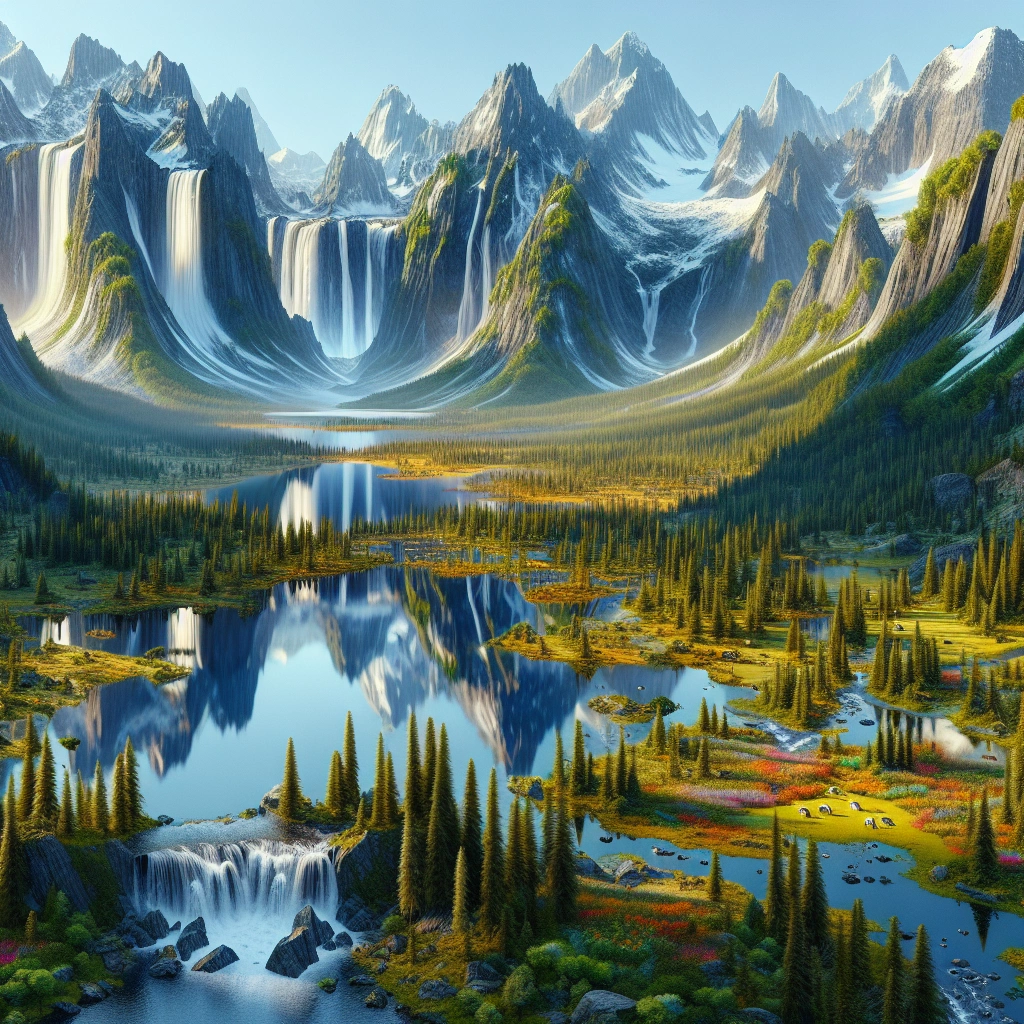
Natural Wonders
Unique landscapes and natural attractions.
The countries in North Asia boast unique and breathtaking natural landscapes and attractions. From the stunning beauty of Lake Baikal in Russia to the otherworldly landscapes of Cappadocia in Turkey, the region offers a diverse range of natural wonders.
The icy tundra of Siberia, the majestic peaks of the Himalayas, and the lush forests of Mongolia showcase the remarkable diversity of landscapes waiting to be explored in North Asia.
Environmental conservation efforts
Environmental conservation efforts in the countries of North Asia are crucial to preserving these natural wonders. Organizations and governments in these nations have been actively working towards protecting and preserving their unique and diverse ecosystems.
From wildlife reserves to national parks and protected areas, sustainable conservation efforts play a vital role in maintaining the integrity and beauty of the region’s natural landscapes.
Outdoor activities and adventures
North Asia offers an array of thrilling outdoor activities and adventures set amidst its stunning natural landscapes. Whether it’s trekking through the rugged terrains of the Himalayas, exploring the ancient forests of Siberia, or experiencing the unique culture and wildlife of Mongolia, the region provides endless opportunities for outdoor enthusiasts to immerse themselves in unforgettable adventures.
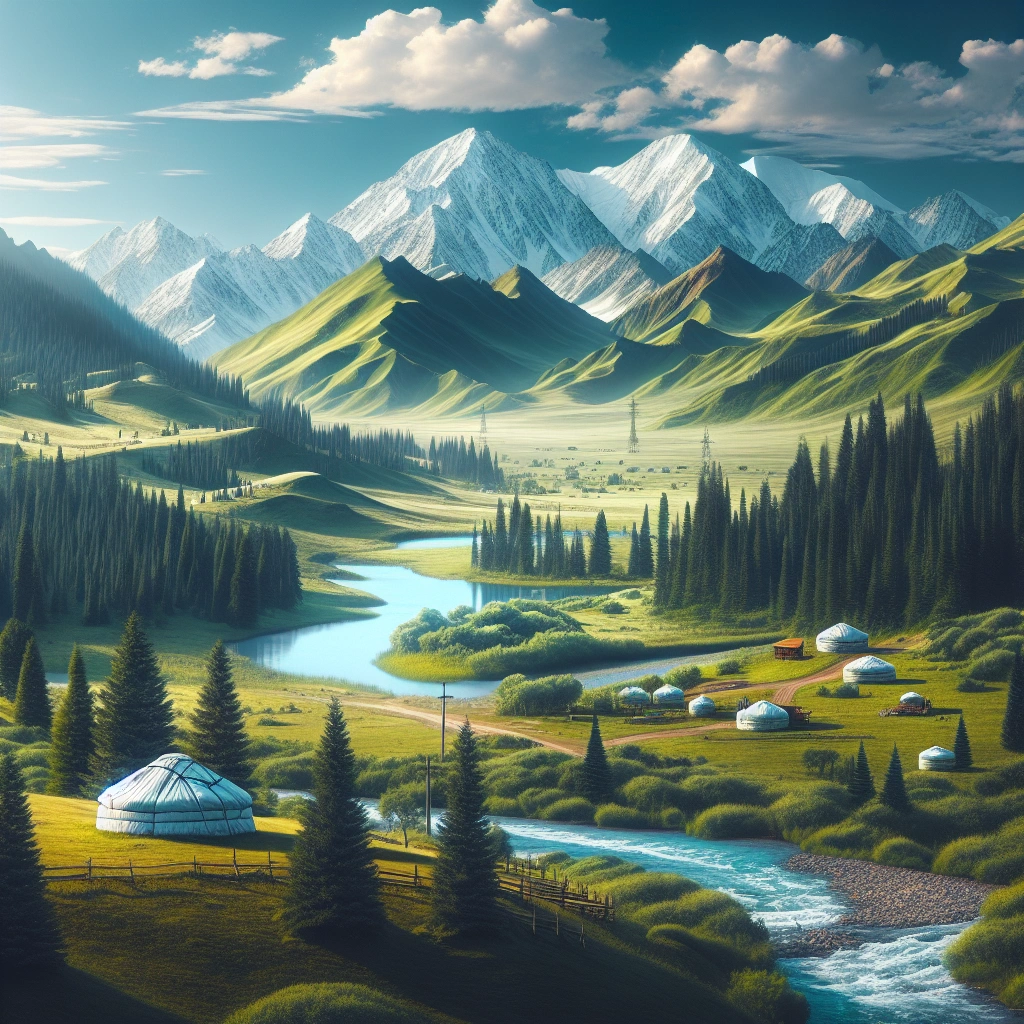
Traveling to North Asia
Visa requirements and travel restrictions.
To travel to North Asian countries, you would need a visa for countries such as China, Russia, Mongolia, and South Korea. Each country has its own specific visa requirements, so it’s essential to check with the respective embassy or consulate before making any travel plans.
Transportation options within North Asian countries
Transportation options within North Asian countries vary but generally include reliable public transportation systems such as trains and buses. In some countries, like Japan and South Korea, high-speed trains are a popular and efficient mode of transportation for intercity travel.
Additionally, taxis, motorcycle taxis, and rental vehicles are readily available in major cities for convenient local commuting.
Accommodation choices and recommendations
When it comes to accommodation choices, North Asian countries offer a diverse range of options, including luxury hotels, budget-friendly hostels, traditional ryokans, and cozy guesthouses. For those seeking a unique experience, staying in a traditional Japanese ryokan or a Korean hanok can provide an authentic and immersive cultural experience.
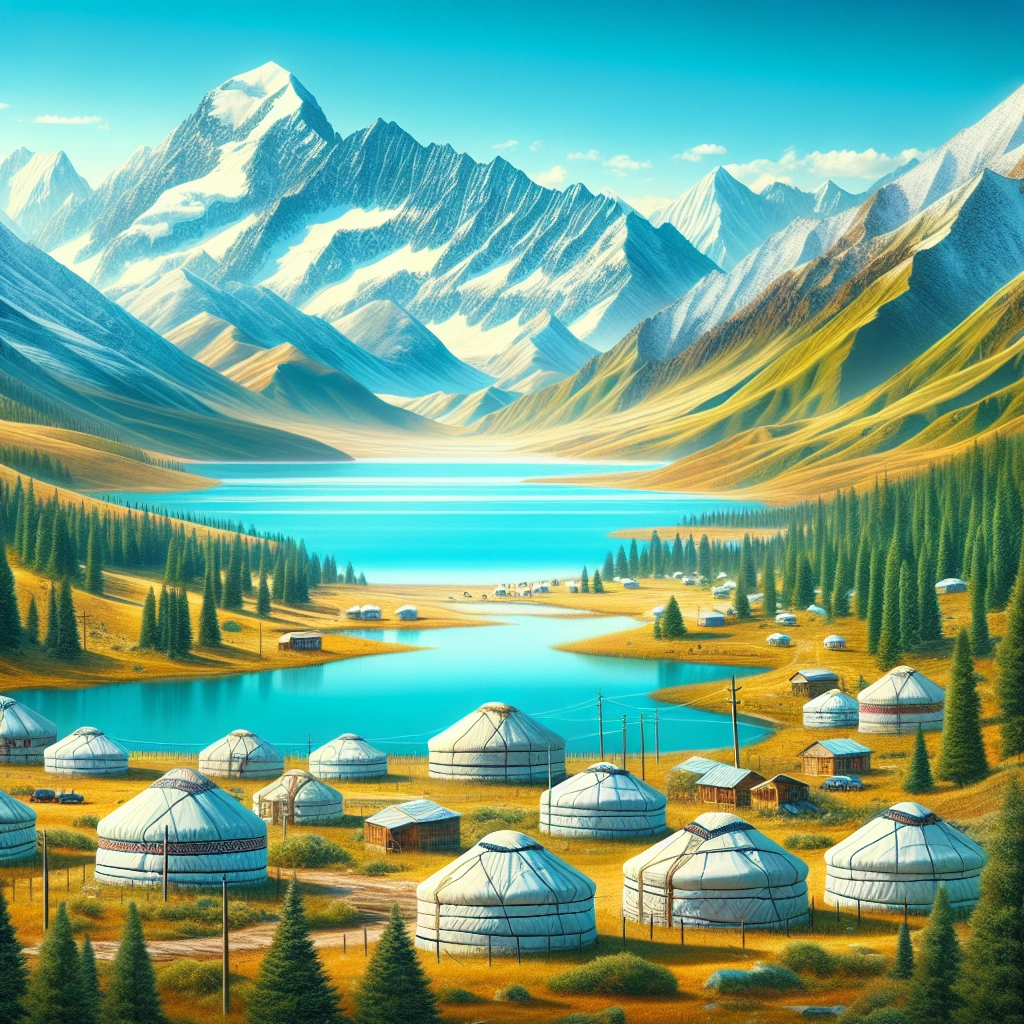
Must-Visit Destinations
Top tourist destinations in north asia.
- Moscow, Russia: Explore the majestic Red Square, witness the iconic St. Basil’s Cathedral, and delve into the rich history of the Kremlin.
- St. Petersburg, Russia: Admire the opulence of the Winter Palace, visit the Hermitage Museum, and take a boat ride along the scenic canals.
- Seoul, South Korea: Immerse yourself in the fusion of modernity and tradition at Gyeongbokgung Palace and indulge in the vibrant street food scene at Myeong-dong.
- Beijing, China: Discover the awe-inspiring Great Wall, marvel at the Forbidden City, and experience the allure of the historic Tiananmen Square.
Hidden gems and off-the-beaten-path locations
- Lake Baikal, Russia: Uncover the raw beauty of the world’s deepest and oldest freshwater lake, offering unparalleled tranquility and natural wonders.
- Hokkaido, Japan: Embrace the charm of this northern island with its picturesque landscapes, hot springs, and delectable seafood delicacies.
- Khuvsgul Lake, Mongolia: Experience the pristine wilderness and serenity of this stunning freshwater lake, perfect for nature enthusiasts and adventurers.
- Hapcheon, South Korea: Delight in the serene countryside adorned with rolling hills, ancient temples, and the captivating Haeinsa Temple.
Landmarks and iconic sights
- BaNa Hill, Vietnam: Ascend to this hill station and relish panoramic vistas, the enchanting Golden Bridge, and the awe-inspiring French Village.
- Taj Mahal, India: Behold the epitome of love and architectural magnificence, representing an eternal symbol of romance and craftsmanship.
- Mount Fuji, Japan: Witness the allure of Japan’s highest peak, an iconic symbol ingrained in the nation’s culture and revered for its breathtaking beauty.
- Petronas Twin Towers, Malaysia: Marvel at the architectural marvel and cultural symbol of Malaysia, offering stunning views from the Skybridge and Observation Deck.
Remember, these are just a few of the amazing destinations waiting to be explored in North Asia. Whether it’s the bustling cities, serene natural landscapes, or awe-inspiring landmarks, North Asia offers a captivating tapestry of experiences for every traveler.

Cuisine and Dining
Traditional north asian dishes.
In North Asia, traditional dishes often include pork and chive dumplings, suan cai hot pot, cumin, and caraway lamb, congee, tea eggs, nian doubao, congee with various pickles, sachima, crispy roast suckling pig, and beggar’s chicken.
Culinary experiences and popular food choices
The culinary experiences in North Asia are rich, with a focus on hearty root vegetables, cabbages, grains, sweets, seafood, exotic fruits, and spicy hot pork and poultry. Popular food choices include sweet and sour pork, zha jiang mian, corn soup, and an array of stir-fried, steamed, and deep-fried dishes.
Dining etiquette and cultural practices
Dining in North Asia involves certain etiquettes. For instance, across China, it’s customary to follow the lead of the eldest diner for seating and when to start eating.
Additionally, guests should avoid resting their chopsticks vertically in the bowl as it is considered to bring bad luck. Using chopsticks correctly and not eating with a fork are also important customs to observe.

Language and Communication
Common languages spoken in north asia.
Russian, Mandarin, Japanese, Korean, and Mongolian are among the common languages spoken in North Asia. With unique scripts and diverse dialects, these languages reflect the rich cultural heritage of the region.
Useful phrases and language tips for travelers
For travelers to North Asia, learning a few key phrases can greatly enhance the experience. For example, “Xie xie” means “thank you” in Mandarin, “Arigatou gozaimasu” is “thank you very much” in Japanese, and “Gamsahamnida” means “thank you” in Korean.
Moreover, understanding basic greetings and polite expressions can go a long way in fostering positive interactions with locals.
Language barriers and how to overcome them
Overcoming language barriers while traveling in North Asia can be achieved through various strategies. Utilizing body language, carrying a translation app, and engaging with locals can aid in effective communication.
Additionally, having a positive mindset and being open to learning the local language can help break down barriers and create meaningful connections.

Cultural Etiquette
Respectful behavior and cultural norms in north asian countries.
In North Asian countries like Japan and South Korea, it’s important to bow as a sign of respect when greeting someone. Additionally, removing shoes before entering a home or certain establishments is a common practice.
Understanding these cultural norms and adhering to them demonstrates your respect for the local traditions.
Tips for interacting with locals
When interacting with locals in North Asian countries, it’s helpful to learn a few basic phrases in the local language as it shows your effort and respect for their culture. Also, it’s important to avoid prolonged eye contact, as it can be considered impolite in some North Asian cultures.
Observing and mirroring the behavior of locals can also be a great way to navigate social interactions more seamlessly.
Avoiding cultural misunderstandings
To avoid cultural misunderstandings in North Asian countries, it’s essential to avoid public displays of affection, as it’s often considered inappropriate. It’s also crucial to be mindful of personal space, as physical contact and invading someone’s personal space can be uncomfortable for locals.
Being aware and respectful of these cultural nuances can help in fostering positive interactions and experiences during your visit to North Asia.

Health and Safety
Healthcare facilities and medical services.
Healthcare facilities and medical services in countries in North Asia vary in quality and availability. Access to modern hospitals, clinics, and specialized medical services may be limited in some regions, so it’s essential to research the specific healthcare infrastructure of your destination.
In South Korea and Japan, advanced medical facilities are prevalent, while in Mongolia and parts of Russia, healthcare facilities may be more basic. Therefore, it’s advisable to inquire about the availability of English-speaking doctors and comprehensive medical services in advance.
Travel insurance recommendations
When traveling to countries in North Asia, obtaining travel insurance is vital to ensure that you are covered for any unexpected medical expenses and travel-related emergencies. Companies such as HTH Worldwide, Nationwide, and Seven Corners offer comprehensive travel insurance plans that include medical coverage, trip cancellations, and emergency medical evacuations. InsureMyTrip.com , CoverTrip, and Squaremouth are reputable platforms to compare and purchase travel insurance plans based on your specific needs and travel itinerary.
Safety precautions and emergency contacts
Maintaining safety while traveling in countries in North Asia involves being mindful of your surroundings and taking necessary precautions. Avoid wearing flashy jewelry, ensure responsible consumption of alcohol, and be cautious with your valuables.
Additionally, familiarize yourself with local emergency contacts and embassy information to swiftly address any unforeseen situations. Having both physical and electronic copies of essential emergency contacts, including local authorities and your embassy, can be incredibly beneficial in times of need.
Remember, prioritizing your health and safety during travel in countries in North Asia is crucial for a worry-free and enjoyable experience.

Currency and Money Matters
Currency exchange and banking services.
Currency exchange and banking services in North Asia vary based on the country you’re visiting. In South Korea, you’ll find numerous currency exchange counters at airports, banks, and popular tourist areas.
It’s advisable to carry some local currency alongside credit cards for convenience. In Japan, major cities have ATMs that accept foreign cards, and currency exchange is available at airports and designated banks.
As for China, currency exchange services are widely available in major cities, and international credit cards are accepted in urban areas.
Budgeting tips and cost of living
When budgeting for North Asia travel, it’s essential to consider specific countries’ cost of living. For instance, Tokyo and Seoul can be relatively expensive compared to other Asian cities.
However, Southeast Asian countries like Vietnam and Thailand offer more budget-friendly options for accommodation, transportation, and dining. Utilizing local public transport, opting for street food, and choosing budget accommodations can significantly reduce expenses, allowing for extended travel periods without exceeding the budget.
Managing finances while traveling in North Asia
Managing finances while traveling in North Asia involves a combination of cash, credit cards, and mobile payment methods. It’s crucial to notify your bank about your travel plans to avoid card disruptions and to have a backup in case of emergencies.
Additionally, carrying a mix of local currency and US dollars as emergency funds can be beneficial. Embracing mobile payment applications like Alipay and WeChat Pay, widely utilized in China, can enhance convenience and security while making transactions in North Asia.
Remember, researching and planning ahead will contribute to a successful and budget-friendly experience in North Asia.

Festivals and Events
Traditional festivals and celebrations.
In countries in North Asia, traditional festivals and celebrations hold a significant place in the local culture. For example, in South Korea, the Chuseok festival is a time for families to come together, honoring ancestors through ancestral rites and sharing traditional Korean food.
In Japan, the cherry blossom festivals, known as “Hanami,” celebrate the ephemeral beauty of the cherry blossoms, marking a time of renewal and optimism for the future.
Annual events and cultural gatherings
Countries in North Asia host various annual events and cultural gatherings that attract both locals and tourists. For instance, the Asahikawa Winter Festival in Hokkaido, Japan, showcases stunning ice sculptures and attracts visitors from around the world.
Additionally, the Harbin International Ice and Snow Sculpture Festival in China captivates attendees with its majestic ice decorations and vibrant cultural performances.
Participating in local festivities
Participating in local festivities in countries in North Asia provides a unique opportunity to immerse oneself in the rich cultural tapestry of the region. Whether it’s experiencing the majestic Dragon Boat Festival in China, the vibrant Lantern Festival in Taiwan, or the traditional New Year celebrations in Mongolia, these events offer an unparalleled cultural experience that leaves a lasting impression on participants.

Shopping and Souvenirs
Unique souvenirs and local handicrafts.
When traveling to countries in North Asia, you’ll be delighted to explore a wide range of unique souvenirs and local handicrafts. From intricately designed ceramics and textiles in South Korea to traditional paper and silk crafts in Japan, each country offers its own special treasures.
Don’t miss the opportunity to bring home beautiful items such as hand-painted fans, delicate porcelain, and meticulously crafted wooden carvings that showcase the rich cultural heritage of North Asia.
Shopping districts and markets
North Asia boasts vibrant shopping districts and markets that cater to every shopper’s needs. Whether it’s the bustling streets of Myeongdong in Seoul, the trendy fashion boutiques in Tokyo’s Harajuku district, or the traditional markets in Beijing, you’ll find an eclectic mix of shopping experiences.
Immerse yourself in the local culture as you explore these dynamic shopping hubs, where you can find everything from high-end designer brands to unique, handcrafted items by local artisans.
Bargaining tips and etiquette
When it comes to bargaining in North Asian countries, it’s essential to approach it with respect and understanding of local customs. While bargaining is common in some markets, it’s important to be mindful of the cultural nuances and etiquettes associated with it.
Take the time to observe and learn the bargaining customs in each country to ensure a mutually respectful and enjoyable shopping experience. Remember, bargaining is not just about getting the best deal but also about engaging in a cultural exchange and appreciating the art of negotiation.

Social Etiquette and Customs
Social norms and customs in north asian countries.
Understanding and respecting the social norms and customs in North Asian countries is crucial for visitors and travelers. In countries like Japan and South Korea, it is customary to bow as a form of greeting and respect, while in China and Mongolia, a handshake is more common.
Additionally, showing respect for elders and maintaining a sense of formality in interactions is highly valued in these cultures, signifying the importance of hierarchy and status in social settings.
Greetings and gestures
Greetings and gestures vary across North Asian countries, reflecting unique cultural traditions. For instance, in Japan, the customary greeting involves a bow, while in South Korea, a deep bow and a slight nod is common.
Furthermore, exchanging business cards with both hands and a slight bow is an essential part of the greeting process in several North Asian countries, emphasizing the significance of formal introductions and respect for others.
Taboos and cultural faux pas to avoid
Understanding and adhering to taboos and cultural faux pas is essential when visiting North Asian countries. For example, in many regions, it is considered disrespectful to point at people or objects with your index finger, and it is important to avoid stepping on the threshold when entering someone’s home.
Additionally, the concept of “saving face” holds immense importance in North Asian cultures, making it crucial to exercise tact and sensitivity in social interactions to avoid causing embarrassment or offense.

Environmental Conservation Efforts
Sustainability initiatives in north asia.
When it comes to sustainability initiatives in North Asia, countries like China and South Korea are making significant strides towards clean and sustainable energy. China has been investing heavily in renewable energy sources such as solar and wind power to reduce its carbon footprint.
South Korea, on the other hand, has been actively promoting eco-friendly transportation and sustainable city planning to minimize environmental impact.
Environmental challenges and conservation projects
North Asia faces several environmental challenges, including dust and sand storms resulting from desertification, air pollution, and marine pollution in adjoining sea areas. Countries in this region are actively engaged in conservation projects to combat these challenges.
For instance, efforts to combat desertification through reforestation and sustainable land management have been a key focus in countries like Mongolia and Kazakhstan. Additionally, collaborative initiatives to reduce air and marine pollution through improved waste management and environmental regulations are underway.
Responsible tourism practices
In the context of responsible tourism practices, several countries in North Asia have been promoting sustainable tourism destinations and experiences. For example, South Korea has been working with local communities to ensure that tourism activities are aligned with sustainable practices.
Similarly, Japan has been implementing strict sustainability standards and regulations to ensure that the tourism industry prioritizes responsible environmental practices.
North Asian countries are actively pursuing sustainability initiatives, engaging in conservation projects, and promoting responsible tourism practices to address environmental challenges and contribute to conservation efforts.

Recommended Amazon Products for Traveling to North Asia
Here’s a curated list of products that can help you make the most out of your trip to North Asia. These recommendations are based on functionality, price, and reviews.
Travel Backpack

A reliable and durable travel backpack is crucial for exploring the diverse landscapes and natural wonders of North Asia. Look for a backpack that offers ample storage, comfortable straps, and convenient compartments for organization.
Universal Travel Adapter

A universal travel adapter is essential for staying connected and powered up throughout your journey across North Asian countries. Choose an adapter that is compatible with multiple outlet types and has built-in safety features for peace of mind.
Portable Language Translator Device

Navigating through the various languages spoken in North Asia can be easier with a portable language translator device. Look for a device with a wide range of language options, clear audio output, and offline capabilities.
Collapsible Water Bottle

Staying hydrated is important, especially when exploring the natural wonders and outdoor activities in North Asia. A collapsible water bottle is convenient for carrying and refilling, reducing the need for single-use plastic bottles.
Packing Cubes

Keeping your belongings organized and compact is essential for hassle-free travel. Packing cubes can help you maximize luggage space and keep your items neatly separated throughout your trip.

Pros and Cons Comparison of Recommended Products
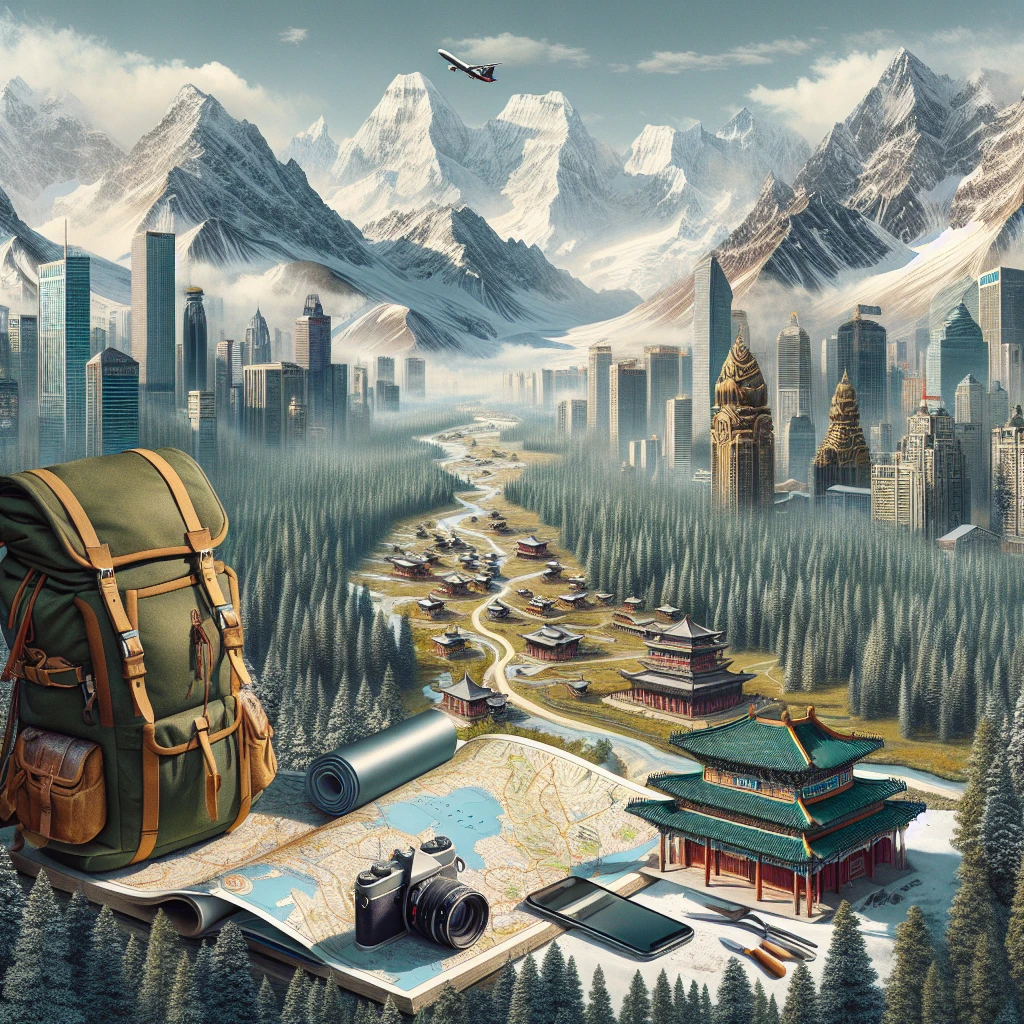
Top Recommended Product for Traveling to North Asia
If you’re looking for the best solution for traveling to North Asia, we highly recommend the Travel Backpack ( https://www.amazon.com/s?k=travel+backpack ). With ample storage, comfortable straps, and convenient compartments for organization, this backpack will be your perfect travel companion. Ready to explore the diverse landscapes and natural wonders of North Asia? Check out the Travel Backpack ( https://www.amazon.com/s?k=travel+backpack ) today for the best results!

The countries in North Asia include Russia, Mongolia, and Kazakhstan. These countries have diverse cultures, rich history, and significant contributions to the region’s economy and development.
They also offer unique travel experiences, from the vast wilderness of Russia to the nomadic traditions of Mongolia.
Moreover, the countries in North Asia are characterized by varying climates and landscapes, ranging from the frigid tundra of Russia to the arid steppes of Kazakhstan. Each country offers distinct natural beauty and outdoor activities, such as hiking in the Altai Mountains or exploring the Siberian taiga.
Additionally, the region is home to unique wildlife and flora, making it a must-visit for nature enthusiasts.
The countries in North Asia present a wealth of opportunities for cultural exchange, economic cooperation, and tourism. They continue to play a crucial role in shaping the political and economic landscape of the Asian continent, and their contributions are invaluable in the global context.
Whether it’s for business, leisure, or academic purposes, North Asia has much to offer to the world.
Frequently Asked Questions
What are some questions to ask about asia, what country controls most of north asia, what is a fact about north asia, what is asia's largest country, what countries are in the north of asia, what is one fact about north asia, are there 48 countries in asia.
Jonathan B. Delfs
I love to write about men's lifestyle and fashion. Unique tips and inspiration for daily outfits and other occasions are what we like to give you at MensVenture.com. Do you have any notes or feedback, please write to me directly: [email protected]
Recent Posts
The Shocking Truth About Betsy Woodruff Swan
Uncover the startling revelations surrounding what happened to Betsy Woodruff Swan, delving into unexpected truths and significant developments.
The Redemption Journey Of Benji Kelley
Explore the transformative story of Benji Kelley and understand the events leading to his redemption journey.
You will be redirected to your dashboard shortly. We will also call you back in 24 hrs .
- Safari In Russia: Top 3 Places Where You Have Chances To Spot A Siberian Tiger
If you are interested in safari tours, wildlife site seeing and some adventurous thing, then this safari tour guide will be of great help to you. Russia is the world’s number one country in terms of occupied area. But this occupied area has so many things to do, to explore and to experience. Let us, first of all, know about the different species of animals which a person would get to see experiencing the Safari in Russia.
Roaming around in the Far East side of Russia would be a great adventure, and it would be an opportunity to explore the world of the dangerous and rare species of animals like the Siberian Tiger and many other species of birds and wild animals. Another endangered wildlife species is the Amur Tigers. There are less than 500 Amur Tigers left in the whole world, and from these 500, a huge number of them are placed in the safari in Russia. These two types of tigers are considered to be the main attraction for people towards the Safari Park in Russia.
Europe Holiday Packages On TravelTriangle
Explore the most beautiful places to visit in Europe, from Paris to the Venice canals and from the Greek islands to the Swiss alps. Book customized packages by expert agents on TravelTriangle. Inclusive of airport transfers, cab, resort, sightseeing and meals. Best holiday experience Guaranteed. Book Now

Magnificent Switzerland Holiday 6D/5N Package @ Rs 69,999
Plan your trip today!

Magnificent Europe Tour 7D/6N Package @ Rs 70,975
Get quotes from multiple travel experts.

France & Switzerland Tour Package 8D/7N @ Rs 90,000
Compare & customize quotes before booking.

Scintillating Spain & Portugal Tour 11D/10N @ Rs 101,150
Have Questions? Talk to our travel experts today.
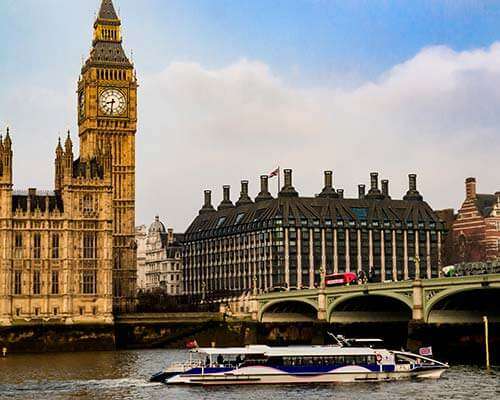
6 Country Europe Tour Package 12D/11N @ Rs 118,650
Best prices guaranteed. EMI option available.

See more at TRAVELTRIANGLE.COM
Places To Visit For Safari In Russia
The World Wildlife Safari in Russia is world famous. People come from all over the world to visit the safari in Russia as it is an excellent attraction of Russia. There are many species of animals which a person could get to see only in the Safari Park in Russia.
1.The Safari Park of Russia
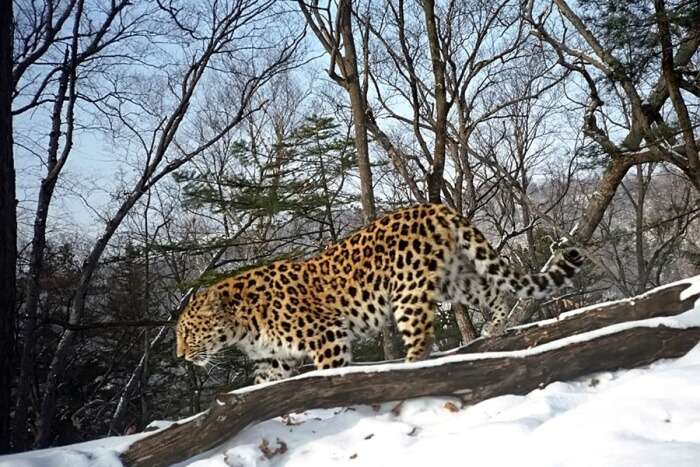
Image Source
When we talk about the safari parks, then the first destination which comes in a person’s mind is the Safari park in Russia. The park is divided into three different areas. These different areas are:-
- Siberian Tigers and hoofed animals
- Birds and wild animals of Primorye
- Amur leopard Park.
The park offers shelter to the different species of animals and treatment is provided to these animals in case of injury or any accidental situations. After taking care of them, they will be left in the forests to live their rest of life. Living conditions are similar to the conditions in the forests.
There are various animals which are visible in this safari like Siberian Tigers, Amur Tigers, wild boars and many species of deer like Sika deer, Roe deer, and Red deer. There are some rare existing animals also like Amur or Far-Eastern Leopard which are on the verge of extinction, and there are only 50 of these species alive on this planet.
Despite the immense size of Russia, the majority of the country experiences two seasons – summer and winter – that implies that timing your visit is straightforward. Walkers watch polar bears walking icecaps, can cross stretches of tundra sunlight themselves and also ascend sand slopes – all at precisely exactly the nation. A brief interchange is between summer and winter, and that is due to substantial and extremely low temperatures. Summer gives the chance of planting wildlife at the Far East of Russia, while birdlife fills the heavens and also the salmon run turns the oceans reddish together with sparks emerging from hibernation to split the property together with reindeer, wolves, and moose.
There is a specified time to visit any place. Similarly, there is a particular time, and one should know when to go to Russia on safari. According to people, winter is the best time to visit safari in Russia. In the winter season, there is snowfall, and the whole place gets covered with snow. Due to this reason, people could find the footprints of the Siberian Tiger very easily while if a person visits in the summer season, then it would be very difficult to get a glimpse of the rare Siberian Tiger.
Must Read: 15 Interesting Things To Do In Moscow: Trekking, Opera, And More In 2022
2. Durminskoye Reserve of Siberia

Best time: November – March
The tiger tracking shore at the Durminskoye Reserve of Siberia occurs at the depths of winter close Khabarovsk, a city in the south-west corner of Russia. Accompanying tracker Alexander Batalov, you’re going to be involved in conservation work leading to the Tigers’ breeding season. Employed at the snow and freezing temperatures – for maintaining the ones paw prints needed – that safari is for its intrepid adventurer. Researching the creatures’ sprawling habitat from the foot, ski-doo and 4×4, your odds of visiting the biggest of all big cats at the flesh could be lean, however by putting up remote camera cubes and assisting Alexander in tracking the spot, you’re going to be causing the security and continuing success of these creatures that are endangered creatures, that can number as much as 400 from the great outdoors.
Suggested Read: 10 Best Hotels In Moscow That Redefine Luxury Like None Other!
3. Kamchatka

Best time: May – September
Despite lying latitudes to the UK, the Kamchatka Peninsula occupies long winters on account of this effect of Arctic winds and also sea currents, leaving the property. The weeks between May and September offer the temperatures. However, the sheer size of Kamchatka means its climate is changeable based on the area of the visit. Generally, people can think about highs which range from 15 to 20 °C together with lows hitting below freezing, through summer time.
Kamchatka might possibly be larger than the UK; however, its own inhabitants figures only 330,000 people, nearly all of whom reside in its tip at the main city of Petropavlovsk. As a result of huge tracts of un-developed tundra which lie between its populations’ centers, helicopters are the easiest solution. When shooting into the heavens even, it might be well worth packing lots of layers. When temperatures could drop to as little as -25 °C, Kamchatka bears hibernate throughout the months. Despite going at November in their dens and emerging March, the ideal time to find these beasts is to coincide with the yearly salmon conduct that does occur in rivers throughout and streams around the world. This time offers an ideal chance to set off on a fishing adventure to the bears. Kurile Lake in special can be a prime locale for seeing those two wonders encounter.
Further Read: With The Red Square Turning White, Snowfall In Moscow Hits A 100-Year High!
The season of Peak birdwatching is from May to early June, and the Commander Islands is one of the best locations for sighting the seabirds. There are also Steller’s sea lions and Kamchatka brown bears also visible during this time. This collection of 17 islands and rocks is found 100 miles away from the eastern shore, which implies cooler summers than people enjoyed on Kamchatka, but additionally creates the Hawaiian Islands home of colonies of Kamchatka. Puffins, auklets, albatross, and cormorants are found in great amounts, while sightings of this Steller’s sea eagle – boasting a wingspan up – is guaranteed to become a highlight of every trip to Moscow
Looking To Book An International Holiday?
Book memorable holidays on TravelTriangle with 650+ verified travel agents for 65+ domestic and international destinations.

Trip to Sri Lanka at Rs 13,500/-
Plan Your Vacation Today!

Trip to Singapore at Rs 20,499/-
Get Quotes From Local Experts

Mauritius Holiday Starting at Rs 65,000/-
Talk to Our Experts Today

Maldives Honeymoon Trip at Rs 39,800/-
Pay with easy EMI Option

Europe Trip at Rs 89,999/-
All Inclusive Deals

Vacation in Dubai at Rs 27,499/-

Hong Kong Holiday at Rs 24,999/-
Money Safe Guarantee

Thailand Holiday at Rs 7,999/-
Flights Excluded

Anjana (Guest Author)
Anjana is a writer, journalist, and a full-time wallflower. She holds a Master’s degree in Media and Mass Communication and firmly believes that travel blogging is nothing less than art. Combining her love for writing with her passion for globetrotting, she brings to you some amazing tips on traveling perfectly, be it any season of the year! In her spare time, she loves reading, listening to obscure indie bands, and writing poetry – all of this while being a crazy dog lady.
Places to visit in India
- 30 Best Places To Visit In Bangalore In...
- 64 Best Places To Visit In Kerala For...
- 39 Best Places To Visit In October In...
- 101 Places To Visit In India Before You...
- 20 Places To Visit In Sakleshpur In 2024...
- 35 Exotic Places To Visit In December In...
- 32 Best Places To Visit In January In...
- 20 Best Places To Visit In Meghalaya For...
- 12 Places To Visit In Punjab To Witness...
- Unravel Places To Visit In Uttarakhand For A...
- 26 Best Places To Visit In Jammu For...
- 29 Places To Visit In Monsoon In India...
- Best Places To Visit In August In India...
- 36 Beautiful Places To Visit In Kashmir One...
- 55 Fascinating Places To Visit In Hyderabad In...
- 35 Ultimate Places To Visit In July In...
- 72 Places To Visit In Rajasthan In 2024
- 42 Best Places To Visit In Pondicherry In...
- 33 Spectacular Places To Visit In Mumbai On...
- 43 Places To Visit In West Bengal In...
- 41 Best Places To Visit In June In...
- 35 Best Places To Visit In Mysore In...
- 35 Places To Visit In Coorg For A...
- 54 Best Places To Visit In India In...
- 8 Places To Visit In Jibhi For A...
- 64 Best Tourist Places To Visit In Goa...
- 25 Best Places To Visit In Visakhapatnam In...
- 16 Places To Visit In Lucknow That Showcase...
- 60 Best Places To Visit In Kolkata That...
International Places To Visit
- 35 Best Places To Visit In Japan That...
- 40 Best Places To Visit In Canada In...
- 28 Places To Visit In October In World...
- 28 Stunning Places To Visit In South Korea...
- 25 Places To Visit In Manila In 2024...
- 19 Best Places To Visit In Morocco In...
- 34 Best Places To Visit In Austria In...
- 82 Best Places To Visit In Turkey That...
- 10 Breathtaking Places To Visit In The World...
- 22 Best Places To Visit In Netherlands: The...
- 24 Fabulous Places To Visit In Ireland: The...
- 19 Best Places To Visit In London In...
- Discover 24 Places To Visit In Switzerland In...
- 17 Mystical Places To Visit In Egypt In...
- 15 Places To Visit In United Kingdom That’ll...
- 33 Best Places To Visit In Amsterdam On...
- 19 Best Places To Visit In Kuala Lumpur...
- 42 Best Places To Visit In Bangkok In...
- 11 Popular Places To Visit In Doha For...
- 26 Places To Visit In Germany In 2024...
- 32 Places To Visit In Belgium That Make...
- 15 Places To Visit In USA That Reflect...
- 37 Best Places To Visit In Dubai At...
- 15 Top Places To Visit In Asia To...
- 20 Must-See Places To Visit In Milan In...
- Top 27 Places To Visit In Greece In...
- 31 Places To Visit In Abu Dhabi In...
- 25 Places To Visit In August In The...
- 15 Best Places To Visit In Chicago That...
- 14 Places To Visit In Berlin You Must...
Things To Do
- 40 Things To Do In Pondicherry In 2024...
- 12 Best Things To Do In Matheran In...
- 23 Intoxicating Things To Do In Turkey In...
- Top 14 Interesting Things To Do In Kanyakumari...
- 38 Things To Do In Gokarna To Escape...
- 12 Best Things To Do In Varanasi For...
- 21 Remarkable Things To Do In Krabi In...
- 16 Things To Do On Honeymoon In 2024
- 23 Things To Do In Chennai To Explore...
- 20 Things To Do In Ahmedabad For An...
- 30 Best Things To Do In Wayanad For...
- 37 Amazing Things To Do In Kerala For...
- Top 39 Things To Do In Jaipur
- 19 Things To Do In Mussoorie For A...
- 33 Best Things To Do In Kolkata In...
- Top 25 Things To Do In Kodaikanal For...
- 32 Things To Do In Ooty That Will...
- 15 Things To Do In Srinagar That Will...
- 20 Things To Do In Darjeeling
- 27 Kickass Things To Do In Malaysia
- 25 Best Things To Do In Phuket That...
- 18 Awesome Things To Do In Kasol On...
- 27 Exciting Things To Do In Chikmagalur
- 9 Things To Do In Mathura For An...
- 23 Things To Do In Lonavala For A...
- 10 Best Things To Do In Lakshadweep For...
- 30 Joyful Things To Do In Bhutan
- 38 Exhilarating Things To Do In Udaipur In...
- 18 Best Things To Do In Chandigarh
- 29 Amazing Things To Do In Shimla
- 30 Things To Do In Dehradun In 2024
- 7 Incredible Things To Do In Vrindavan For...
Recent Posts
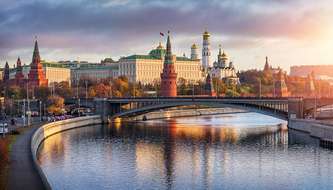
8 Small Towns In Russia One Must Never Forget To Explore In 2024
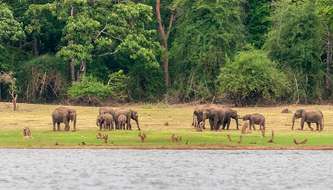
Kabini Wildlife Safari: A Comprehensive Guide For Your Next Adventure
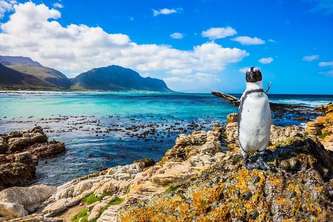
Oudtshoorn Wildlife: 10 Must Visit Places Where You Can See The Diverse Wild Species Of South Africa!
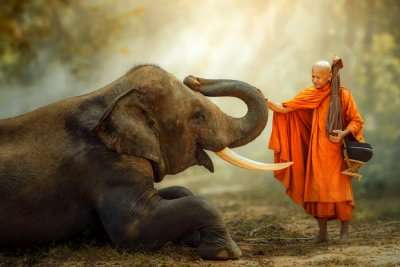
10 Awe-Inspiring Species Of Hanoi Wildlife You’d Be Delighted To Spot!
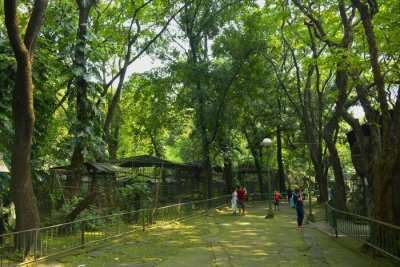
Phnom Tamao Wildlife Rescue Center: Here Is Everything About The Cambodian Wildlife Haven
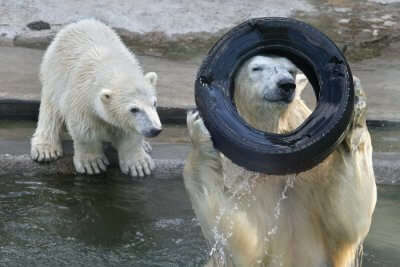
Wildlife In Greenland: 9 Species You Will Be Able To Spot In Greenland
Trending Blogs

20 Mysterious Places In India To Visit In 2024 More Bizarre Than The Bermuda Triangle

10 Scariest Roads In India That Are A Driver’s Nightmare
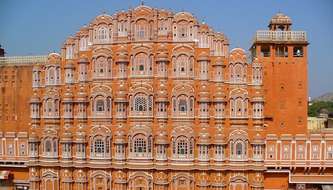
101 Places To Visit In India Before You Turn 30 in 2024

35 Exotic Places To Visit In December In India 2024 To Enjoy A Surreal Vacation

64 Top Honeymoon Destinations In India In 2024

95 Best Honeymoon Destinations In The World In 2023 For A Romantic Escape!
Best Places To Visit In India By Month
Best places to visit outside india by month.
- TravelTriangle
- International
- Destinations » Russia »
- Tour Packages
- Honeymoon Packages
- Family Packages
- Budget Tour Packages
- Luxury Tour Packages
- Adventure Tour Packages
- Group Tour Packages
- Maldives Tour Packages
- Bali Tour Packages
- Dubai Tour Packages
- Singapore Tour Packages
- Thailand Tour Packages
- Europe Tour Packages
- Sri Lanka Tour Packages
- Tour Packages From Delhi
- Tour Packages From Mumbai
- Tour Packages From Bangalore
- Tour Packages From Chennai
- Tour Packages From Kolkata
- Tour Packages From Hyderabad
- Tour Packages From Ahmedabad
- Thailand Tourism
- Bali Tourism
- Singapore Tourism
- Maldives Tourism
- Mauritius Tourism
- Dubai Tourism
- Europe Tourism
- Hotels in Thailand
- Hotels in Maldives
- Hotels in Mauritius
- Hotels in Bali
- Hotels in Dubai
- Hotels in Singapore
- Hotels in Sri Lanka
Wildlife Tourism Conferences in Moscow 2024/2025/2026
- Aug 29 International Conference on Biological, Ecological and Environmental Sciences, and Engineering (ICBEESE) - Moscow, Russia
- Aug 29 International Conference on Wildlife Ecology, Rehabilitation and Conservation (ICWERC) - Moscow, Russia
- Aug 29 International Conference on Ecosystems and Biodiversity (ICEB) - Moscow, Russia
- Aug 30 International Conference on Ecosystems and Biodiversity (ICEB) - Moscow, Russia
- Aug 30 International Conference on Biological, Ecological and Environmental Sciences, and Engineering (ICBEESE) - Moscow, Russia
- Aug 30 International Conference on Wildlife Ecology, Rehabilitation and Conservation (ICWERC) - Moscow, Russia
- 20 Lovely Tourist Places to Visit and Things to Do in Tours, France
- 21 Popular Tourist Attractions to See and Things to Do in Basel, Switzerland
- The Best 40 Tourist Attractions to See and Things to Do in Corfu, Greece
- 14 Interesting Things to See and Fun Activities to Do in Bloemfontein
- 12 Cool Tourist Attractions to See and Things to Do in Guadalajara, Mexico

27 Tourist Places to Visit and Things to Do in Moscow in 4 Days Trip
Moscow is the national capital city of Russia. The city gets its name from the river Moskva. It is among the largest cities in the world and the largest city in Europe. It is one of the most historically significant cities in the world. The best places to visit in Moscow are some of the most iconic monuments across the globe. The events which took place in this city have had a great impact on global politics, economics and culture. The city has been the center for Russia’s politics for ages. Many of the Moscow tourist attractions outline the governance of the country from this city even before Soviet Union era. The grand duchy of Moscow and Tsardom of Russia had their seat of power in the city.
The city has also been a thriving center for art, culture, architecture and science. Many of Moscow attractions are UNESCO world heritage sites. The country has some of the most iconic buildings which are known around the world. The city is considered the place of origin for Russian architecture and is also home to some of the most exemplary works in that style. The city has been home to several great thinkers, philosophers, musicians, artists, playwrights, dancers, scientists, film-makers, writers and so on. Many people visit Moscow to explore the lives of these revered personalities. The houses and places frequented by them have become Moscow tourist places.
Today, the city has a unique culture of its own, which is unlike any other European city. Firstly, it is the best place to explore for Russian cuisine. There are great many fun things to do in Moscow besides sightseeing as well. The city is known for its partying vibe with its vibrant nightlife. You can also explore the deep culture through theater, public events, art galleries and so on.
Table of Contents
Explore The Best Tourist Places in Moscow in 4 Days (Trip Itinerary)
This section explore some of the most popular things to see in Moscow categorized based on probity to one another so you don’t face a hectic commute during your trip.
1. Red Square
This square is definitely one of the most famous Moscow attractions. It is a place of great historical and cultural significance to the city as well as the country. This is the best places to begin Moscow sightseeing as you are surrounded by various monuments. You will need about an hour for the Red Square.
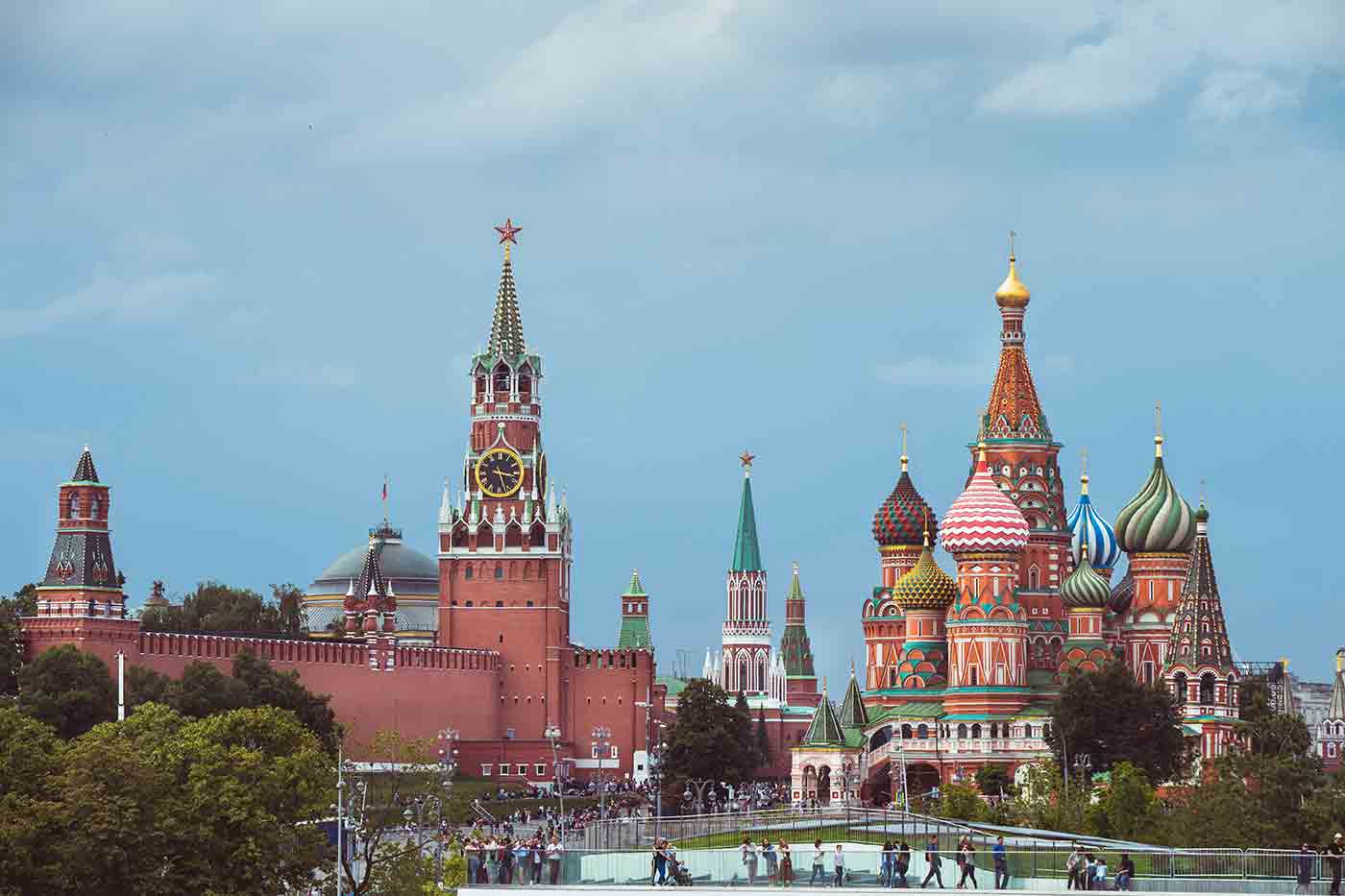
2. Lenin’s Mausoleum
This is the final resting place of the iconic leader of Soviet Union, Vladimir Lenin. It is a place of great historical significance to visit during Moscow travel. You will need 20 to 25 minutes for Lenin’s Mausoleum.
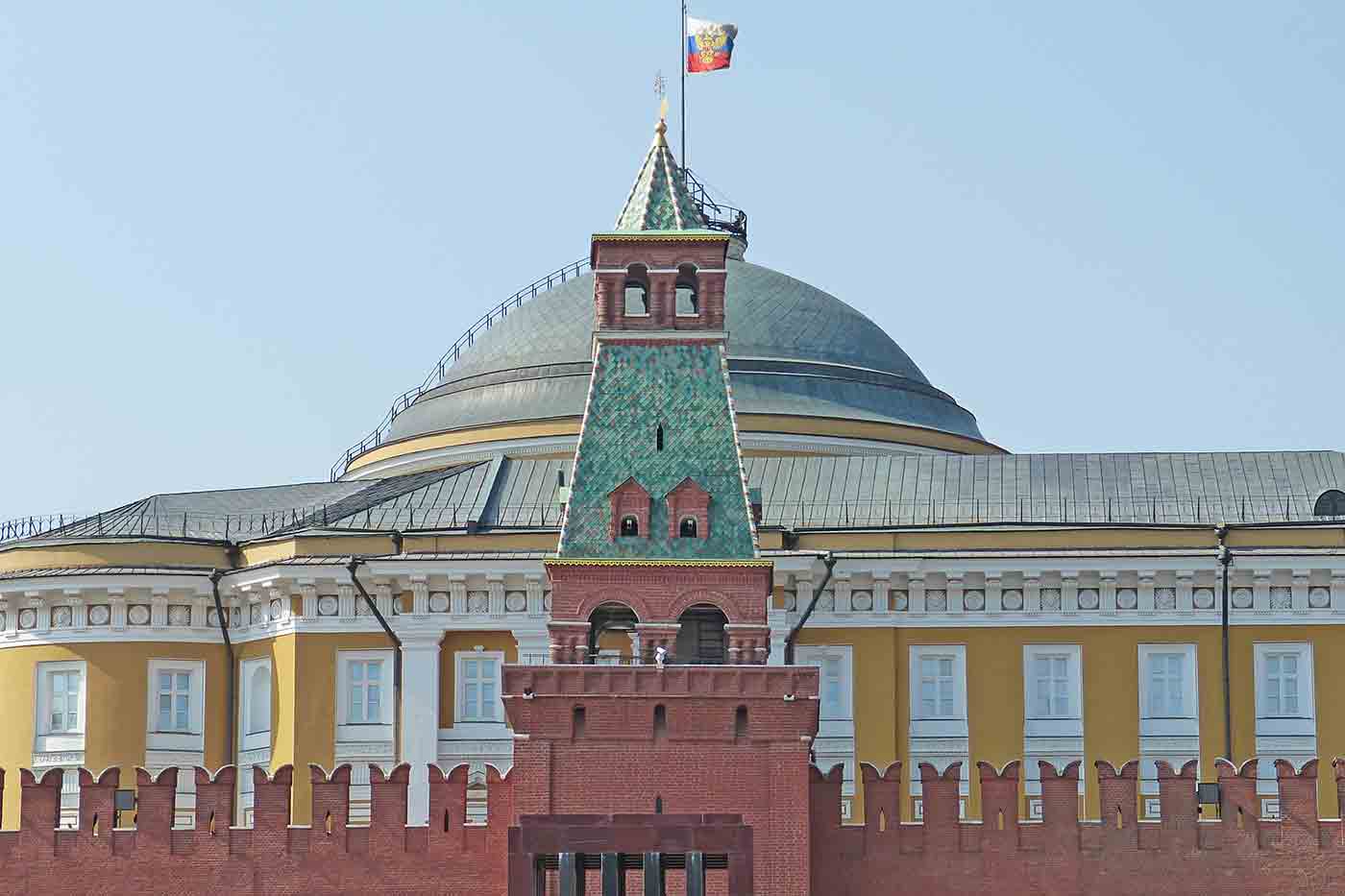
3. GUM Department Store
This is the largest shopping mall in the city and also its most popular. If you are looking for fun things to do in Moscow, Russia then this is the place to go. You can easily spend an hour or so at GUM Department Store.
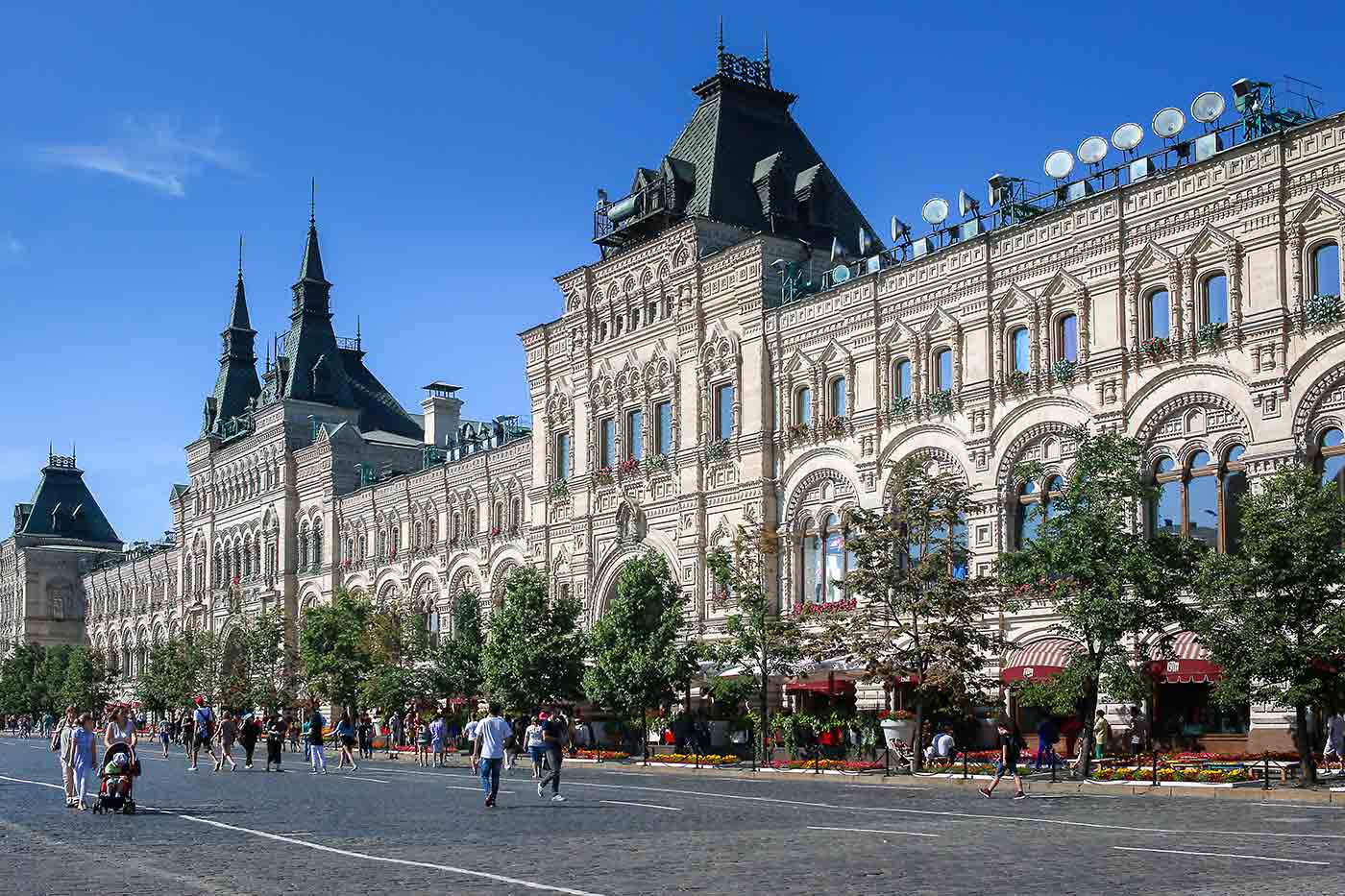
4. State Historical Museum
This museum tells the story of Russia, it is one of the first places you should explore when you visit Moscow. The museum has more than a million artifacts and you would need about 2 hours to explore it.
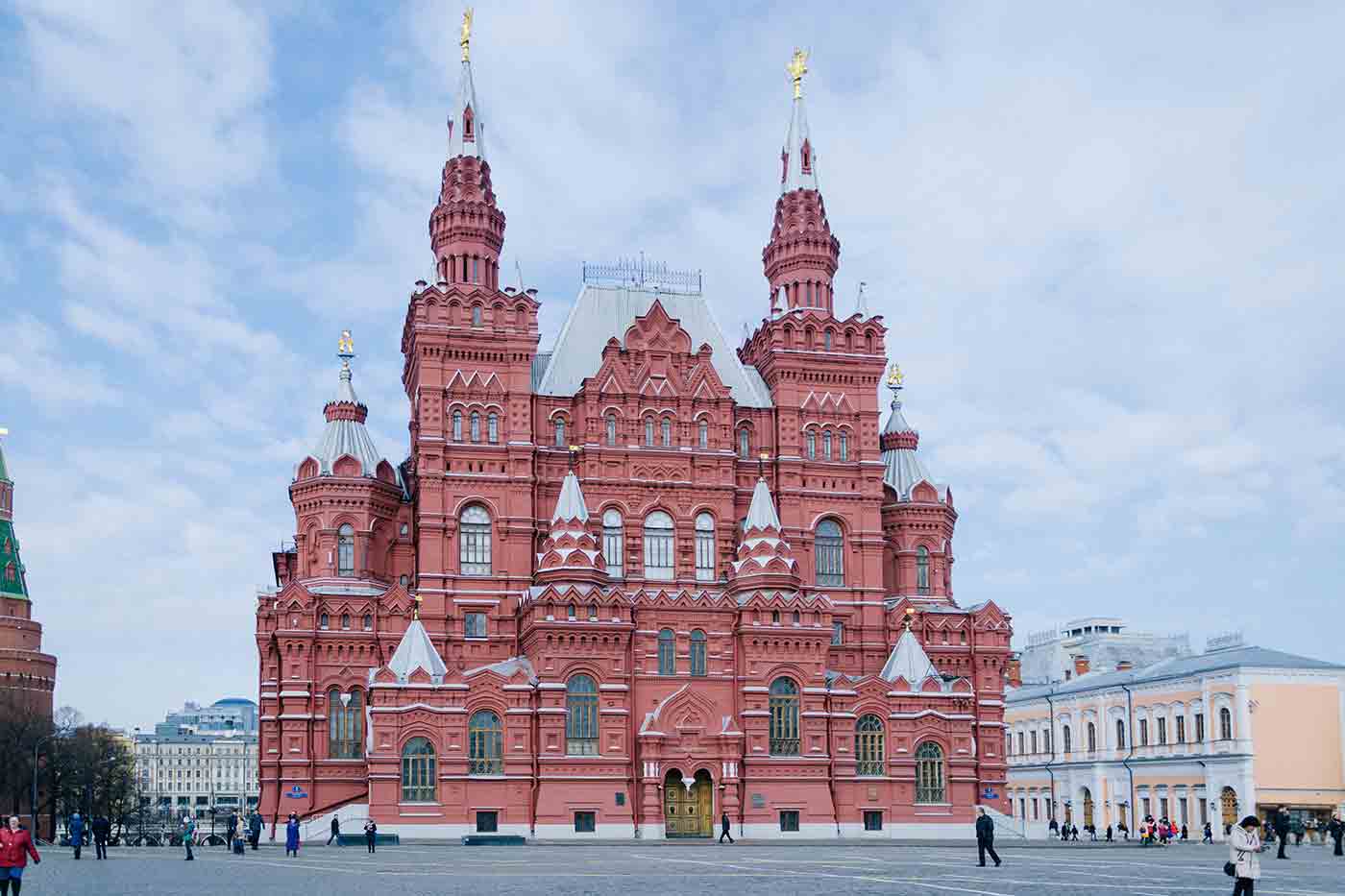
5. Saint Basil’s Cathedral
This cathedral is one of the most beautiful things to see in Moscow. It is an iconic monument which is known around the world. It was built in 1555 and was built under the reign of the very first Czar of India. You will need about an hour to explore this cathedral.
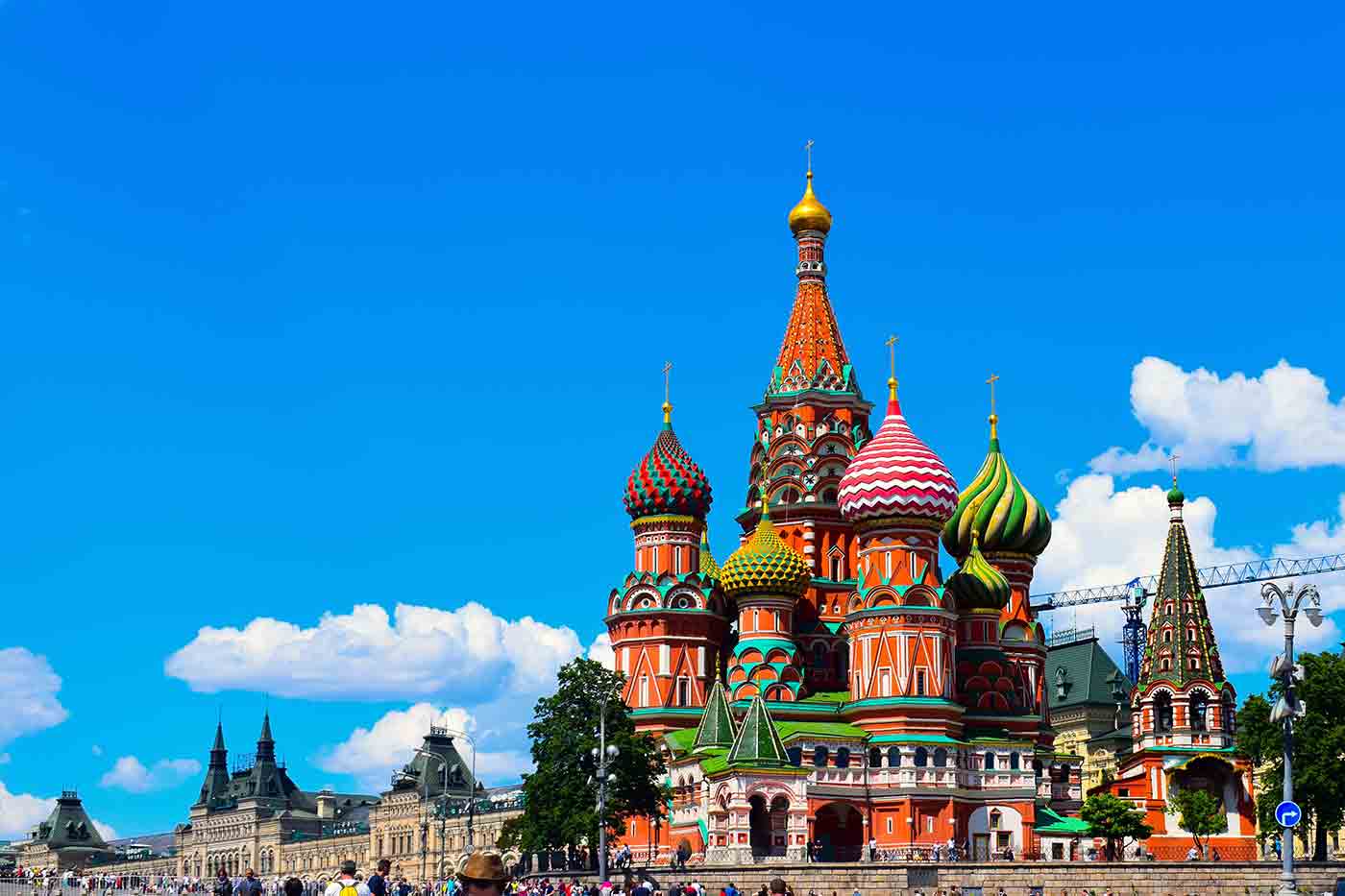
6. The Moscow Kremlin
This is the official residence of the President of Russia. The complex also includes an eponymous museum exhibiting artifacts which goes back 3rd century B.C. You will need an hour to explore Moscow Kremlin museum.
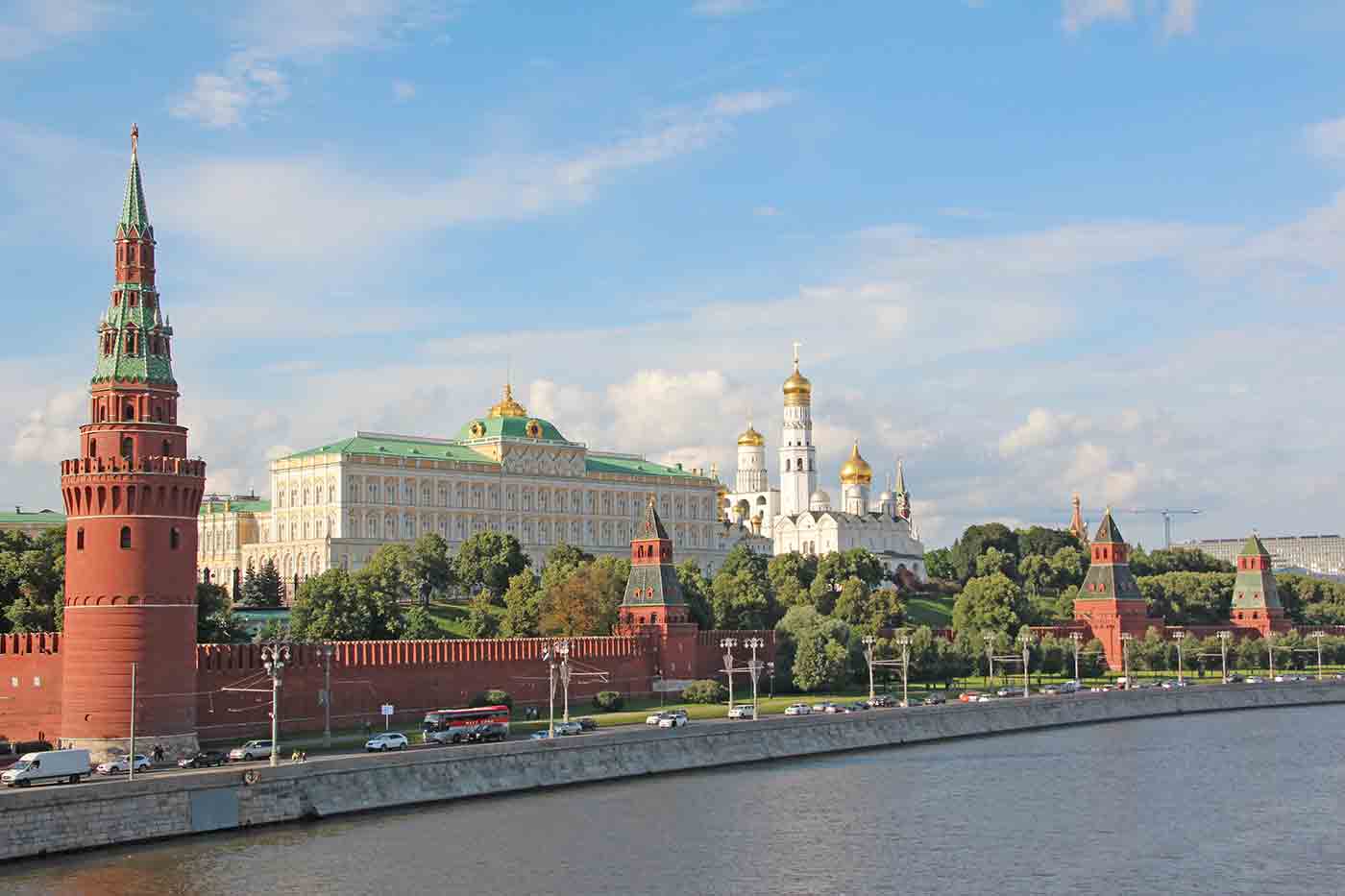
7. Kremlin Armoury
It is one of the most popular places on Moscow itinerary for its collection of exhibits of applied arts from 5th and 20th century. The collection features items from Russian, Western Europe and Eastern. It will take you an hour for this museum.
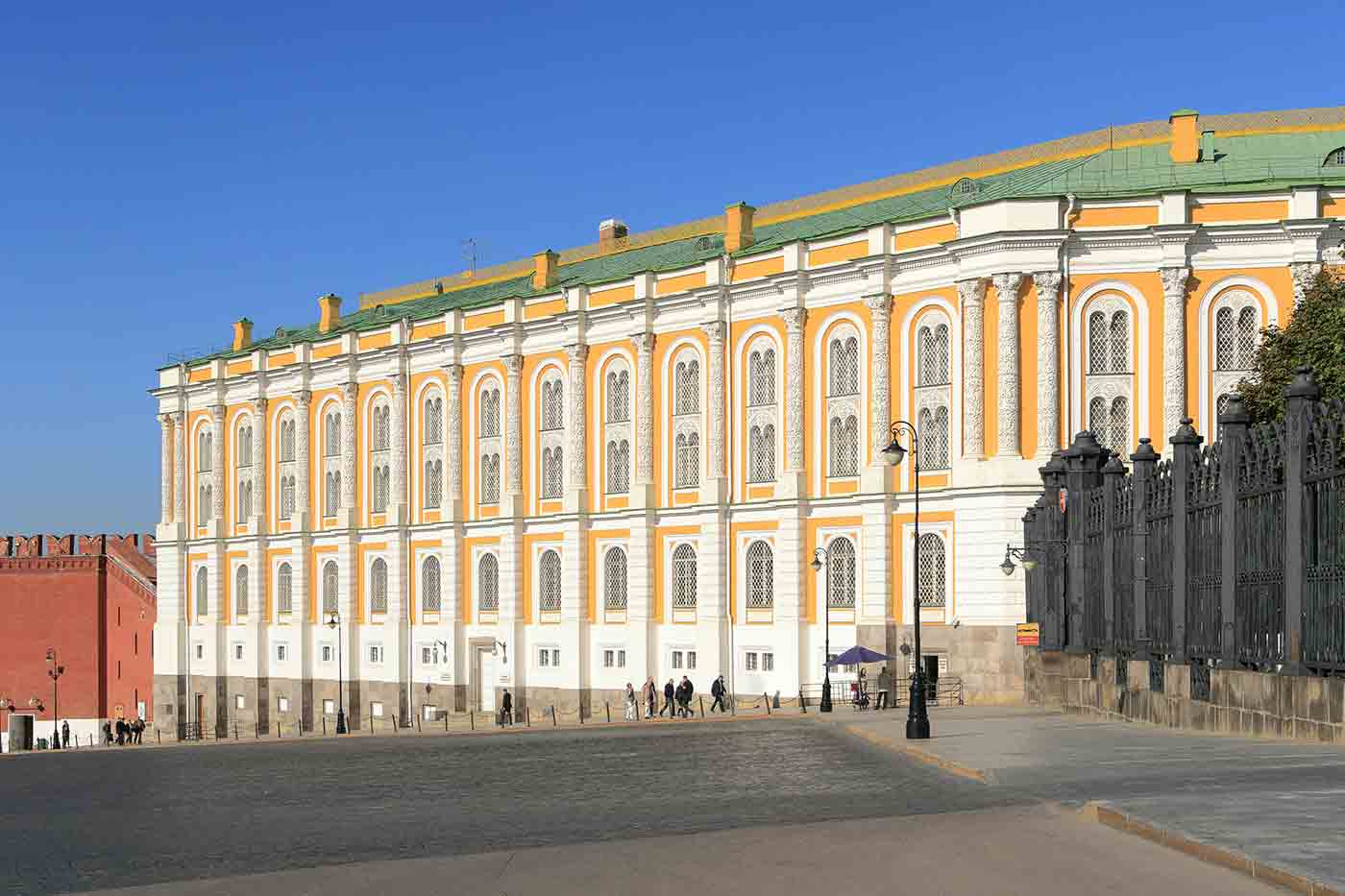
8. Diamond Fund (Almaznyy Fond)
This museum exhibits cut gems, jewelry items and natural gem stones. The museum was established in 1719 by Emperor Peter the Great. You will need about 30 to 45 minutes for this museum.
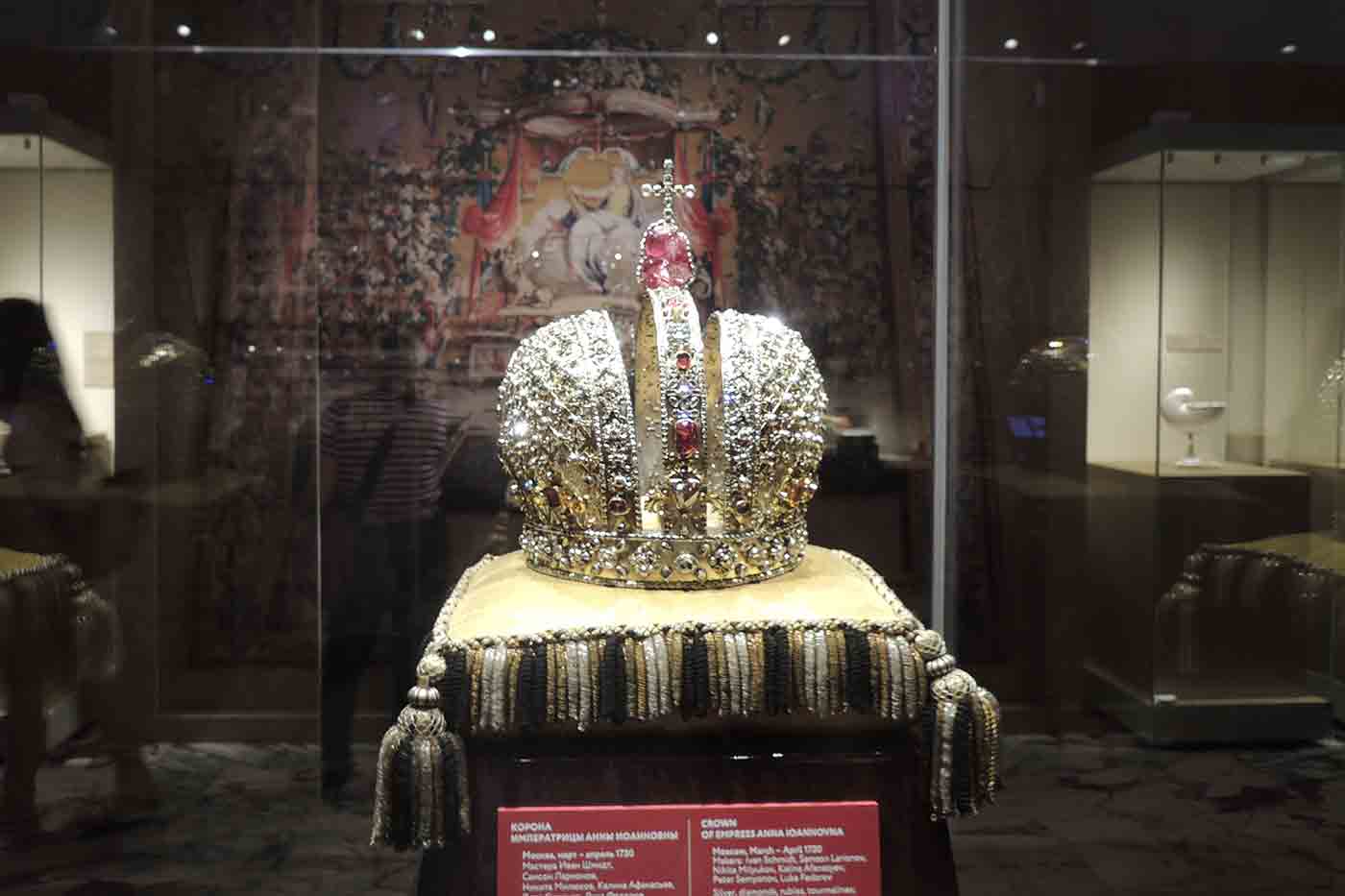
9. Alexander Garden
This park was built in 1812 and was one of the first public parks in the city. It was designed by architect Osip Bove. It is among the most beautiful Moscow tourist places. You will need about 30 to 45 minutes to explore it.
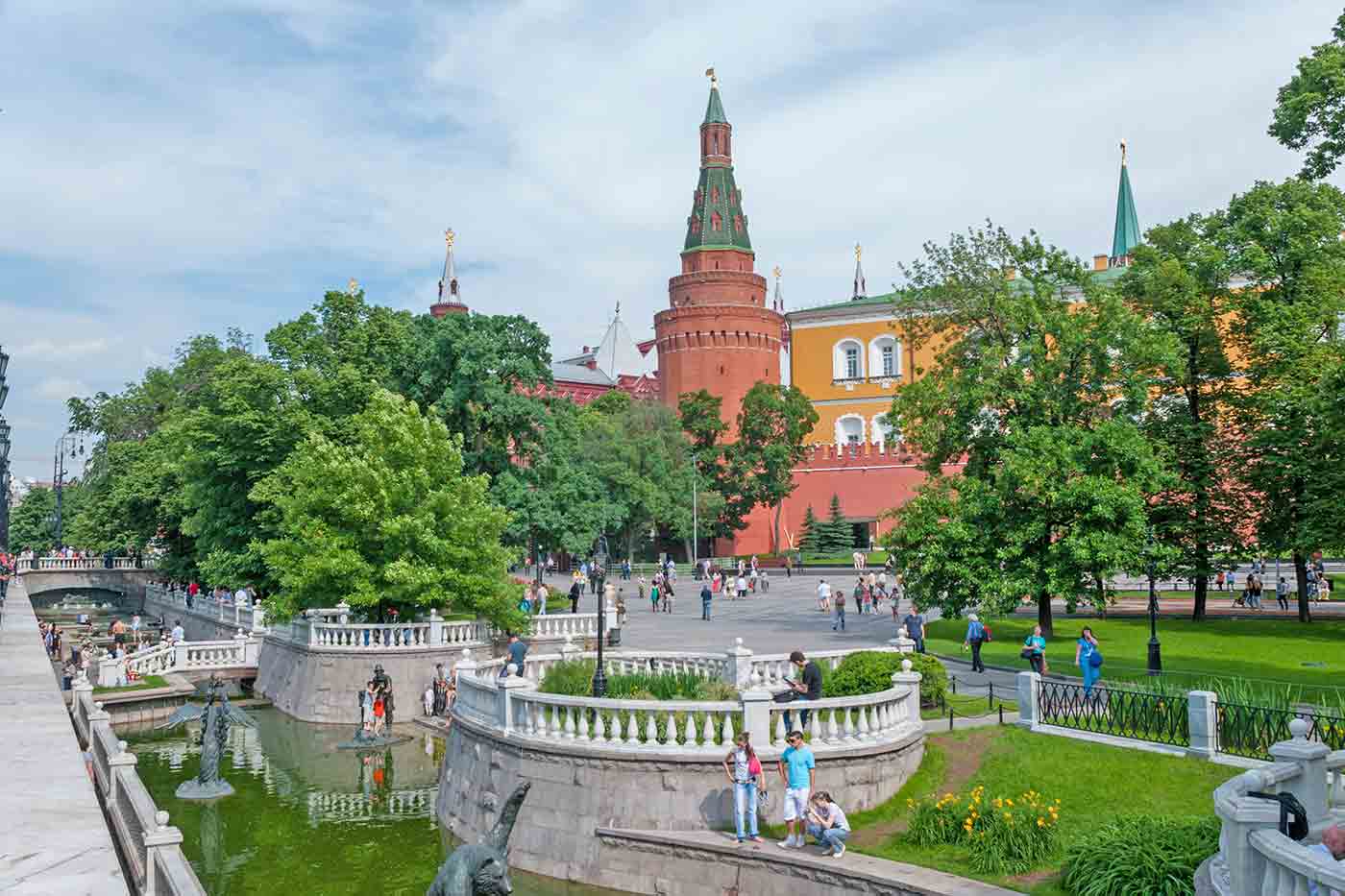
1. Poklonnaya Hill
This is one of the highest point in the city and one of the best places to see in Moscow. The hill is dedicated to Soviet Union’s victory over Nazi Germany. You will need about 2 hours to explore it.
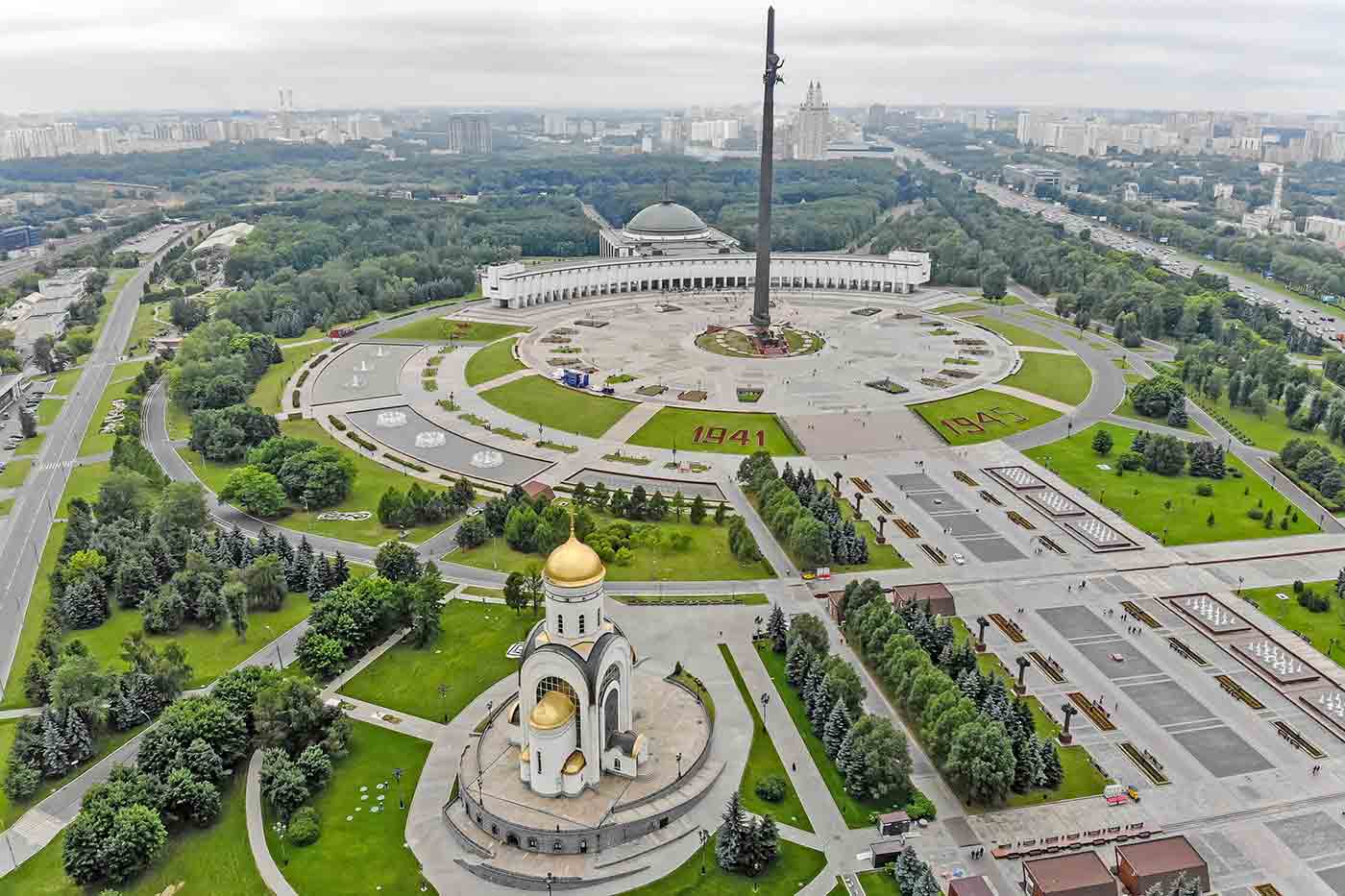
2. Museum of Great Patriotic War
This museum is dedicated to Soviet Union’s contribution to the Second World War. It is one of the most interesting museums to explore during city sightseeing in Moscow. You will need about an hour to explore this museum.
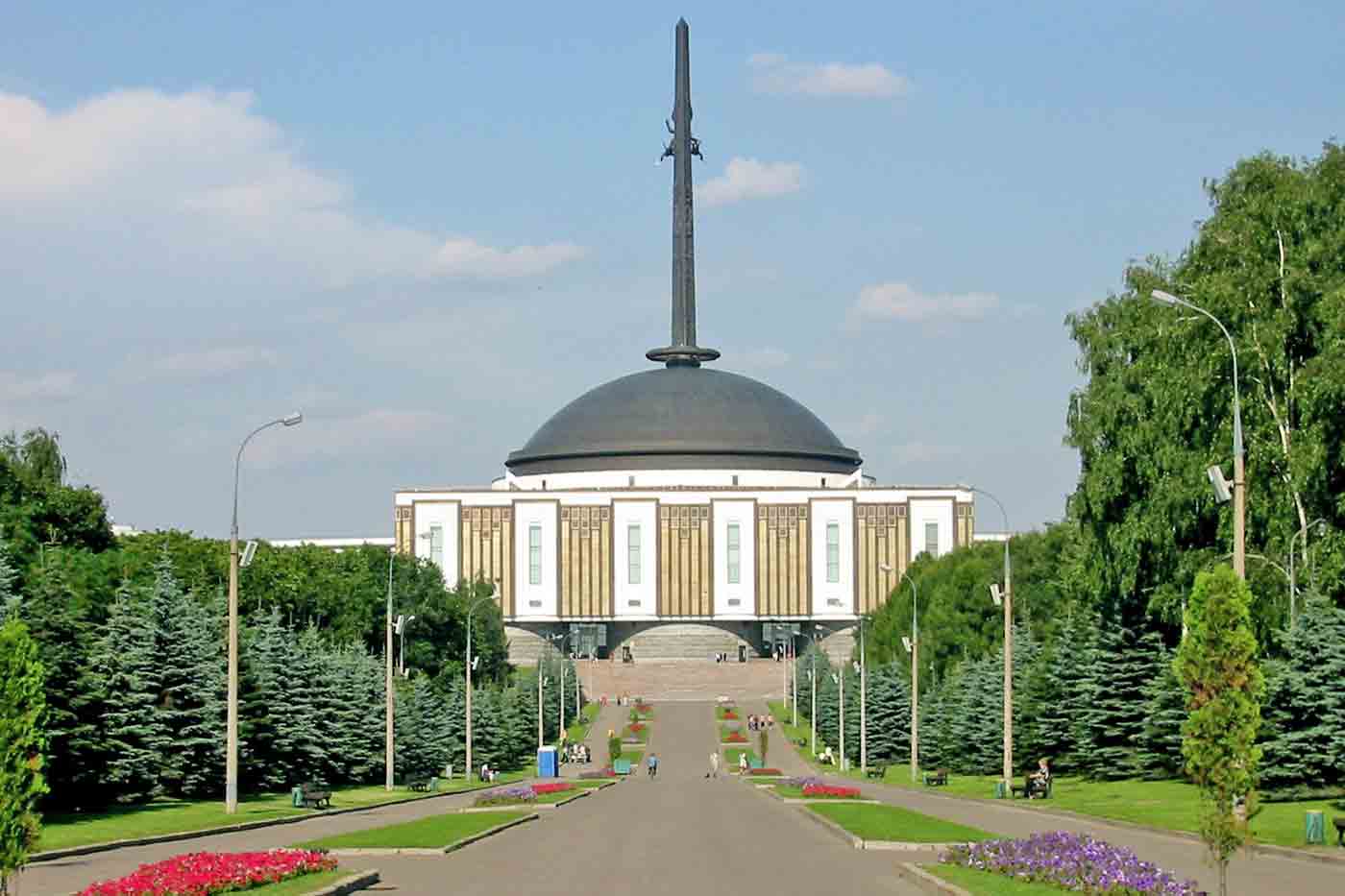
3. Novodevichy Convent
Also known as Bogoroditse Smolensky Monastery, this monastery has history going back to the 17th century. It is among Moscow tourist spots with incredible architecture and design. You will need an hour for this Monastery.
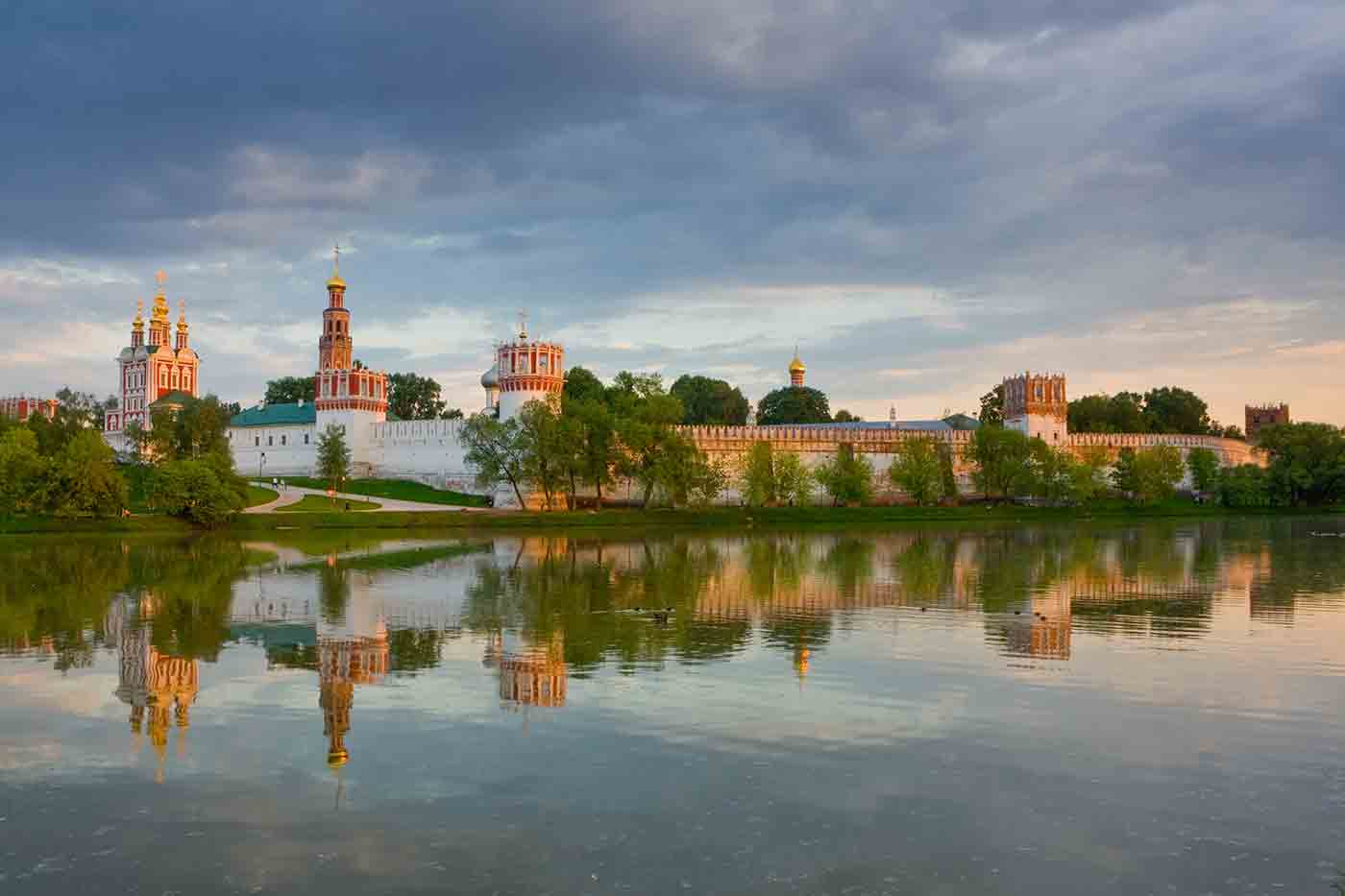
4. Gorky Park
This park is the venue for several activities in Moscow. It is also one of the very first parks established in the city and is named after Maxim Gorky, a prominent writer and political activist. You will need 20 to 30 minutes for this park.

5. Garage Museum of Contemporary Art
This museum is dedicated to modern, abstract and contemporary art. It is among the best places to go in Moscow for those who admire art. You will need about an hour for this art gallery.

6. Tretyakov Gallery
This gallery is dedicated to works by Russian from 10th to 19th century. You will need about an hour to explore this gallery.
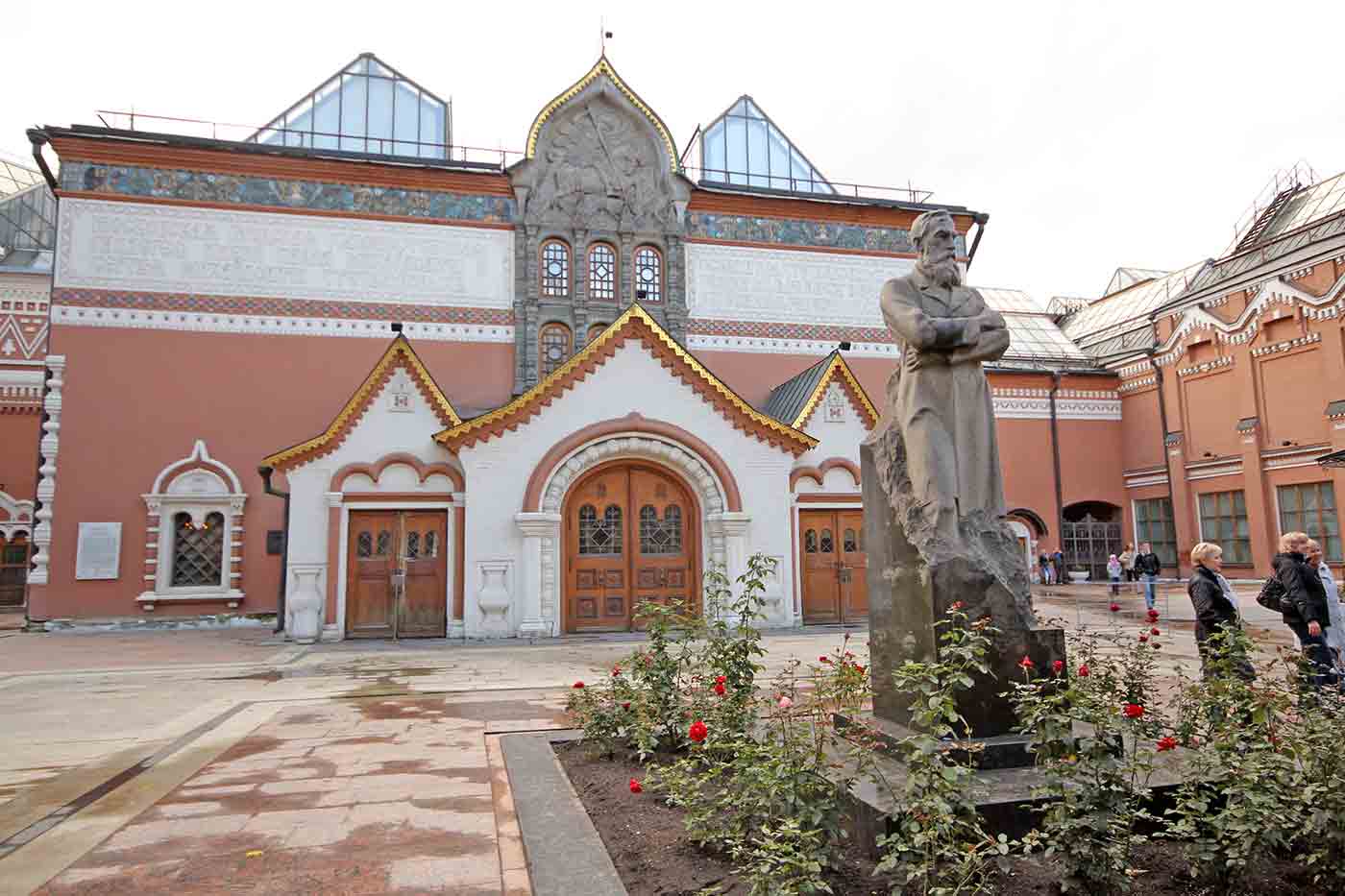
7. Aptekarskiy Ogorod Botanical Garden (Apothecary Garden)
This is the oldest botanical garden in the country. It was founded in 1706 under the reign of Peter the Great. You will need about an hour for these Botanical Gardens.
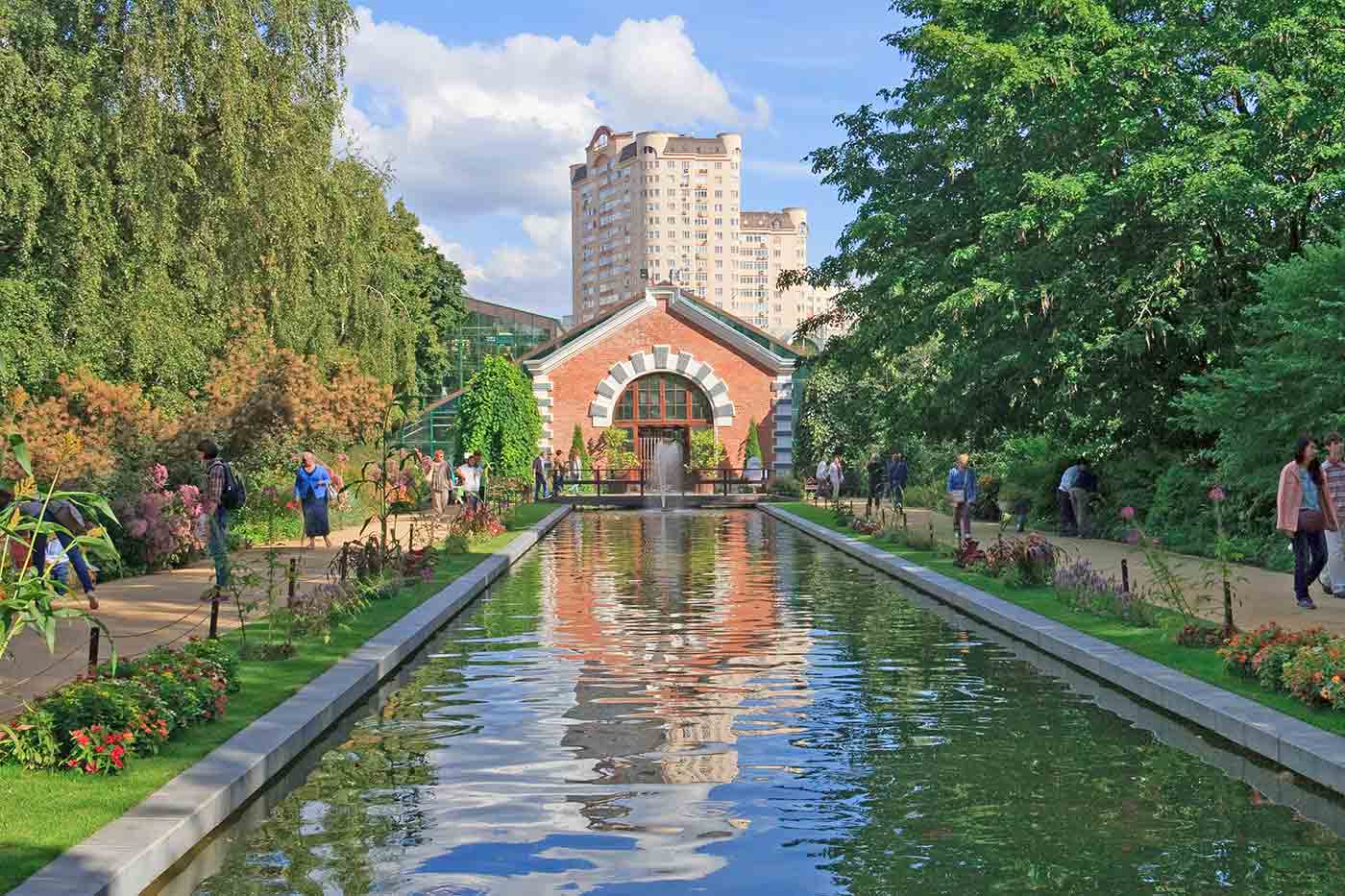
8. Moscow Museum of Modern Art
This museum is dedicated to 20th century paintings, sculptures and graphics. The collection features works by both Russian and foreign artists. It is among top places of interest in Moscow. It will take you an hour to explore this museum.
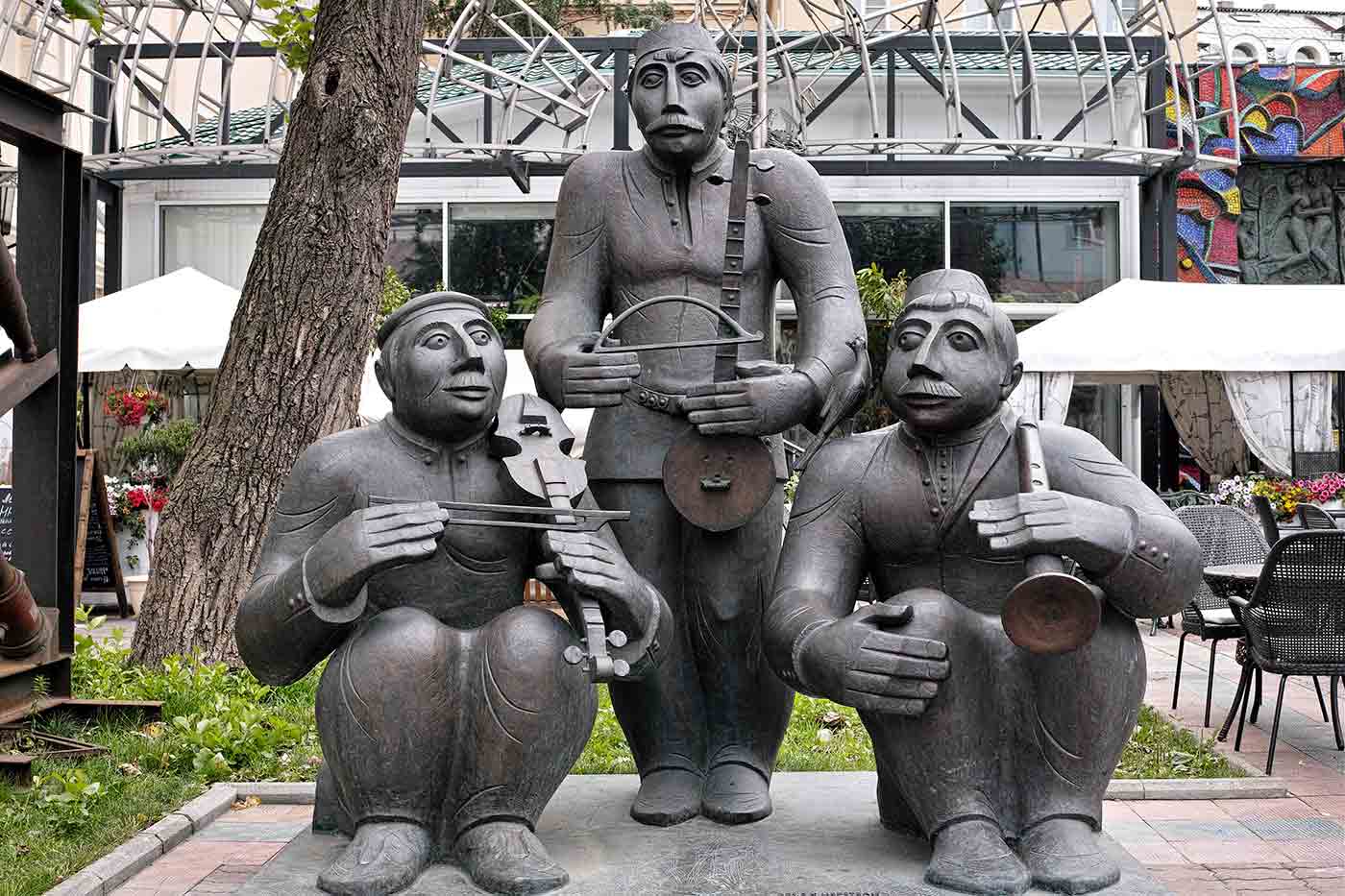
1. VDNkH (Exhibition of Achievements of National Economy)
Also known as Vystavka Dostizheniy Narodnogo Khozyaystva, it is an exhibition venue and an amusement park where people come for fun things to do in Moscow. You would need about an hour for VDNkH.
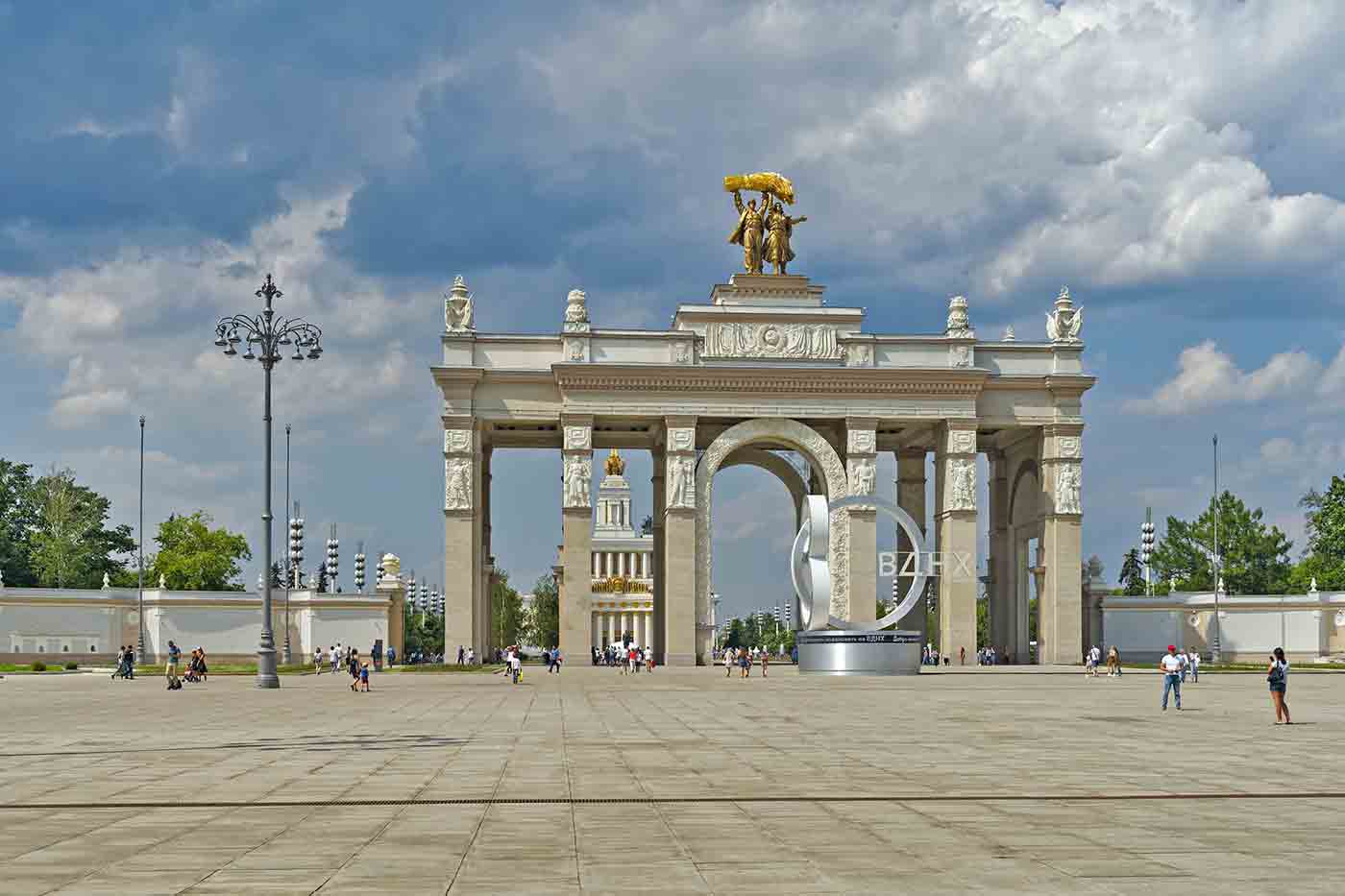
2. Memorial Museum of Cosmonautics
The name of the museum says it all, it is a museum dedicated to Russia’s endeavors in space. If you are a fan of space travel, this museum is a Moscow must see. You will need about 2 hours to explore this museum.

3. Ostankino Television Tower
This Radio and Television tower is the tallest free-standing structure in all of Europe. It is one of the best places for Moscow sightseeing. You will need about hour for this tower.
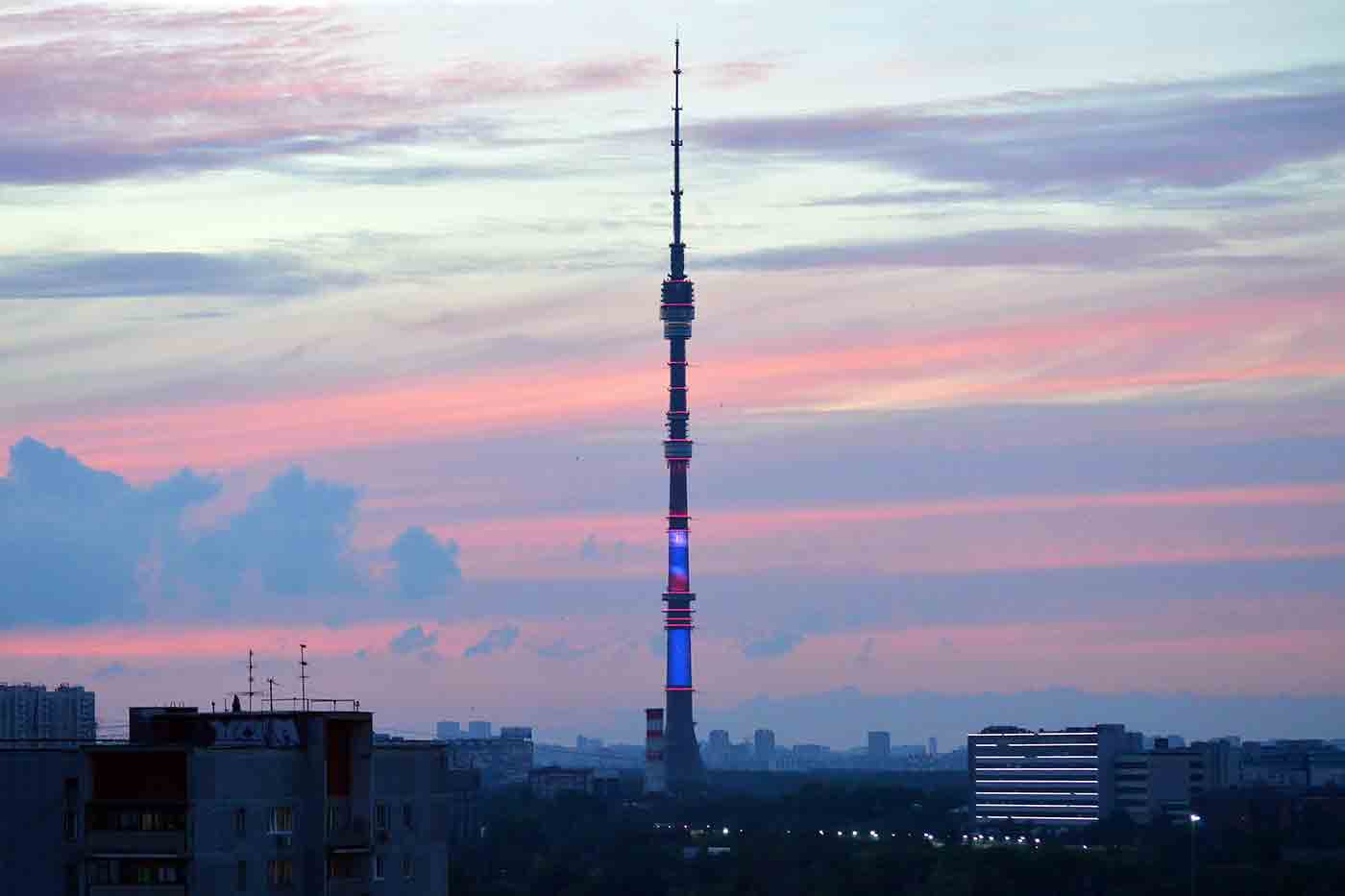
4. Jewish Museum and Tolerance Center
This is the largest Jewish museum in the entire world. The museum explores the history of Russia with Jews. It is among under appreciated Moscow tourist attractions and will require an hours of your time.

5. Museum of Soviet Arcade Machines
This is among the best places to visit in Moscow for a nostalgia trip. The museum is dedicated to arcade games. It will take you an hour to explore this museum.

1. Cathedral of Christ the Saviour
This is the tallest orthodox christian church in the entire world. The construction of the monument completed in 1997. In terms of modern architecture, it is among top Moscow beautiful places. You would need 20 to 30 minutes for this church.
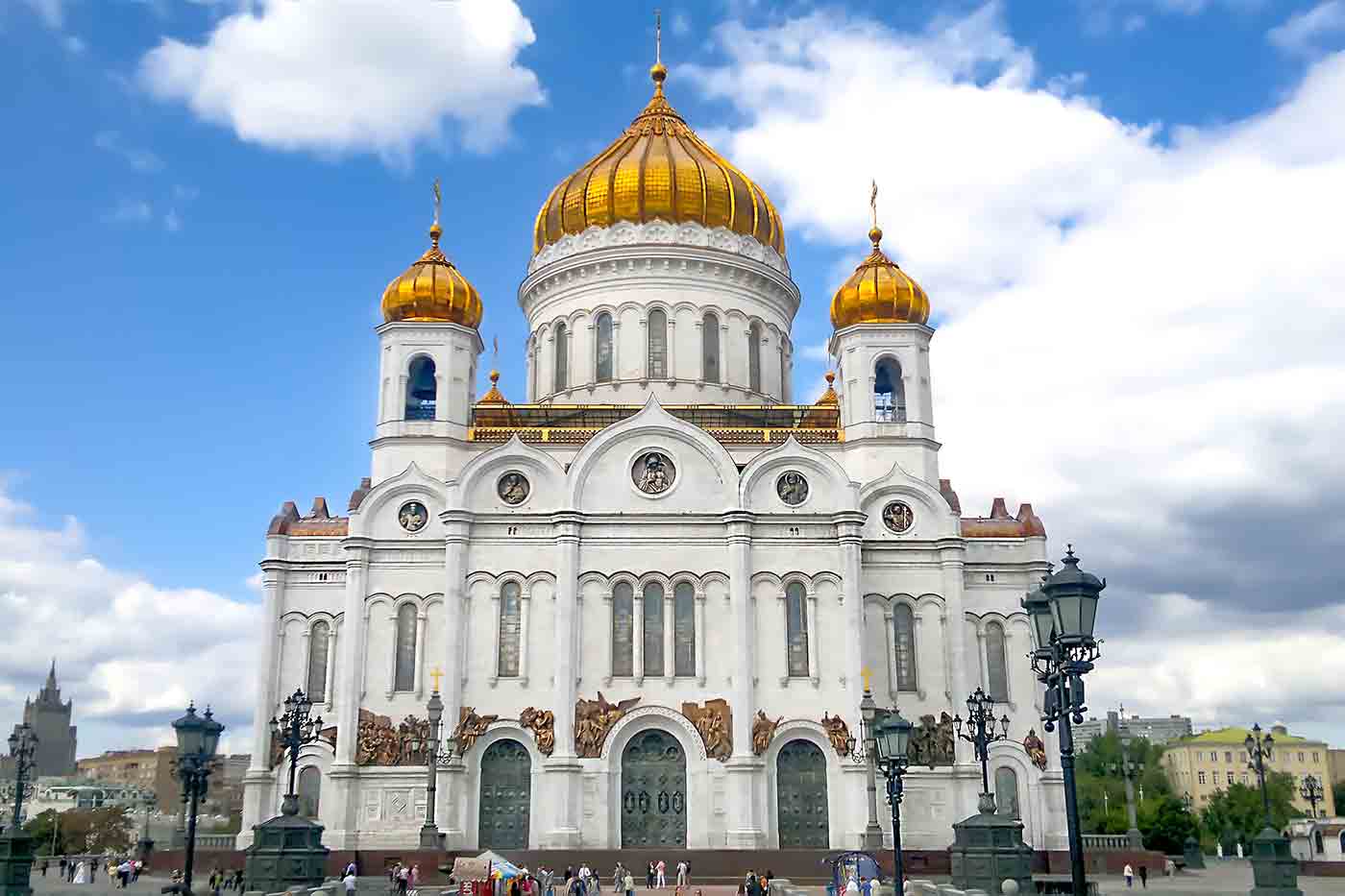
2. The Pushkin State Museum of Fine Arts
This art museum has the largest collection of European Art in Russia. It is named after Russian port Alexander Pushkin. You will need an hour for this Moscow attraction.
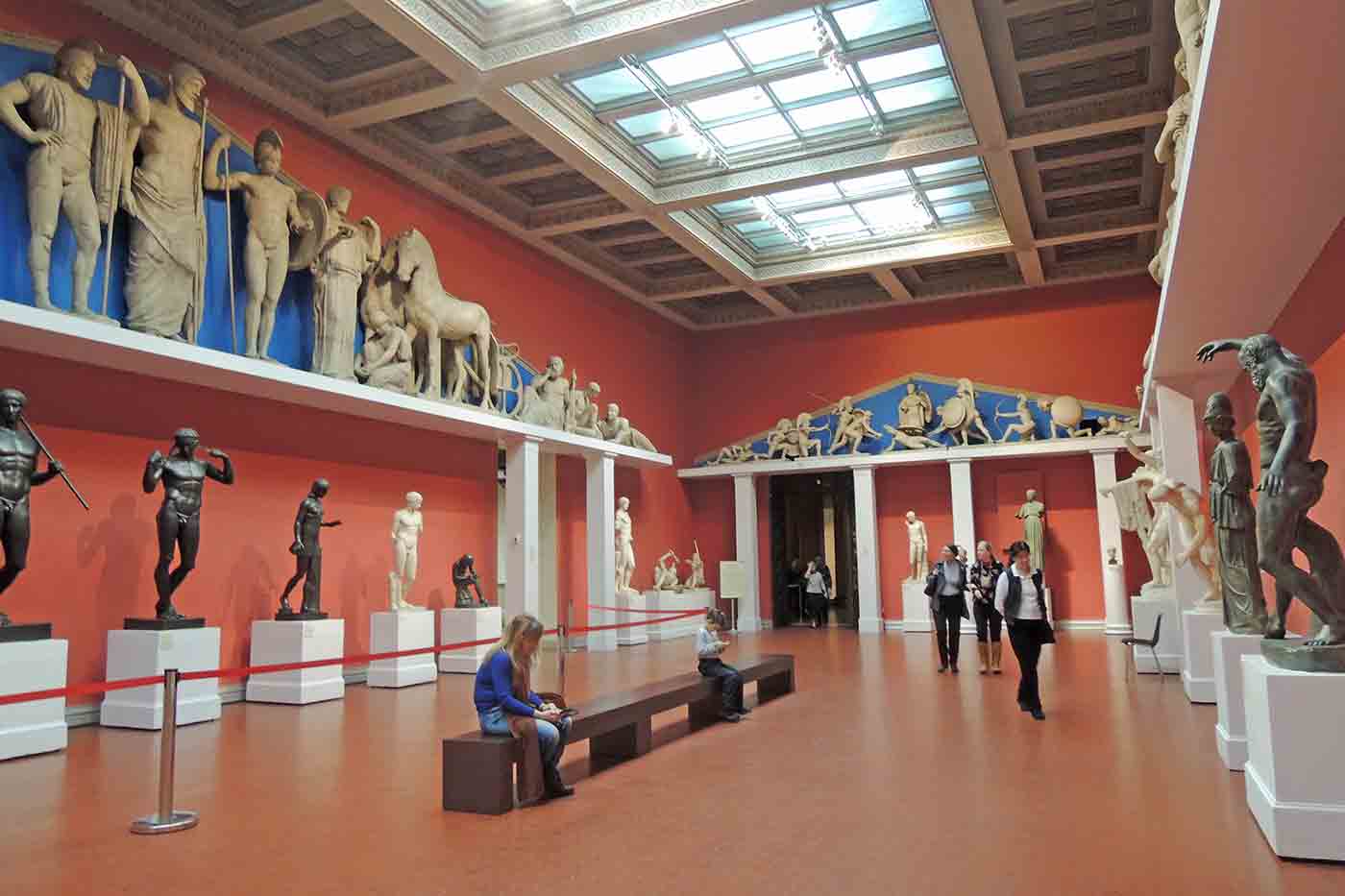
3. Moscow Planetarium
This one is for space enthusiasts to enjoy during Moscow travel. The museum is full of great exhibits concerning the cosmos and interactive exhibits. You will need about an hour for this planetarium.

4. Moscow Zoo
This is the largest zoo in the country with around 1,000 species of animals residing here. It is among best things to do in Moscow for families. It will take you 2 hours to explore it.
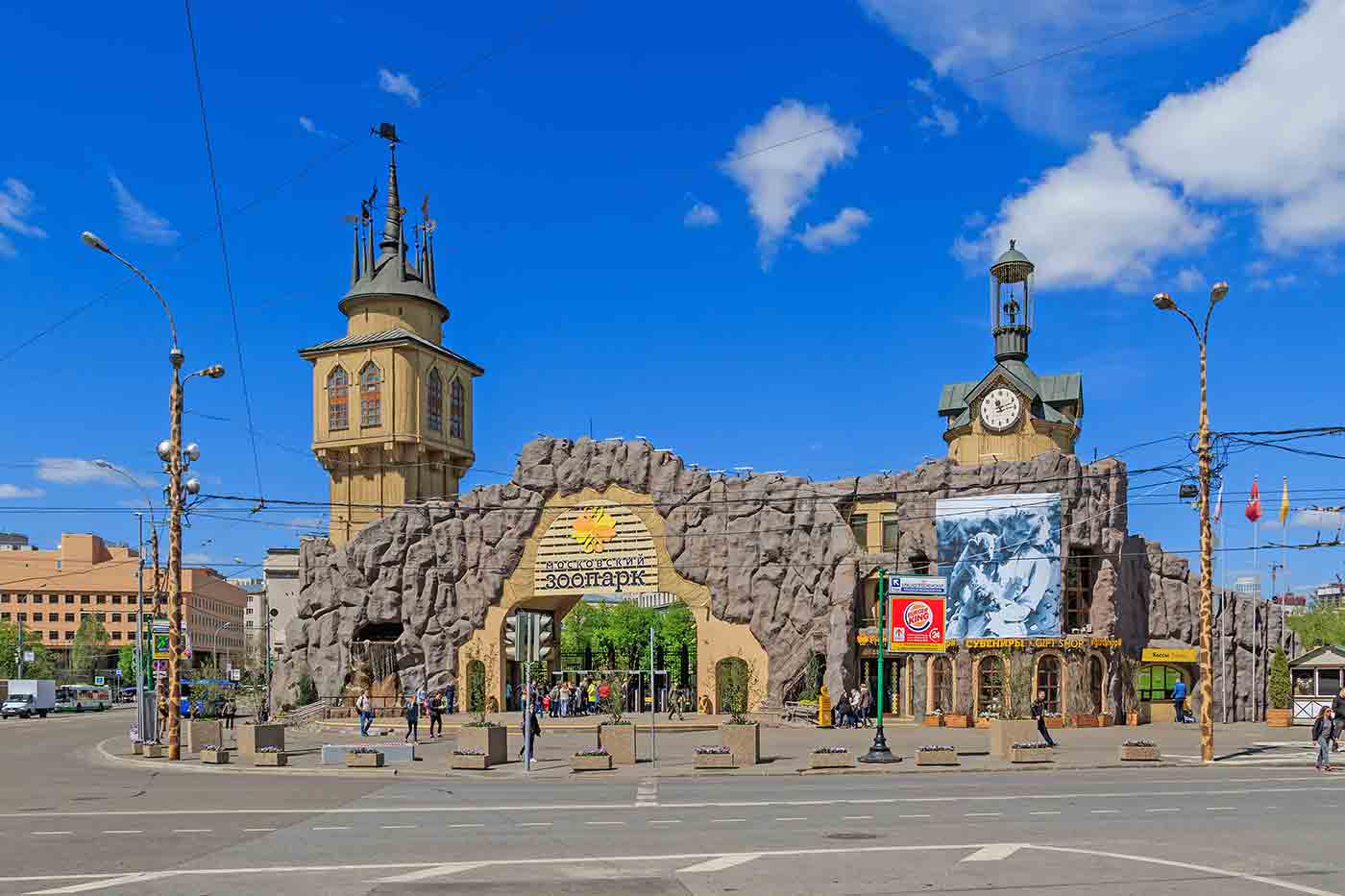
5. Mikhail Bulgakov Museum
This museum used to be the house of revered Russian writer Mikhail Afanasyevich Bulgakov. It depicts the life and work of this great writer. You would need 20 to 30 minutes for this house museum when you visit Moscow.

If you are looking for more top things to do in Moscow, check out the section below.
Things to do in moscow, monuments, museums & historical places to visit in moscow.
- St. Basil’s Cathedral
- The Moscow Kremlin
- Bolshoi Theatre
- The State Tretyakov Gallery
- The Pushkin State Museum of Fine Arts
- Gorky Central Park of Culture and Leisure
- Cathedral of Christ the Saviour
- Lenin’s Mausoleum
- State Historical Museum
- The Garage Museum of Contemporary Art
- Novodevichy Convent
- Kolomenskoye
- Museum of Cosmonautics
- Tsaritsyno Museum
- Moscow Museum of Modern Art
- Dormition Cathedral
- Armoury Chamber
- Multimedia Art Museum
- Grand Kremlin Palace
- Monument to Peter I
- Kuskovo Estate Museum
- Izmailovo Kremlin
- Muzeon Park of Arts
- Victory Museum
- Darwin Museum
- Jewish Museum and Tolerance Center
- New Tretyakov Gallery
- Ivan the Great Bell Tower
- Annunciation Cathedral
- Russian Impressionism Museum
- Gulag History Museum
- Museum Estate Arkhangelskoye
- Cathedral of Archangel
- Novodevichy Cemetery
- The State Museum of Oriental Art
- Amalaznyy Fond
- Spasskaya Bashnya Clock Tower
- Worker and Kolkhoz Statue
- Dvorets Tsarya Alekseya Mikhaylovicha Palace
- Kazan Cathedral
- National Center for Contemporary Art
- Polytechnical Museum
- The Moscow Planetarium
- State Pushkin Museum
- Schusev State Museum of Architecture
- Church of Ascension
- Battle of Borodino Museum
- Paleontologicheskiy Museum
- Central Armed Forces Museum
- Space Conqeurors Monument
- State Museum of Konstantin and Victor
- Moscow Cathedral Mosque
- Novospassky Monastery
- Donskoy Monastery
- Museum of Decorative Applied and Folk Arts
- Bakhrushin Theatre Museum
- State Museum of Modern Russian History
- The Museum of Moscow
- Izmaylovo Estate
- GES-2 Art Museum
- Tsar Cannon
- Gary Tatinsian Gallery
- Museum of Moscow
- Nouvelle Gallery Tretiakov
- Lumiere Brothers Center for Photography
- Museum of Soviet Arcade Games
- Tomb of the Unknown Soldier
- Tsentral’nyy Drevnerusskoy Kul’tury Museum
- Pushkin Monument
Nature & Wildlife Tourist Spots in Moscow
- Izmailovsky Park
- National Park Elk Island
- Serebryany Bor
- Shkolnoye Lake
- Beloye Lake
- Sokolniki Park
Entertainment & Leisure Tourist Spots in Moscow
- All Russian Exhibition Center
- Alexander Gardens
- Park Pobedy na Poklonnoy Gore
- Apothecary Garden
- Dream Island Amusement Park
- Neskuchuny Garden
- Park Izmaylovo
- Hermitage Garden
- Moscow Manege
- Sanduny Bathhouse
- Botanical Garden of the Russian Academy
Shopping in Moscow
- Arbat Street
- Stoleshnikov Lane
- Flacon Design Center
- TsUm Shopping Area
- Tverskaya Street
- Kitai Gorod Shopping District
- Okhotny Ryad Shopping Centre
- Izmailovo Market
- GUM Shopping Arcade
Beaches in Moscow
- Troparyovo Beach
- Levoberezhny Beach
- Meshcherskaya Recreation Area
- Rublyovo Beach
- Chyornoye Ozero
- Bolshoi Goroskoi Prud
Offbeat Places, Tours, & Adventure in Moscow
- Moscow River Cruise
- Ice Skating
Sightseeing in Moscow
- Ostankino Tower
- Tverskaya Tower
- Sparrow Hills
- Poklonnaya Hill
- Mercury City Tower
- Garden Ring
- Shukhov Tower
Food, Dining, Restaurants, & Street Food in Moscow
- Cafe Pushkin
- Lucky Izakaya Bar
- Zotman Pizza Pie
- Buba by Samosan
- Masters & Margaritas
- Simple Things
- White Rabbit
- Grand Cafe Dr. Zhivago
How to Reach Moscow?
There are 4 airports for Moscow travel namely Sheremetyevo International Airport, Domodedovo International Airport, Vnukovo International Airport, and Zhukovsky International Airport. Between these 4 airports, you can get direct flights from several major cities in Asia, Africa, Europe, Australia and North America. You have the option of bus and cabs to get around to places to visit in Moscow.
You get trains from several cities in Russia and Europe to visit Moscow including St. Petersburg, Berlin , Warsaw , Helsinki , Monaco, Paris , Ukraine, Tallinn , Riga , Brest, Belarus, Frankfurt , Vienna , Budapest and many more. There are frequent buses between Moscow connected with several cities in Europe.
If you plan to travel by road, there are so many major highways connecting to the city. There is basically a web of roads connecting to Moscow from all directions.
There are no passenger routes for Moscow travel. There are commercial ships traveling by Moscow canal through Baltic Sea.
Mustafa Natalwala
Mustafa is a content writer and digital marketing expert at WideWorldTrips.com His mainly interests are into travelling, photography, film-making
2 thoughts on “ 27 Tourist Places to Visit and Things to Do in Moscow in 4 Days Trip ”
Why Sokolniki park is missing? Or doesn’t it exist as before ? I used to roam inside it over fifty years ago ! May be now the forest has been consumed by the concrete edifices?
Thank you for updating us about this amazing place in Moscow. We have updated the article and included it in the Nature section of the article. But, as we have prepared the itinerary of palces based on popularity, we have not included Sokolniki Park in that section. You can find it by scrolling down to the Nature section. Thank You once again for helping us update our article.
Comments are closed.

IMAGES
COMMENTS
A further 5 snapshots are examined briefly to illustrate the breadth and importance of wildlife tourism across Asia and the Pacific. In order to reflect the diversity in both geographical scope and market segment of the sector, a variety of operations were selected including examples from the private sector, the accommodation and transport ...
3. Kanha National Park, India. The famous masterpiece, The Jungle Book, authored by Rudyard Kipling was created after this magnificent park. The author was inspired by its evergreen thick forests, meadows, ravines, and Kanha gorges. It is touted as the most picture-perfect wildlife park in Asia.
Asia and the Pacific. Wildlife tourism refers to the observation and interaction with local animal and plant life in their natural habitats. It encompasses segments such as eco-tourism, safari tours and mountain tourism among others. Wildlife watching tourism occurs mainly in protected areas. Nature, national parks and wildlife are considered ...
UN's World Tourism Organisation last year commissioned Professor Noel Scott (who subcontracted WTA chair Dr Ronda Green as co-editor, with UNWTO's approval) to put together a report on good practice examples of sustainable wildlife tourism in Asia and the Pacific. After many months that report is now available as a free downloadable pdf. Dr Scott
Build your ideal Asia trip. Call 1.406.541.2677. Take a river cruise through different parts of Asia where you can view incredible animals such as bengal tigers, sun bears, orangutans, and elephants during a wildlife and safari exploration tour. Customize your trip to include other activities such as village visits, local market visits ...
The answer is wildlife tours, where meeting animals in their natural habitats is an adventure! Here are some of the best wildlife tours for when you're in Asia: 1. Okinawa Whale Watching Tour by Sesoko Beach Marine Club. Embark on a wildlife tour of Okinawa 's waters to spot the majestic humpback whales! There's a 98% chance you'll see ...
Build your ideal Asia trip. Call 1.406.541.2677. Discover a hidden world of wildlife diversity on an Asia Wildlife Viewing Tour this 2024 or 2025. From tigers and elephants to monkeys and birds, you're guaranteed to encounter Asia's native species on these 98 tours. Trek through the jungle, cruise the rivers, or observe from a safe distance ...
10 best Asia wildlife tour packages. Compiled by. Steff Asia travel expert at TourRadar. India Tiger Safari Tour. Golden Triangle Tour With Ranthambhore National Park - ALL INCLUSIVE. India Wildlife with Taj Mahal Tour. India's Golden Triangle With Kolkata & Darjeeling 12 Days. Wild About Sri Lanka - 10 days. Grand Tour Of Sri Lanka.
Asia wildlife holidays are as varied as the landscapes and habitats available on the continent, making it one of the most beautiful places in the world to spot animals. Explore the guides below to find out more about the wildlife tourism available in Asia.
Sabrine Ong picks out the top 5 places to see wildlife in Asia. (Text by Sabrine Ong. Photo by Shutterstock) 1. YALA NATIONAL PARK, SRI LANKA. Yala is the second largest national park in Sri Lanka, home to Panthera pardus kotiya, a native leopard. The 130,000 hectares of diverse landscape consists of forestry, grasslands and lagoons.
Ten hectares of rainforest here contain more tree species than all of North America; there are more bird species than in Europe, and as many mammals as in Australia. Find Out More. Bako National Park. Danum Valley. Deramakot Forest Reserve. Gomantong Caves & Forest Reserve. View 11 wildlife locations in Borneo.
Kui Buri National Park - Thailand. The vast Kuri Buri National Park is located in Southern Thailand and is known for its dense forests, limestone cliffs, hidden lakes, and deep valleys. This pristine habitat holds an array of diverse wildlife ranging from, Asian elephant, leopard, golden jackal, and the Langur primates.
Tigers in India. Approximately 100 endangered tigers roam the brushy woodland of India's Ranthambhore National Park, a reserve in colorful Rajasthan. By far the best way to catch a life-changing glimpse of one in the wild is to join a Micato Safaris trip through India, While you may see pepper growing in Kerala or ride a boat on Udaipur's ...
All Asia Nature & Wildlife Tours can be privately customized & designed to suit your personal desire. Blessed with plenty of wildlife attractions (e.g., Kalimantan Island, Sumatra Island, Sabah, Sarawak, Danjugan and Bohol), a wide variety of terrain and the stunning landscape, Asia is a truly home to the most wonderful wildlife which you won ...
Asia is a popular destination for wildlife tourism. From the majestic Asian elephant to the mighty Indonesian Komodo dragon, from the iconic Bornean orangutan to the regal Philippine eagle, the continent is full of breathtaking wildlife encounters that draw tourists from around the world. And yet,
It has as major focus on wildlife conservation in Africa and Asia and the Pacific as wildlife acquires a global dimension in these parts of the world. The initiative includes approaches such as capacity building, media engagement, research and talent development and addresses multiple stakeholders like governments, tourism administrations ...
Table of Contents. Best Places to See Wildlife in Asia. Blue Whale Watching in Mirissa, Sri Lanka. A Jungle Safari in Karnataka, India. The Great Monkey Attack of Angkor Wat, Cambodia. Pygmy Elephants in Borneo. Tarsiers and Black Macaques in Sulawesi, Indonesia. Swimming with Turtles in Apo Island, Philippines.
One of the smallest national parks in Malaysia, this natural wonder on an island is home to diverse wildlife, including black giant squirrel, smooth-coated otter, lesser mouse-deer, pangolin, reticulated python and numerous bird species like the white-bellied sea eagle, white-throated kingfisher, white-rumped shama and emerald dove.
Visit the Prek Toal Bird Sanctuary for a chance of spotting these fascinating creatures. Snakebird spotted at Tonle Sap Lake, Cambodia. 4. Meet the elephants in Cambodia & Laos. One of the most exciting wildlife experiences to enjoy in Southeast Asia is a meeting with the largest land animal in the world: the elephant.
A four-year-old human child with spikes pressing into his flesh would express pain by screaming. A four-year-old elephant just stands there in the rain, her leg jerking in the air. Of all the ...
Wildlife In Ujung Kulon National Park Aside from Ujung Kulon's epic geography, plant life, and islands, the wildlife is the main draw for those visiting this park.
From wildlife reserves to national parks and protected areas, sustainable conservation efforts play a vital role in maintaining the integrity and beauty of the region's natural landscapes. Outdoor activities and adventures. North Asia offers an array of thrilling outdoor activities and adventures set amidst its stunning natural landscapes.
Another endangered wildlife species is the Amur Tigers. There are less than 500 Amur Tigers left in the whole world, and from these 500, a huge number of them are placed in the safari in Russia. These two types of tigers are considered to be the main attraction for people towards the Safari Park in Russia.
SEPANG, 22 August 2024 - AirAsia, in collaboration with the Singapore Tourism Board (STB), Gardens by the Bay and Mandai Wildlife Group unveiled the 'Love, Singapore' aircraft livery today.The launch comes as part of a joint campaign to promote inbound travel to Singapore from visitors in Malaysia, Thailand and Indonesia, riding on the year-end travel peak in the region.
Wildlife Tourism Conferences in Moscow 2024/2025/2026 will bring speakers from Asia, Africa, North America, South America, Antarctica, Europe, and Australia. Wildlife Tourism conference listings are indexed in scientific databases like Google Scholar, Semantic Scholar, Zenedo, OpenAIRE, EBSCO, BASE, WorldCAT, Sherpa/RoMEO , Compendex ...
The incident. Shin Min Daily News reported that the group was visiting temples in the area, as part of a 10-day tour in Southeast Asia arranged by a Chinese travel agency.. A person from the tour ...
5. Saint Basil's Cathedral. This cathedral is one of the most beautiful things to see in Moscow. It is an iconic monument which is known around the world. It was built in 1555 and was built under the reign of the very first Czar of India. You will need about an hour to explore this cathedral. 6.
Hainan Airlines successfully flew the initial flight of its new Haikou-Moscow route on 26th August, taking off from the Haikou Melian International Airport at 02.38 local time.
Together with the Singapore Tourism Board (STB), Gardens by the Bay, and the Mandai Wildlife Group, AirAsia presented its new "Love, Singapore" aircraft livery. The launch comes as part of a ...
Indian Prime Minister Narendra Modi will travel to Ukraine, according to the Ministry of External Affairs, weeks after he made his first trip to Moscow since Russia launched its full scale invasion.